Patch News – June 2024
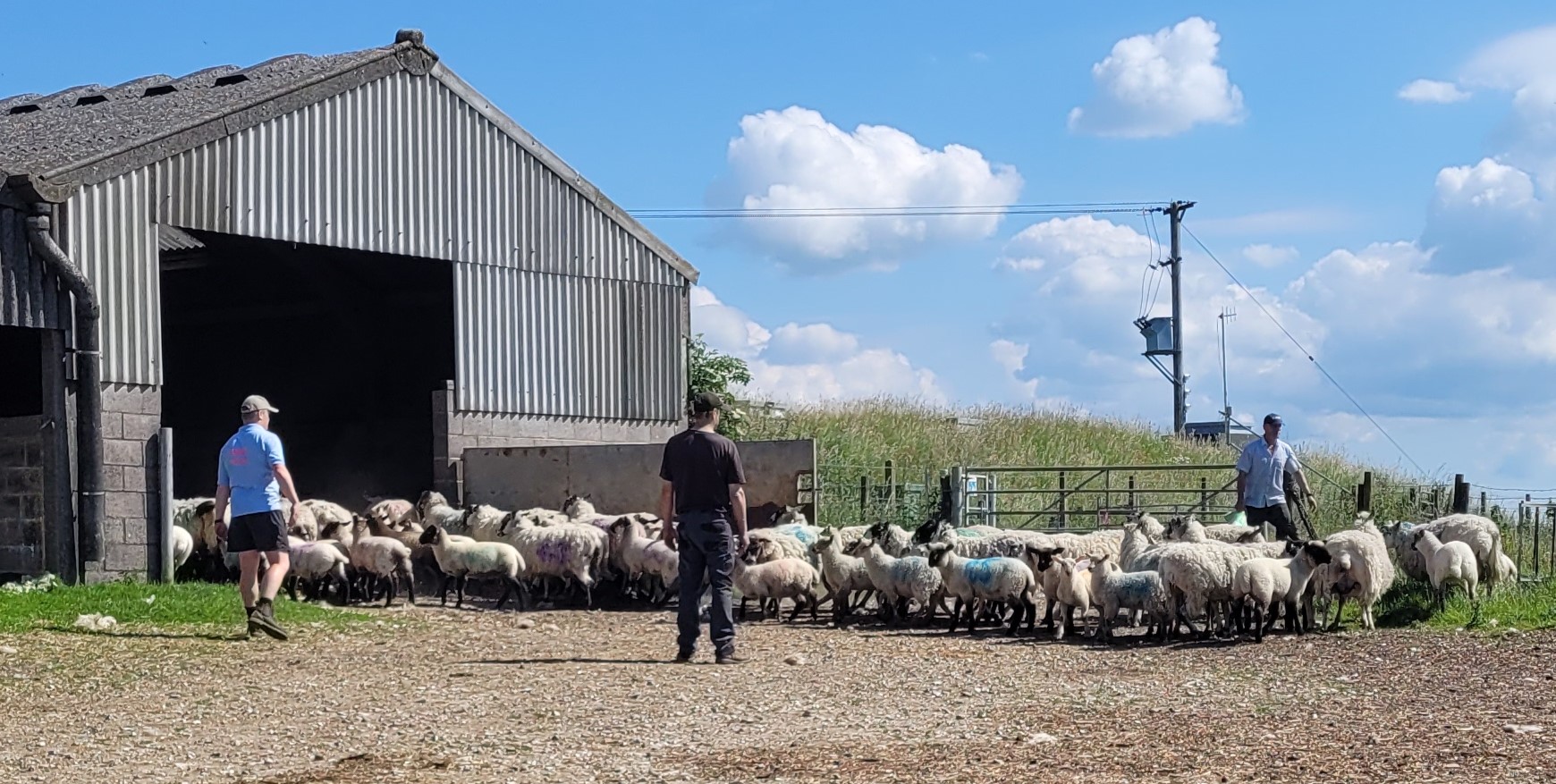
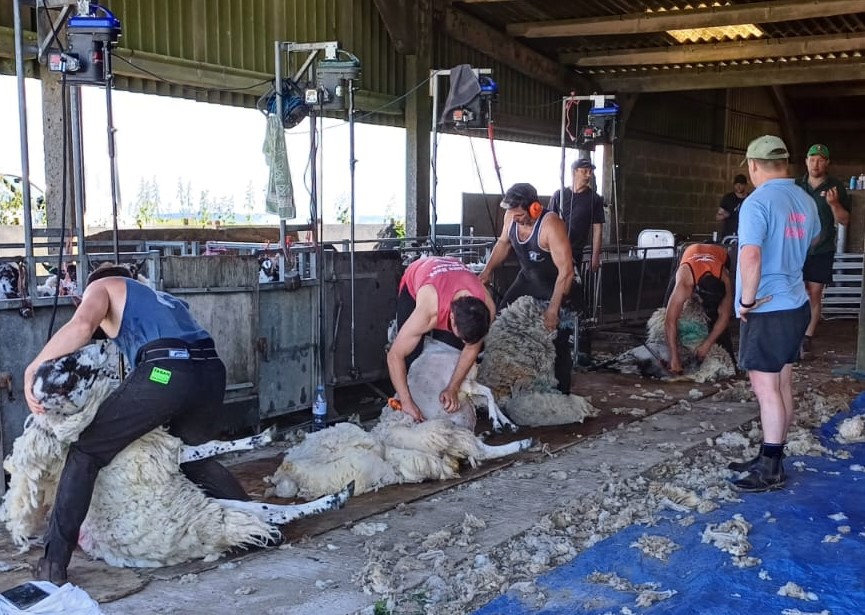 George explained that they were shearing the ewes so were separating them from their lambs, something neither the ewes or the lambs were happy about. Once shorn the ewes were returned to their lambs in ‘our’ field. It all made an entertaining start to the session!
Dougal has written to make a very important point about safety with our electric models:
Can I ask that people are careful to keep their appendages out of the way of the propeller whenever a plane has its main battery connected? This is especially an issue if the Tx doesn’t have a throttle kill switch. I’ve recently seen people holding their planes by the nose while the power system is “live”, and it only takes an accidental knock of the throttle stick for the thing to become a potent finger-chopper. Electric motors are even worse than IC in this respect, because:
1. They can burst into life unexpectedly.
2. Electric flight propellers are normally sharper than IC ones, and
3. IC motors sometimes stop once they’ve sliced enough flesh. Electric ones don’t.
This photo might make you think about the kind of situation we’re putting ourselves in:
George explained that they were shearing the ewes so were separating them from their lambs, something neither the ewes or the lambs were happy about. Once shorn the ewes were returned to their lambs in ‘our’ field. It all made an entertaining start to the session!
Dougal has written to make a very important point about safety with our electric models:
Can I ask that people are careful to keep their appendages out of the way of the propeller whenever a plane has its main battery connected? This is especially an issue if the Tx doesn’t have a throttle kill switch. I’ve recently seen people holding their planes by the nose while the power system is “live”, and it only takes an accidental knock of the throttle stick for the thing to become a potent finger-chopper. Electric motors are even worse than IC in this respect, because:
1. They can burst into life unexpectedly.
2. Electric flight propellers are normally sharper than IC ones, and
3. IC motors sometimes stop once they’ve sliced enough flesh. Electric ones don’t.
This photo might make you think about the kind of situation we’re putting ourselves in:
 As Dougal & I (Mark & Andy) are the club BMFA Examiners we have a responsibility to try to keep members safe but ultimately it’s down to individuals to do things correctly.
There have been a few incidents in the past when members have had unexpected motor starts, sometimes causing injuries, we should do our best to prevent any future issues. I admit to relying on the throttle kill switch too much and will change my habits in future.
I started off the month badly by writing off my Multiplex FunGlider! It’s had hundreds of flights over many years and has had its share of crashes but this was one crash too many. I’d love to say that something broke in the air, or the radio failed, but I must admit that it was pilot error. I’ve always known that the model would loop tightly but needed a lot more space to bunt (outside loop) so it’s something I’ve rarely done. But I had a bit of brain fade and decided to bunt at a fairly low level. When the model was heading vertically down I thought it wasn’t going to make it so I switched from full down elevator to full up elevator.
As Dougal & I (Mark & Andy) are the club BMFA Examiners we have a responsibility to try to keep members safe but ultimately it’s down to individuals to do things correctly.
There have been a few incidents in the past when members have had unexpected motor starts, sometimes causing injuries, we should do our best to prevent any future issues. I admit to relying on the throttle kill switch too much and will change my habits in future.
I started off the month badly by writing off my Multiplex FunGlider! It’s had hundreds of flights over many years and has had its share of crashes but this was one crash too many. I’d love to say that something broke in the air, or the radio failed, but I must admit that it was pilot error. I’ve always known that the model would loop tightly but needed a lot more space to bunt (outside loop) so it’s something I’ve rarely done. But I had a bit of brain fade and decided to bunt at a fairly low level. When the model was heading vertically down I thought it wasn’t going to make it so I switched from full down elevator to full up elevator.
 Big mistake! It wasn’t even close and hit the ground hard. This time is was past repairing so the radio and powertrain have been removed and the remainder retired to the bin.
In June two prospective new members come to fly with us, the first being John Sheehy.
John arrived on a push bike with a trailer for the model, I’m pretty sure that’s a PAM first!
The model was a small foamie, a ZOHD Drift which is an 877mm wingspan electric glider.
Big mistake! It wasn’t even close and hit the ground hard. This time is was past repairing so the radio and powertrain have been removed and the remainder retired to the bin.
In June two prospective new members come to fly with us, the first being John Sheehy.
John arrived on a push bike with a trailer for the model, I’m pretty sure that’s a PAM first!
The model was a small foamie, a ZOHD Drift which is an 877mm wingspan electric glider.  The Drift can be bought in various configurations and John’s is the PNP version which comes with a Kopilot gyro and even a small FPV unit in the nose. The Kopilot gyro is interesting as it has GPS so as well as having the usual stabilisation the pilot can switch into Return to Home mode if the plane gets too far away. When activated the RTH function will steer the model back to the launch point at a height of 35 metres and when it has come back you simply switch back to stabilisation mode and carry on flying. John said he’d been flying the Drift OK with the stabilisation turned on but wanted to learn to fly with it turned off. So at our field I launched the Drift and John flew it with stabilisation on and he flew a couple of circuits with no problems. But then he switched stabilisation off and the Drift promptly dived into the ground. After a few minutes with a hot glue gun we tried again. This time John launched it and I flew the Drift with stabilisation turned off.
The Drift can be bought in various configurations and John’s is the PNP version which comes with a Kopilot gyro and even a small FPV unit in the nose. The Kopilot gyro is interesting as it has GPS so as well as having the usual stabilisation the pilot can switch into Return to Home mode if the plane gets too far away. When activated the RTH function will steer the model back to the launch point at a height of 35 metres and when it has come back you simply switch back to stabilisation mode and carry on flying. John said he’d been flying the Drift OK with the stabilisation turned on but wanted to learn to fly with it turned off. So at our field I launched the Drift and John flew it with stabilisation on and he flew a couple of circuits with no problems. But then he switched stabilisation off and the Drift promptly dived into the ground. After a few minutes with a hot glue gun we tried again. This time John launched it and I flew the Drift with stabilisation turned off. 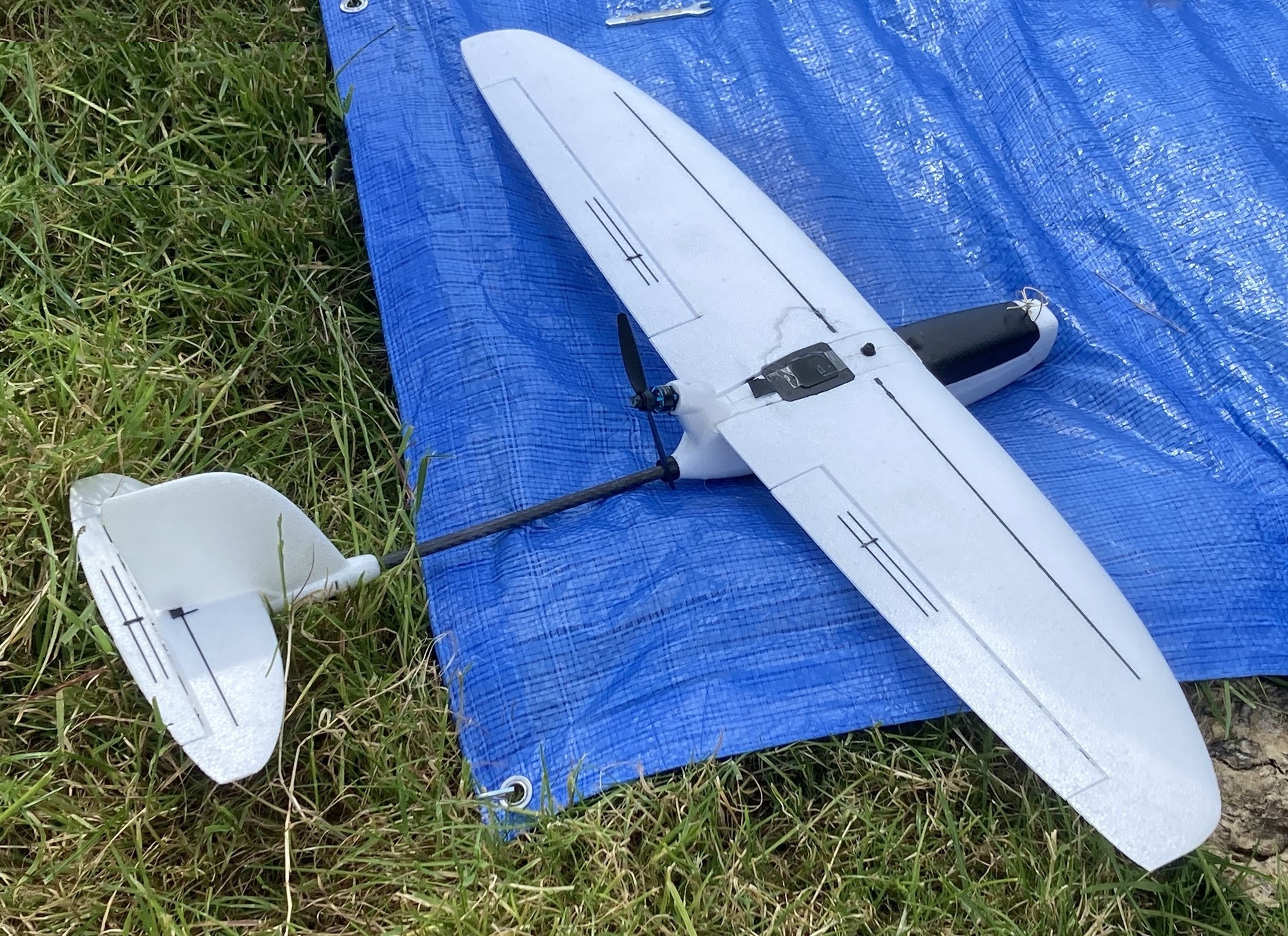 The first few seconds were ‘interesting’ as the plane wanted to dive badly but once I’d trimmed it out it flew fine. I gave the transmitter back to John who flew it for a little while but eventually crashed with minor damage. I couldn’t make the next flying session but 1066 tells me that John flew a HobbyKing Bixler and both John and the Bixler flew well.
The first few seconds were ‘interesting’ as the plane wanted to dive badly but once I’d trimmed it out it flew fine. I gave the transmitter back to John who flew it for a little while but eventually crashed with minor damage. I couldn’t make the next flying session but 1066 tells me that John flew a HobbyKing Bixler and both John and the Bixler flew well.

 John has now completed three visits so is eligible for membership if he wishes to join.
The second prospective new member was Patrick Beagles who brought along a Durafly Tundra to fly, I think it’s the V2 version, the same as the one that Mini-Mike flies.
John has now completed three visits so is eligible for membership if he wishes to join.
The second prospective new member was Patrick Beagles who brought along a Durafly Tundra to fly, I think it’s the V2 version, the same as the one that Mini-Mike flies.
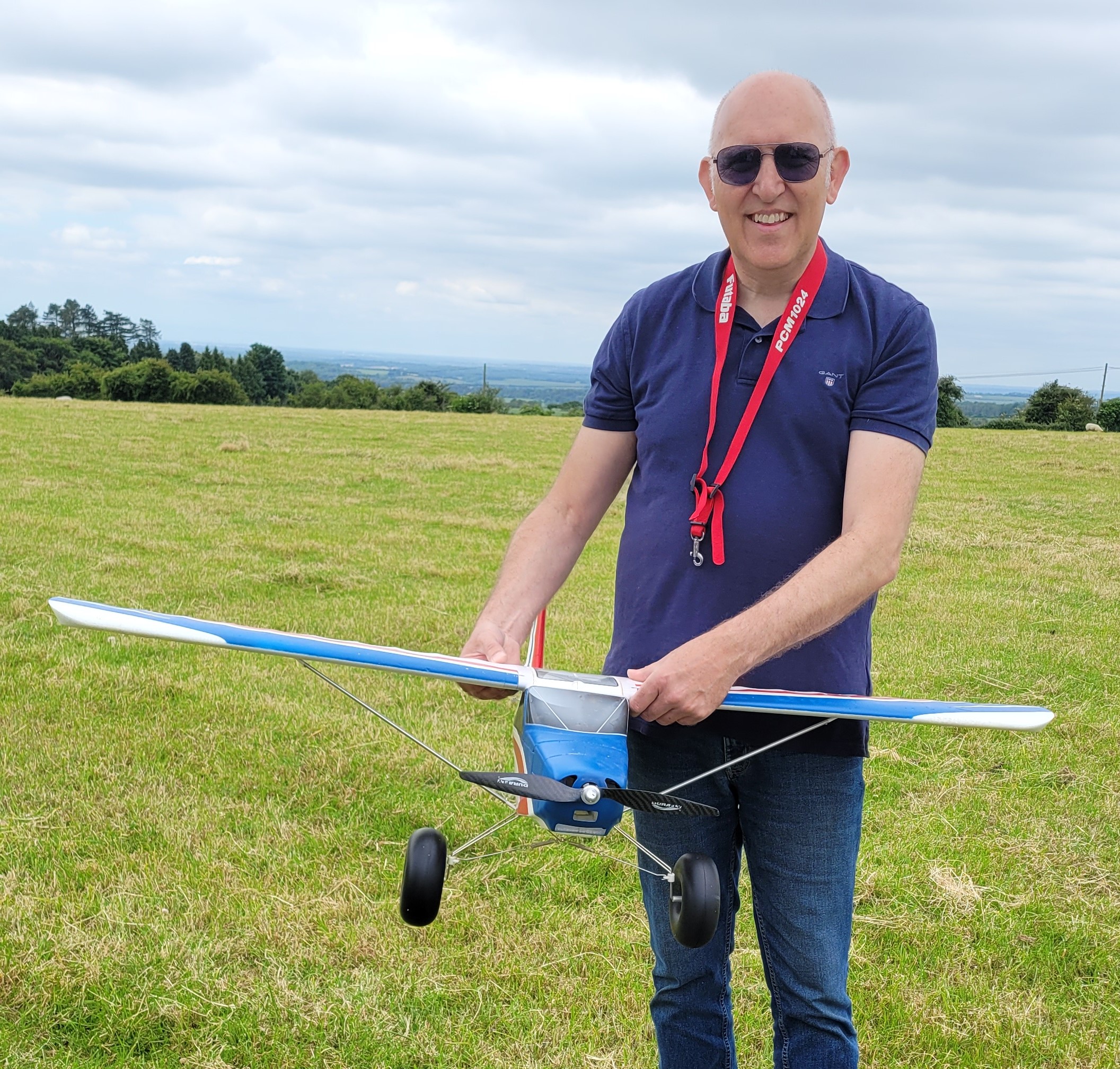
 Patrick has done quite a lot of RC flying in the past but hasn’t flown for around fifteen years so is a bit on the rusty side. Dougal Entendre took Patrick under his wing and did the Tundra take-off and landings but Patrick handled the rest of the flying with no problems.
Our Chairman Gordon Bennett had a birthday in June and brought along cakes for us all.
Patrick has done quite a lot of RC flying in the past but hasn’t flown for around fifteen years so is a bit on the rusty side. Dougal Entendre took Patrick under his wing and did the Tundra take-off and landings but Patrick handled the rest of the flying with no problems.
Our Chairman Gordon Bennett had a birthday in June and brought along cakes for us all.  They were individual carrot cakes that had been lovingly made by his step-daughter and very nice they were too. It was good that Gordon did the decent thing by bringing cakes, unlike someone who gave broken promises of cakes in May, but I won’t mention 1066…
As I reported in Patch News last month Woody has sold me his XFly T-7A Red Hawk having found it a bit of a handful and deciding he needed something a little easier to fly.
They were individual carrot cakes that had been lovingly made by his step-daughter and very nice they were too. It was good that Gordon did the decent thing by bringing cakes, unlike someone who gave broken promises of cakes in May, but I won’t mention 1066…
As I reported in Patch News last month Woody has sold me his XFly T-7A Red Hawk having found it a bit of a handful and deciding he needed something a little easier to fly.
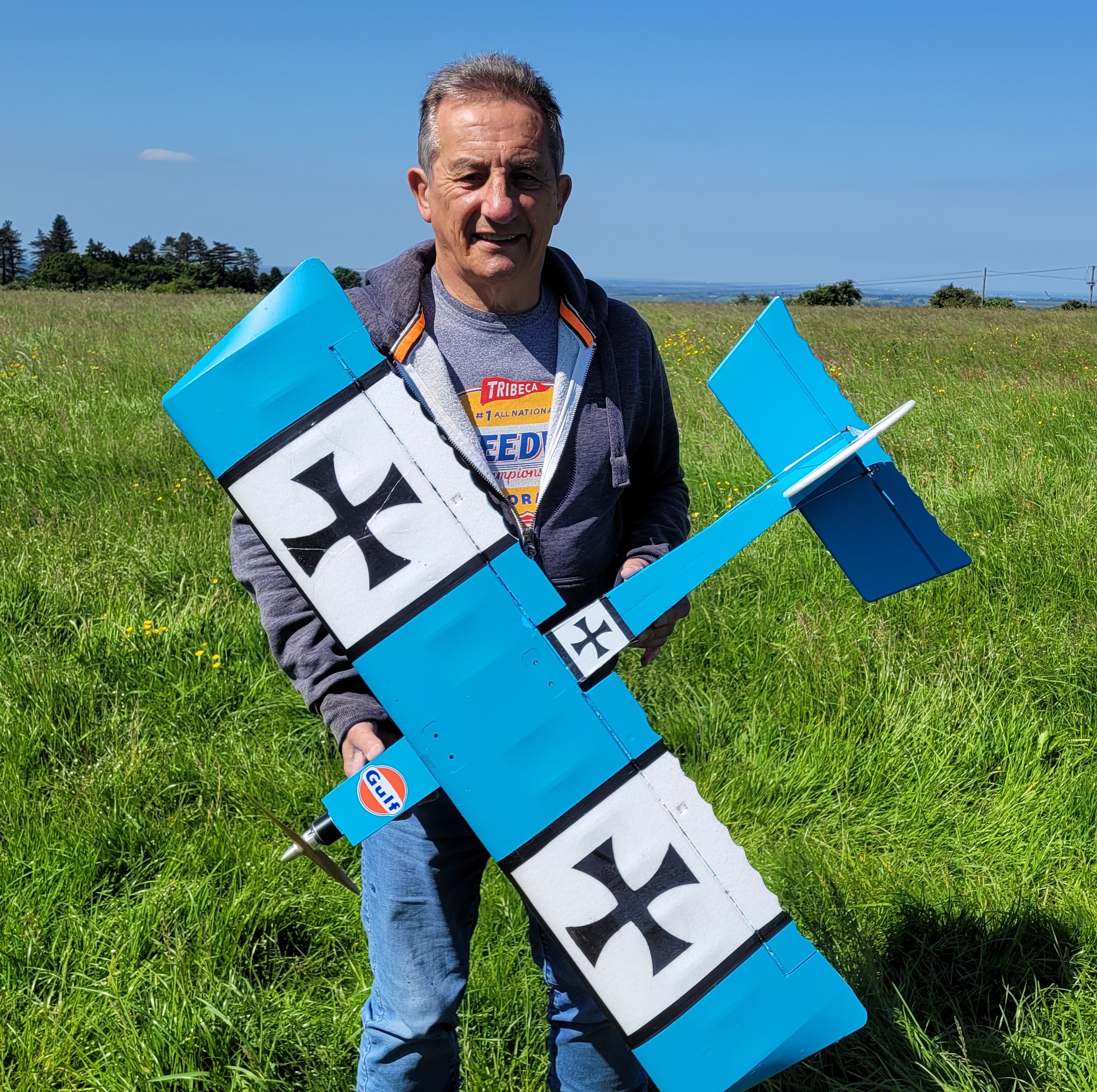 He chose a Durafly Ugly Stick V2 from HobbyKing, something we all agreed was a good all-round choice and in June he had several successful and confidence building flights.
He chose a Durafly Ugly Stick V2 from HobbyKing, something we all agreed was a good all-round choice and in June he had several successful and confidence building flights.
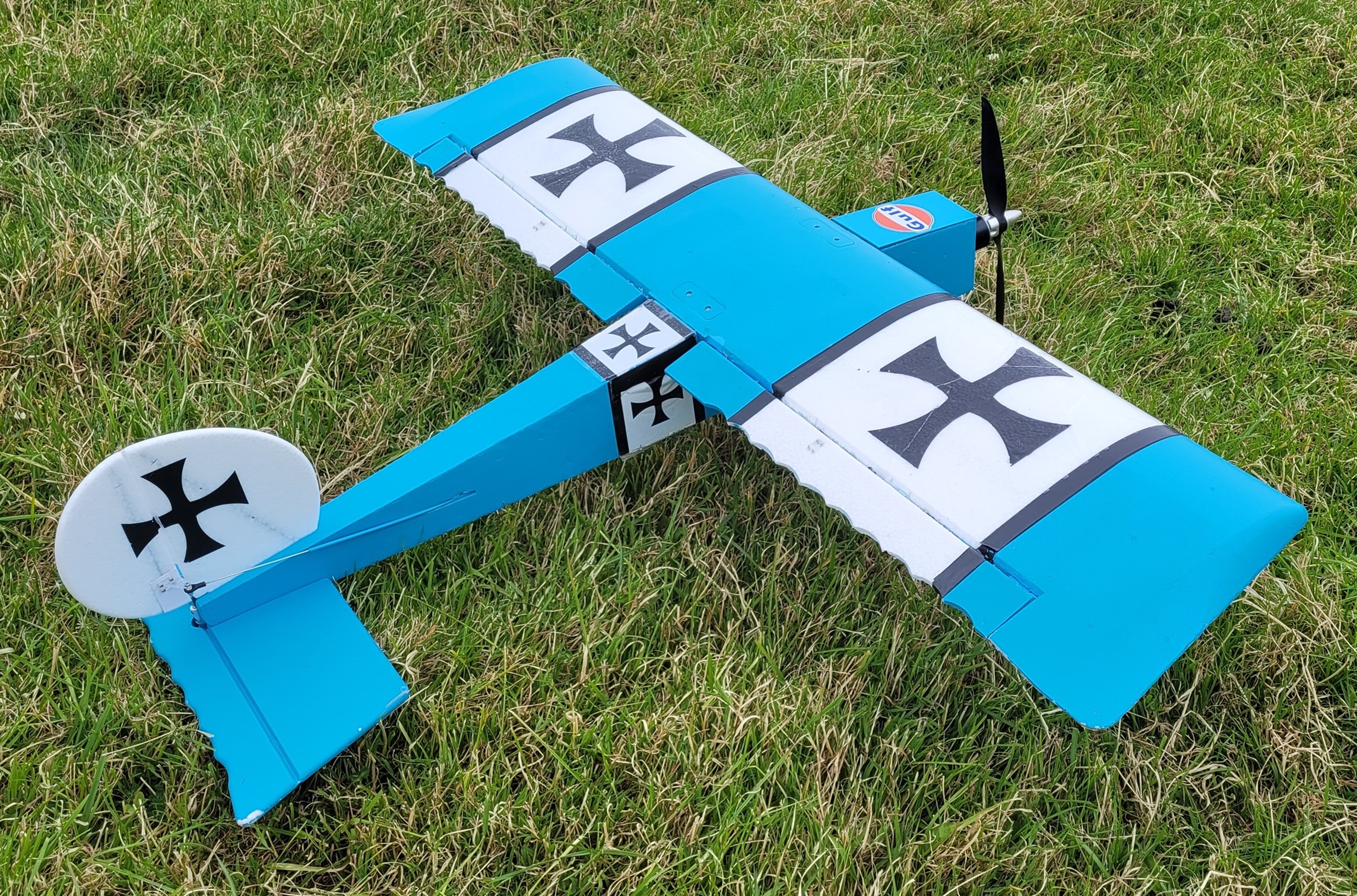 This is what the HobbyKing website says about it: The Durafly Ugly Stick V2 not only looks as good as the original but flies just as well too, perfectly capturing those excellent flight qualities of which the Ugly Stick was renowned. Being the well-mannered RC sports model it is, the Ugly Stick is suitable for both beginner and experienced flyers alike. At the lower end of the speed range, it exhibits no bad stall tendencies and can be flown comfortably at half throttle if desired. However, when you wish to experience its true flying capabilities, open the throttle wide and the Ugly Stick will oblige, performing a full range of sport aerobatic manoeuvres with the ease that made the original so popular. Due to the low current draw of the Ugly Stick V2 power system, you can also enjoy longer than average flying times with mixed power use.
In the video you’ll see me doing the trimming flight and then Woody enjoying it himself.
As well as assembling the Ugly Stick Woody has been busy re-painting his E-Flite F-15.
This is what the HobbyKing website says about it: The Durafly Ugly Stick V2 not only looks as good as the original but flies just as well too, perfectly capturing those excellent flight qualities of which the Ugly Stick was renowned. Being the well-mannered RC sports model it is, the Ugly Stick is suitable for both beginner and experienced flyers alike. At the lower end of the speed range, it exhibits no bad stall tendencies and can be flown comfortably at half throttle if desired. However, when you wish to experience its true flying capabilities, open the throttle wide and the Ugly Stick will oblige, performing a full range of sport aerobatic manoeuvres with the ease that made the original so popular. Due to the low current draw of the Ugly Stick V2 power system, you can also enjoy longer than average flying times with mixed power use.
In the video you’ll see me doing the trimming flight and then Woody enjoying it himself.
As well as assembling the Ugly Stick Woody has been busy re-painting his E-Flite F-15. 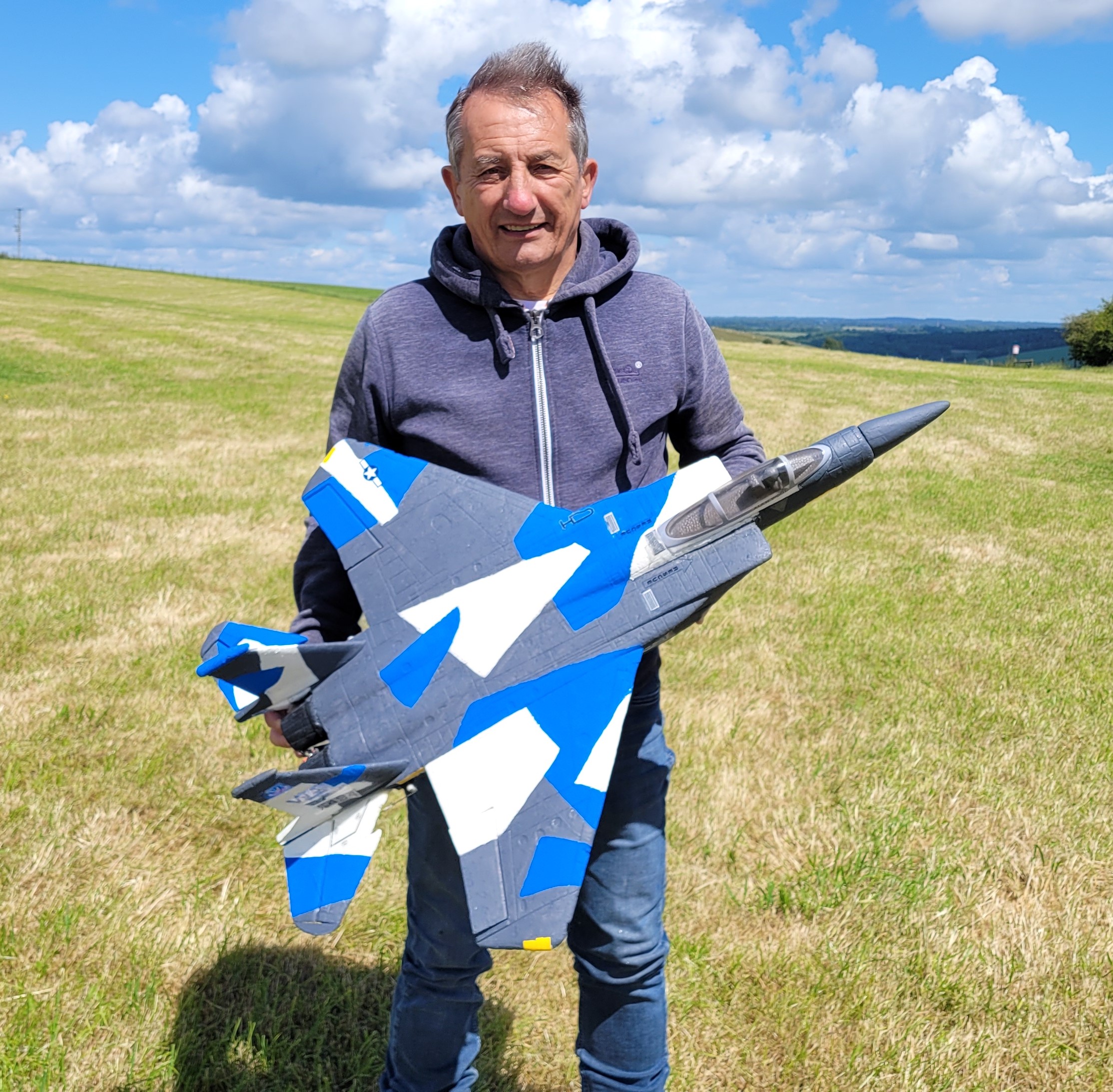
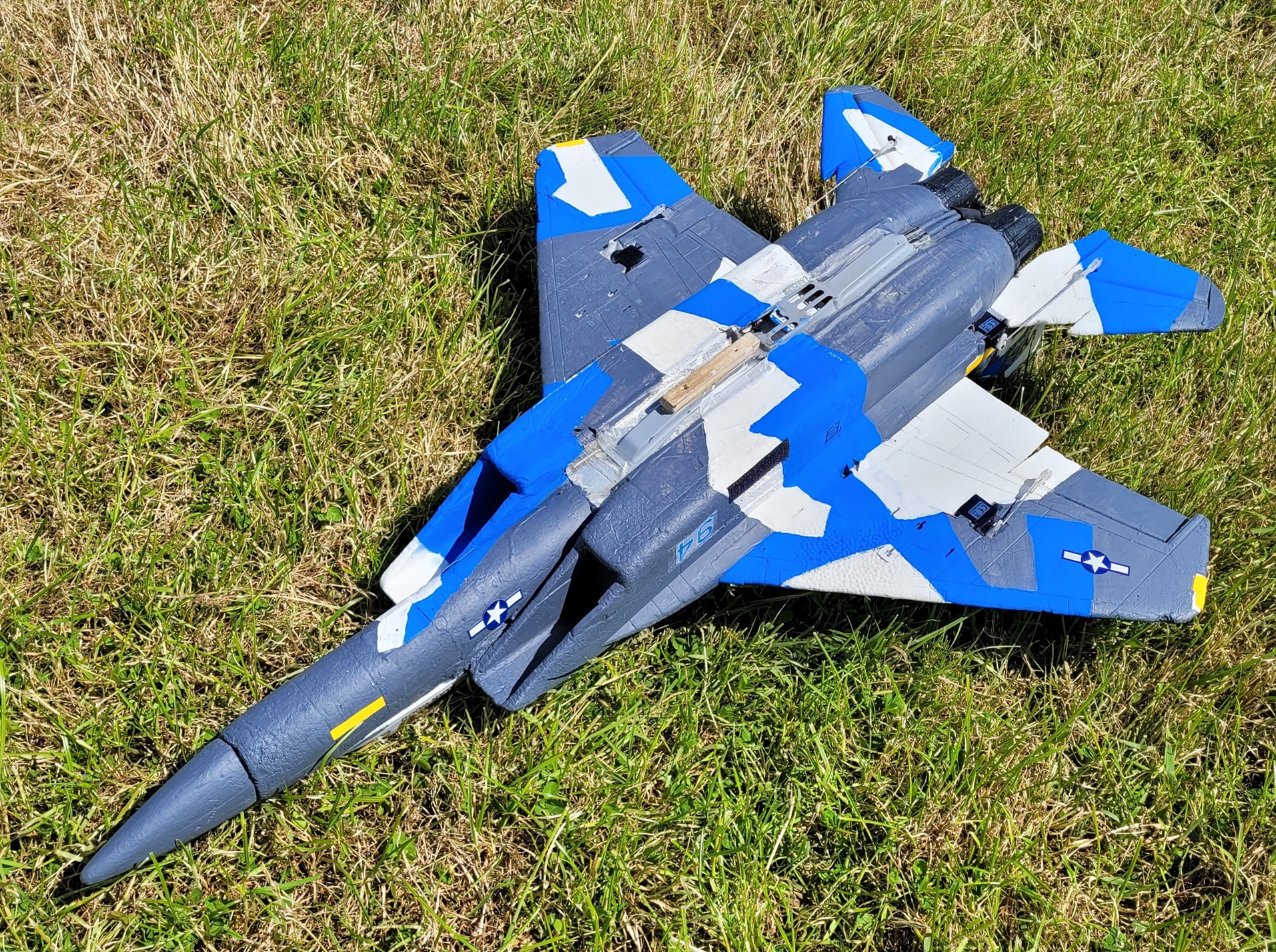 He’s kept the original colour scheme but it was getting a bit tatty and faded so he’s given it a facelift and brightened it up. We all commented that it looked much better in the air, really standing out well. Note that I said ‘looked’ rather than ‘looks’. Unfortunately, a couple of weeks after making the F-15 look all pretty again it had a mid-air with MacFly’s Max Thrust Ruckus and neither model survived the head on collision, a great shame.
He’s kept the original colour scheme but it was getting a bit tatty and faded so he’s given it a facelift and brightened it up. We all commented that it looked much better in the air, really standing out well. Note that I said ‘looked’ rather than ‘looks’. Unfortunately, a couple of weeks after making the F-15 look all pretty again it had a mid-air with MacFly’s Max Thrust Ruckus and neither model survived the head on collision, a great shame.
 About the only good thing to come out of the collision was that the very expensive and posh new larger wheels with inflatable tyres that MacFly had only recently fitted to the Ruckus were undamaged. They worked very well on our grass patch but sadly proved to be utterly useless when arriving at the ground with one wing and half the nose missing!
To replace the wrecked Ruckus MacFly has bought a Volantex Saber, a 920mm span 3D aerobatic model. The Saber comes ready fitted with a 2212 1250KV motor, a 30A speed controller and four 9g servos. MacFly said the only problem he had putting it together was adding the decals which are very thin and proved to be extremely difficult to apply well.
About the only good thing to come out of the collision was that the very expensive and posh new larger wheels with inflatable tyres that MacFly had only recently fitted to the Ruckus were undamaged. They worked very well on our grass patch but sadly proved to be utterly useless when arriving at the ground with one wing and half the nose missing!
To replace the wrecked Ruckus MacFly has bought a Volantex Saber, a 920mm span 3D aerobatic model. The Saber comes ready fitted with a 2212 1250KV motor, a 30A speed controller and four 9g servos. MacFly said the only problem he had putting it together was adding the decals which are very thin and proved to be extremely difficult to apply well.
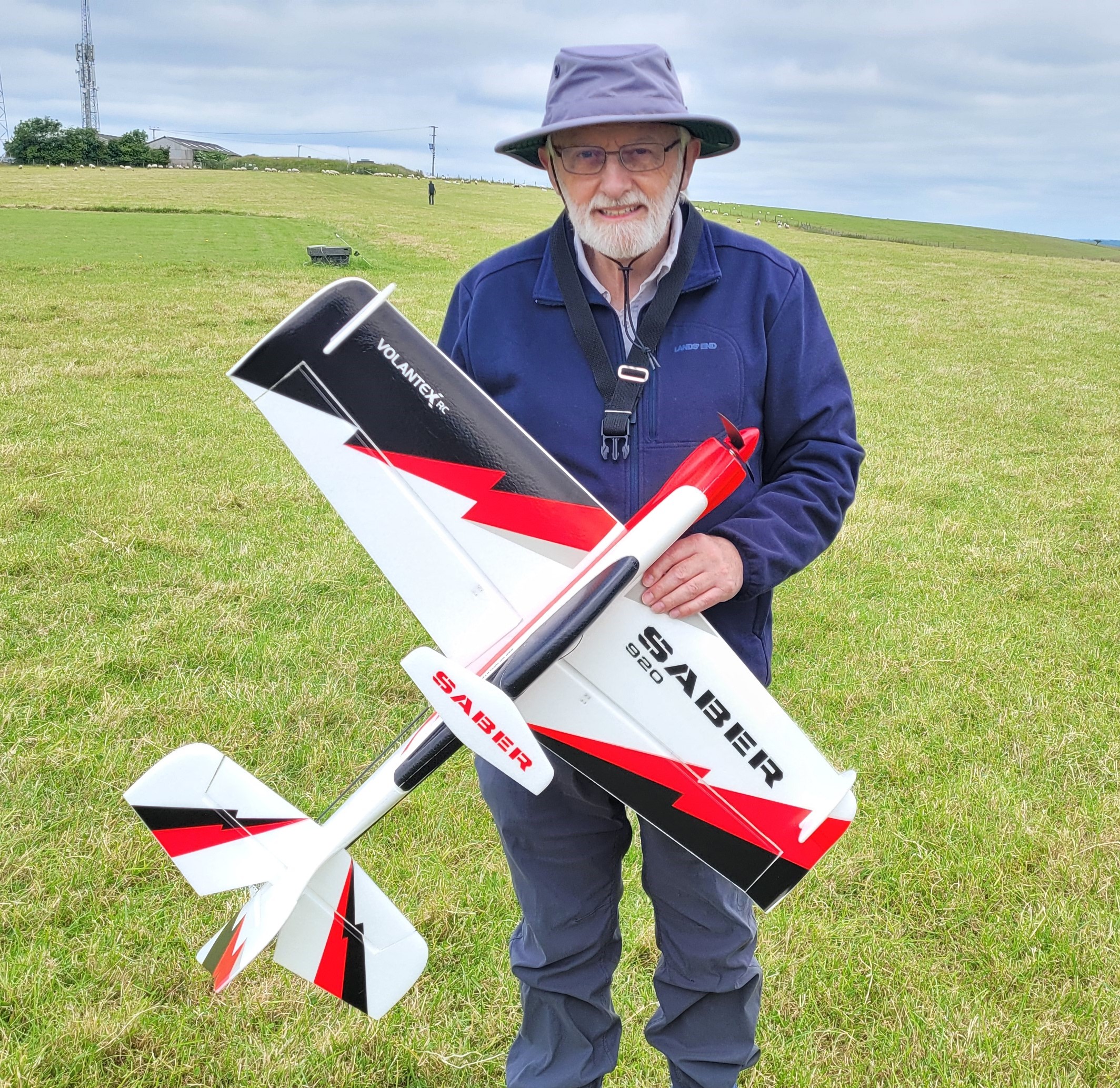
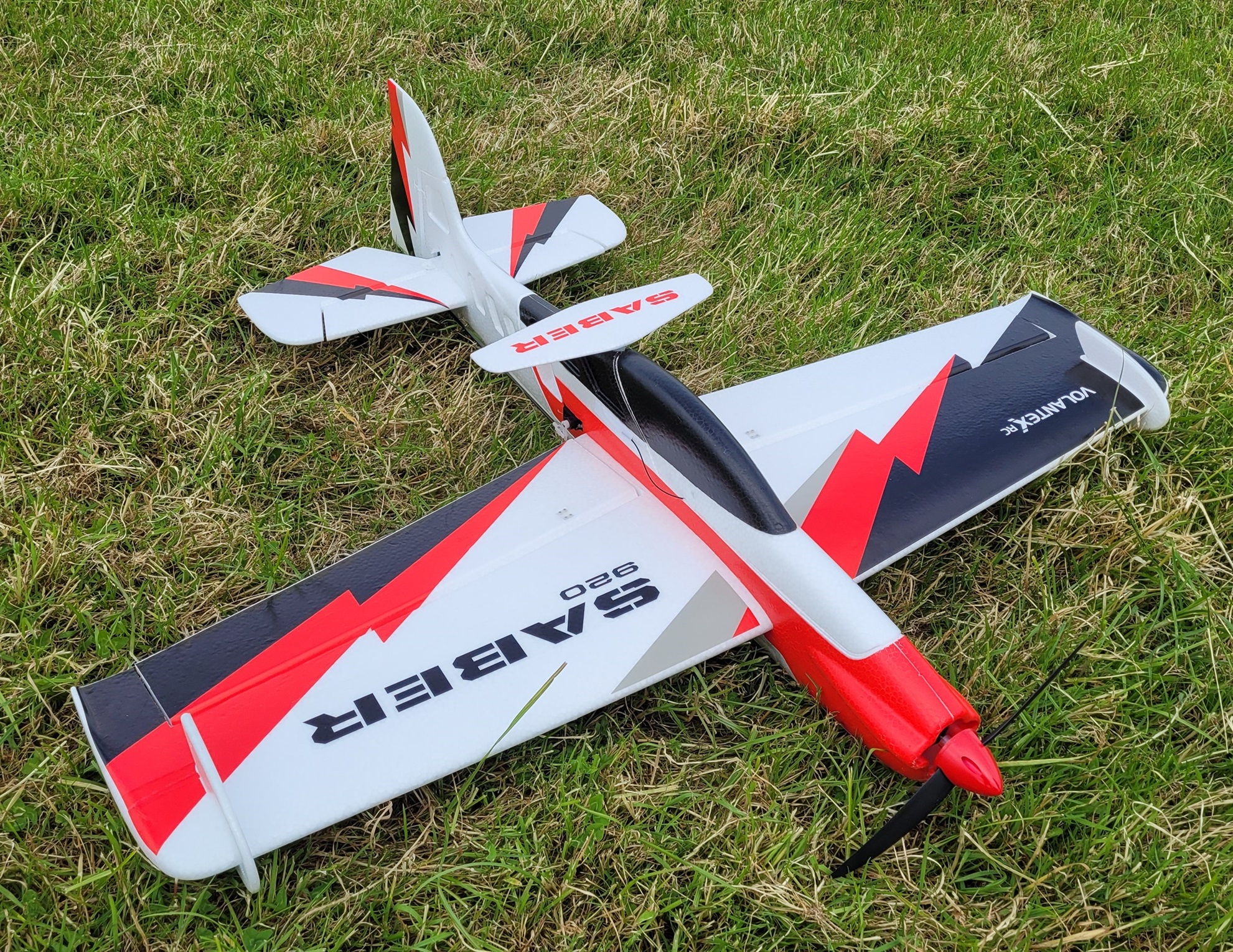 It all looks good to me, I think he’s done an excellent job of them. The Saber comes with wheels and spats but MacFly chose not to fit the undercarriage and instead toughened up the underside of the fuselage with helicopter tape. Personally I think I would have fitted the undercarriage and wheels but left off the spats which are often a problem on grass.
It all looks good to me, I think he’s done an excellent job of them. The Saber comes with wheels and spats but MacFly chose not to fit the undercarriage and instead toughened up the underside of the fuselage with helicopter tape. Personally I think I would have fitted the undercarriage and wheels but left off the spats which are often a problem on grass.
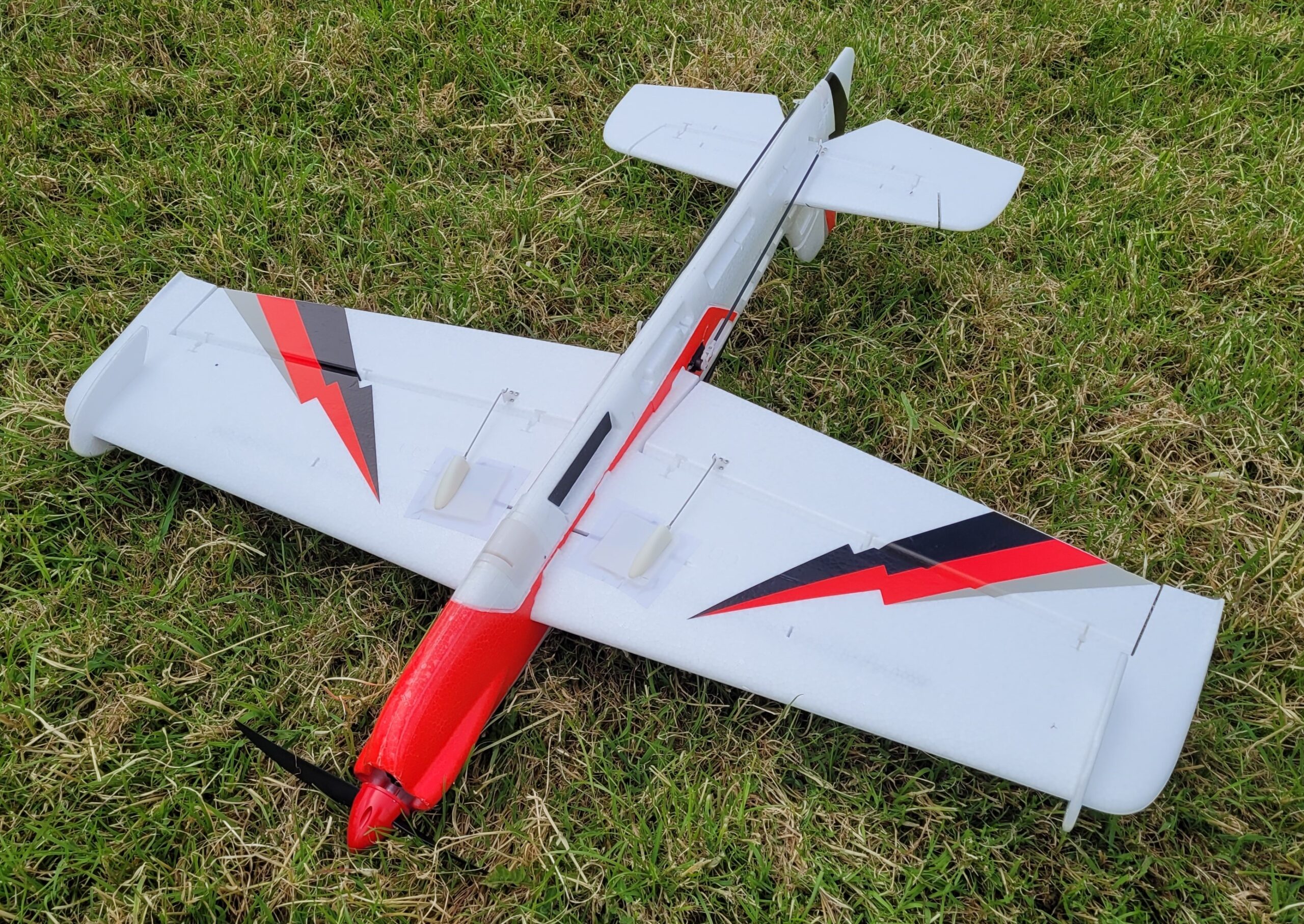 MacFly asked me to do the initial trimming during which time I found the Saber to be an excellent flier before handing the transmitter over for MacFly to get to grips with it.
Young Leo has built himself a new model, a K&C Fleur-De-Lys. Never heard of it? Neither has anyone I have asked and I can’t find anything on the internet with that name.
MacFly asked me to do the initial trimming during which time I found the Saber to be an excellent flier before handing the transmitter over for MacFly to get to grips with it.
Young Leo has built himself a new model, a K&C Fleur-De-Lys. Never heard of it? Neither has anyone I have asked and I can’t find anything on the internet with that name.
 Leo got the kit from Dwayne Pipe ,who got it from Fred Robinson, whose late father-in-law had owned it. Obviously it’s a very old kit and it was originally designed to be IC powered.
Leo got the kit from Dwayne Pipe ,who got it from Fred Robinson, whose late father-in-law had owned it. Obviously it’s a very old kit and it was originally designed to be IC powered.
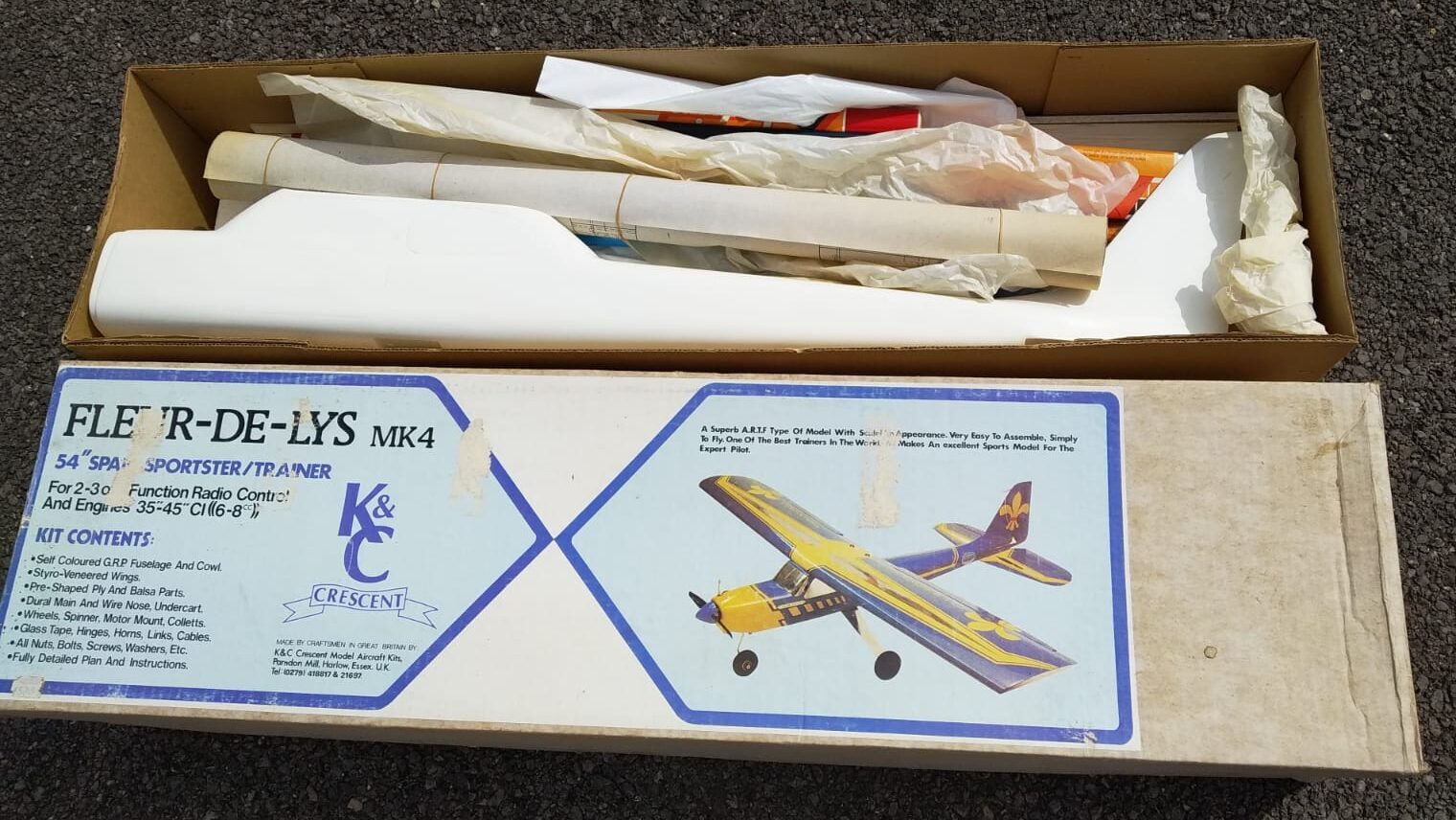 But Leo has made it electric by fitting it with the motor from his old Wot 4 along with an 80A speed controller. He’s using a four cell 5500mAh battery so the flights should be long.
But Leo has made it electric by fitting it with the motor from his old Wot 4 along with an 80A speed controller. He’s using a four cell 5500mAh battery so the flights should be long. 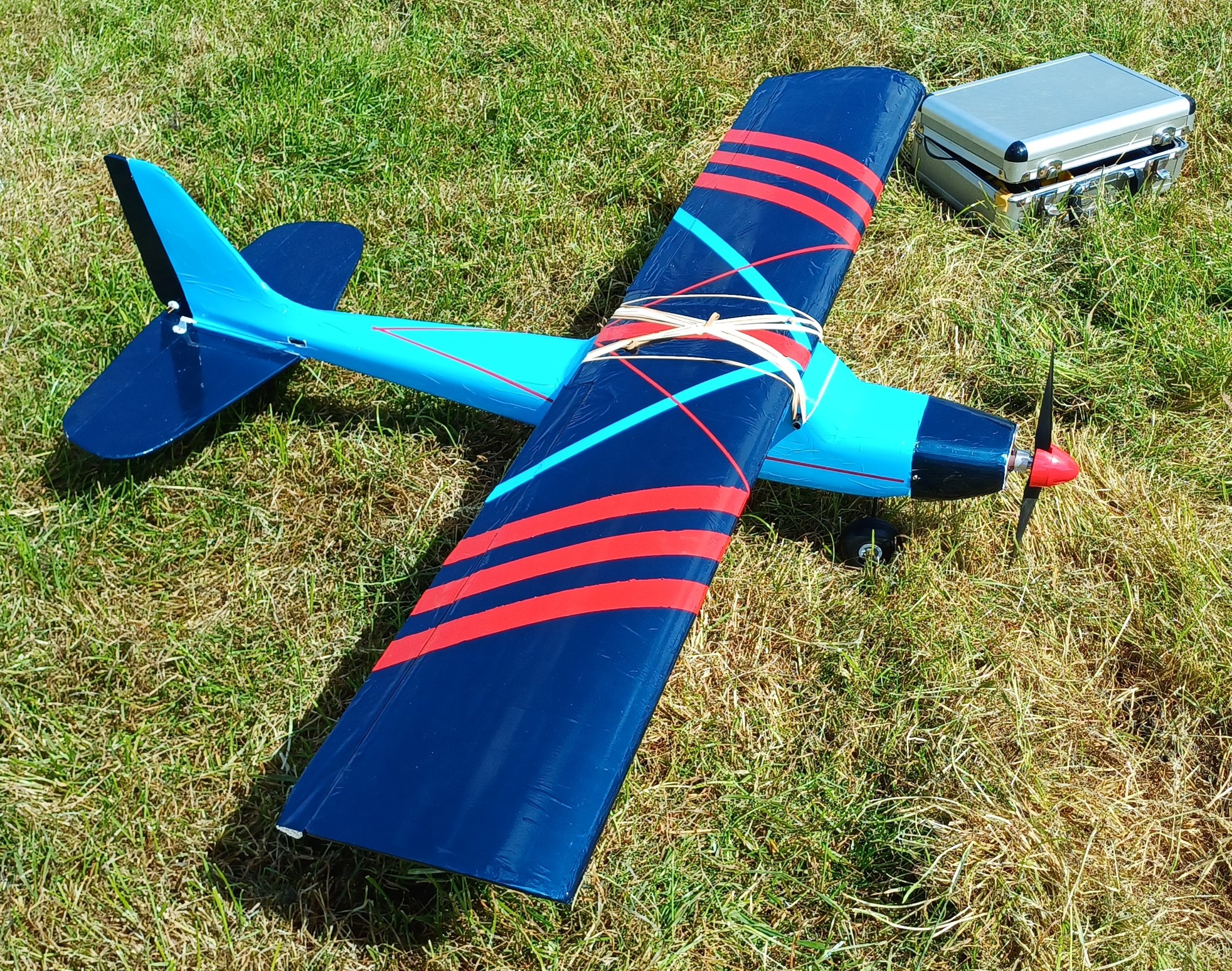 The model is 54” wingspan and has a fibreglass fuselage and veneered foam wings. Leo asked Dougal to do the first flight and, as you can see in this month’s video, all went well.
Father’s Day was in June, a day when we’re all spoilt rotten by our kids…possibly. To be fair my kids looked after me well and, amongst other things bought me a suitable beer!
The model is 54” wingspan and has a fibreglass fuselage and veneered foam wings. Leo asked Dougal to do the first flight and, as you can see in this month’s video, all went well.
Father’s Day was in June, a day when we’re all spoilt rotten by our kids…possibly. To be fair my kids looked after me well and, amongst other things bought me a suitable beer!  Have a Kite at this, the Eagle eyed amongst you will like it, I won’t Crow but I went into Raptors. Did that make you ‘Owl with laughter? Oh OK, make up your own jokes then…
We’ve had a few people asking about the masts that are close to our field, wondering if they cause any radio issues. The vast majority of us use 2.4GHz nowadays and none of us or the nearby MVSA (Meon Valley Soaring Association) have experienced any problems. Both myself and Dougal sometimes fly FPV (First Person View) which uses 5.8GHz to transmit video back to the goggles and we haven’t noticed any problems when being close to the masts but Dougal decided to do the ultimate test in and fly between them.
Have a Kite at this, the Eagle eyed amongst you will like it, I won’t Crow but I went into Raptors. Did that make you ‘Owl with laughter? Oh OK, make up your own jokes then…
We’ve had a few people asking about the masts that are close to our field, wondering if they cause any radio issues. The vast majority of us use 2.4GHz nowadays and none of us or the nearby MVSA (Meon Valley Soaring Association) have experienced any problems. Both myself and Dougal sometimes fly FPV (First Person View) which uses 5.8GHz to transmit video back to the goggles and we haven’t noticed any problems when being close to the masts but Dougal decided to do the ultimate test in and fly between them.
 He had zero problems, no loss of signal at all so I think we’re safe to assume they’re never going to be a problem to us. I have to admit to being jealous, I wanted to do that first!
Captain Slow bought himself a new plane this month, a Maule M-7 which he bought from Banggood. He paid just £62 but was slightly miffed when he saw that they’d reduced the price by £10 a week or so later. Calm down Slow, it was cheap, you got a bargain anyway!
He had zero problems, no loss of signal at all so I think we’re safe to assume they’re never going to be a problem to us. I have to admit to being jealous, I wanted to do that first!
Captain Slow bought himself a new plane this month, a Maule M-7 which he bought from Banggood. He paid just £62 but was slightly miffed when he saw that they’d reduced the price by £10 a week or so later. Calm down Slow, it was cheap, you got a bargain anyway!
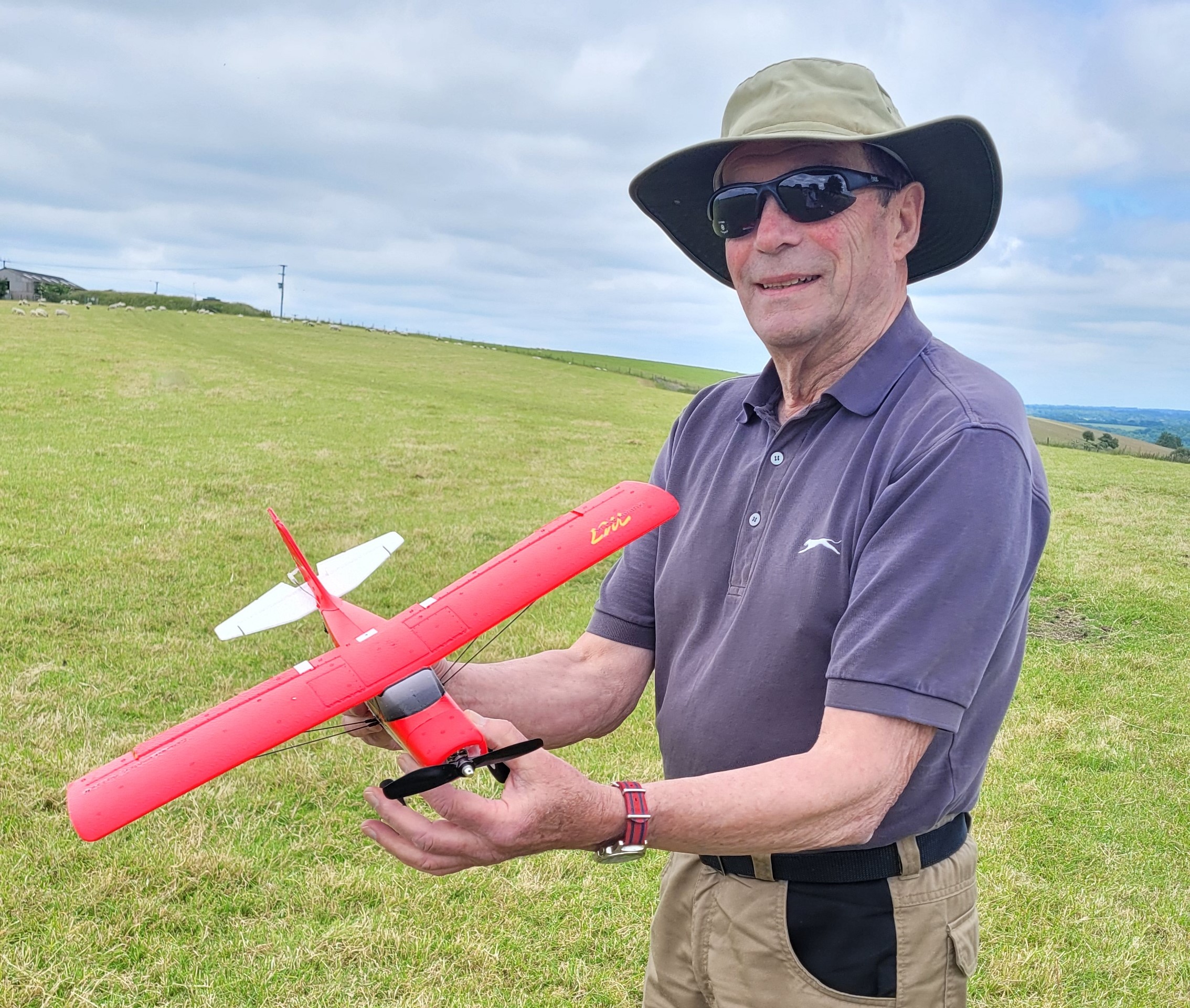
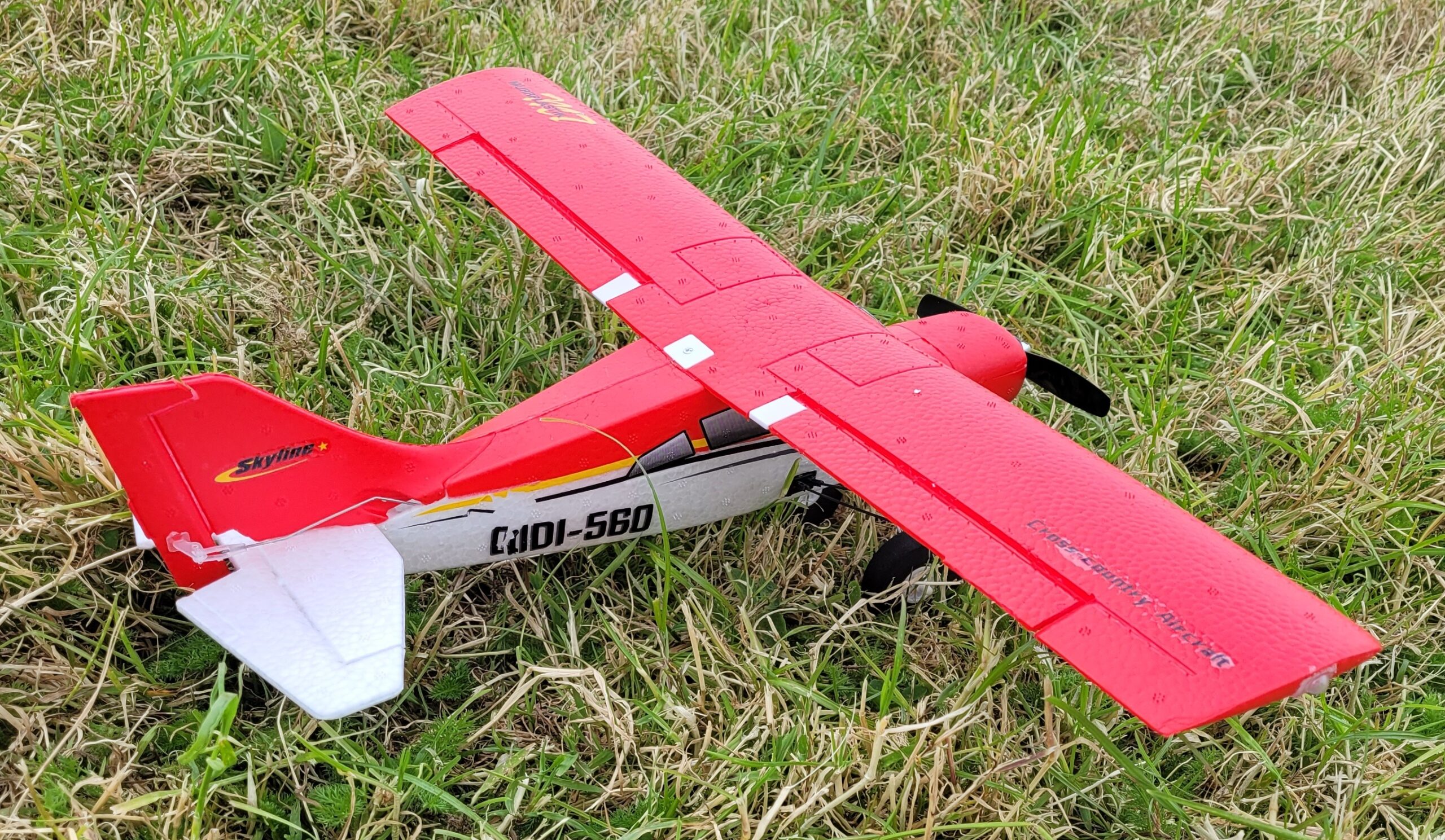 The Maule is another of the small foam RTF models that comes complete with transmitter.
The Maule is another of the small foam RTF models that comes complete with transmitter. 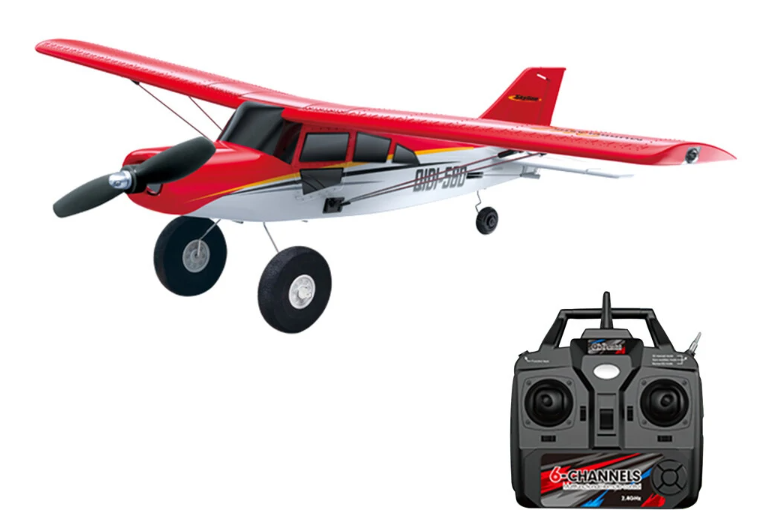 The plane is fitted with a 6-axis gyro which can be switched through three different modes from the transmitter. Like the similar models it also has a push button which with just a single press with make the Maule either loop or roll. It uses a single cell 500mAh lipo battery and about the only negative thing Captain Slow had to say about the Maule was that the stickers are extremely thin and delicate. The Maule flew well right from the start with gyro turned on and Slow has had several flights already and it experimenting with the various settings. I don’t think he’s pressed the aerobatic button yet…it might go quickly!
Some of you will know that I had a flight in a two Spitfire back in October 2020 although I rarely mention it…! Well in June my wife and I visited the Spitfire & Hurricane Memorial Museum at Manston Airport in Kent and I had a go on their Spitfire simulator.
The plane is fitted with a 6-axis gyro which can be switched through three different modes from the transmitter. Like the similar models it also has a push button which with just a single press with make the Maule either loop or roll. It uses a single cell 500mAh lipo battery and about the only negative thing Captain Slow had to say about the Maule was that the stickers are extremely thin and delicate. The Maule flew well right from the start with gyro turned on and Slow has had several flights already and it experimenting with the various settings. I don’t think he’s pressed the aerobatic button yet…it might go quickly!
Some of you will know that I had a flight in a two Spitfire back in October 2020 although I rarely mention it…! Well in June my wife and I visited the Spitfire & Hurricane Memorial Museum at Manston Airport in Kent and I had a go on their Spitfire simulator.
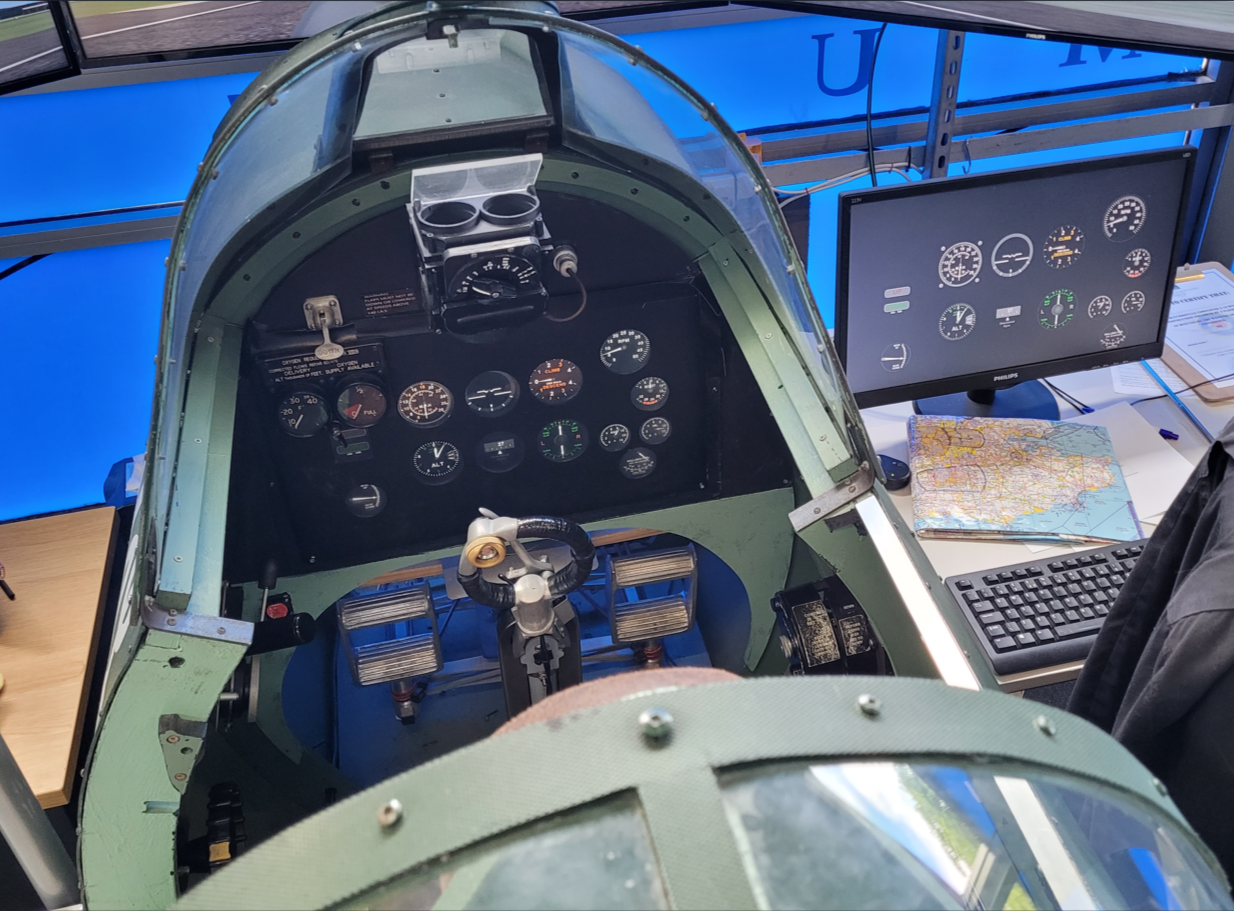 I was well briefed before taking-off from Manston and I flew across London, overflew London City Airport, almost took out the London Eye and landed safely at Heathrow. Doreen filmed most of the ‘flight,’ here are some stills taken from the video:
I was well briefed before taking-off from Manston and I flew across London, overflew London City Airport, almost took out the London Eye and landed safely at Heathrow. Doreen filmed most of the ‘flight,’ here are some stills taken from the video:
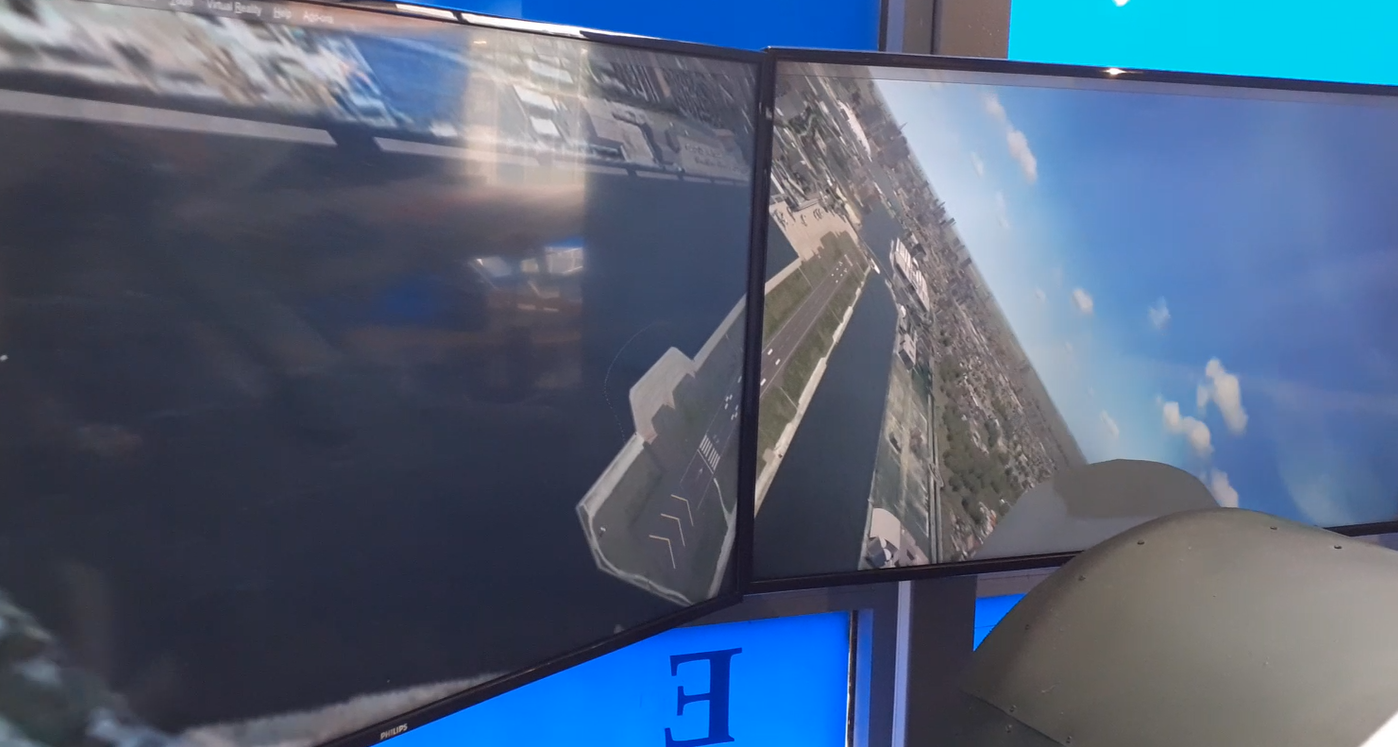

 The museum is small but worth a visit and entry is free, although donations are gratefully accepted. The simulator is great and costs £10 for a 10 minutes or £30 for 30 minutes.
The museum is small but worth a visit and entry is free, although donations are gratefully accepted. The simulator is great and costs £10 for a 10 minutes or £30 for 30 minutes.  What I hadn’t realised is that on the other side of the car park is the RAF Manston History Museum. There is a small entry charge and the museum looked small from the car park.
What I hadn’t realised is that on the other side of the car park is the RAF Manston History Museum. There is a small entry charge and the museum looked small from the car park. 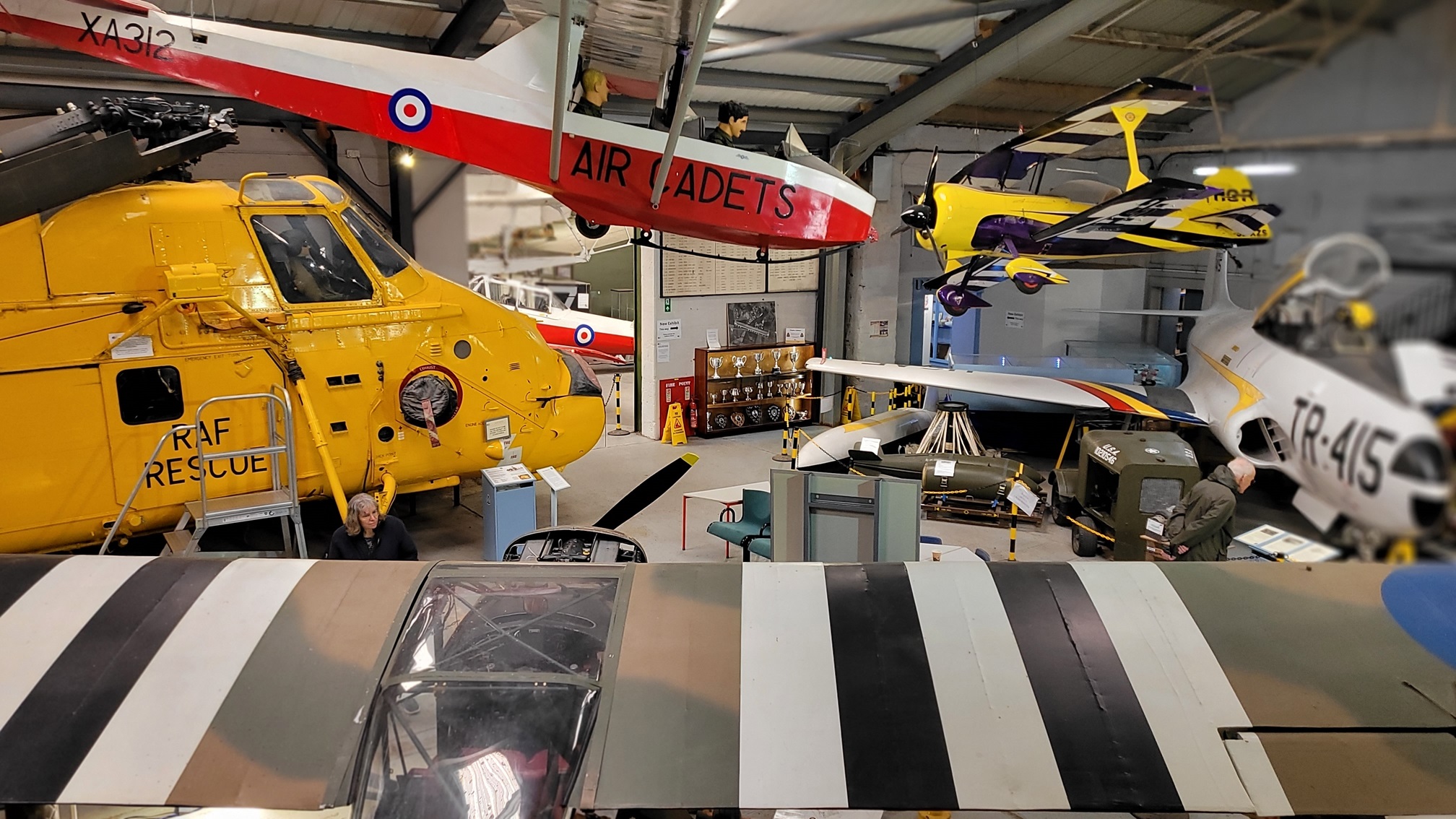
 However once inside we found it was much bigger than we thought and is crammed full of loads of interesting aircraft and equipment and there were even more planes outside.
However once inside we found it was much bigger than we thought and is crammed full of loads of interesting aircraft and equipment and there were even more planes outside. 
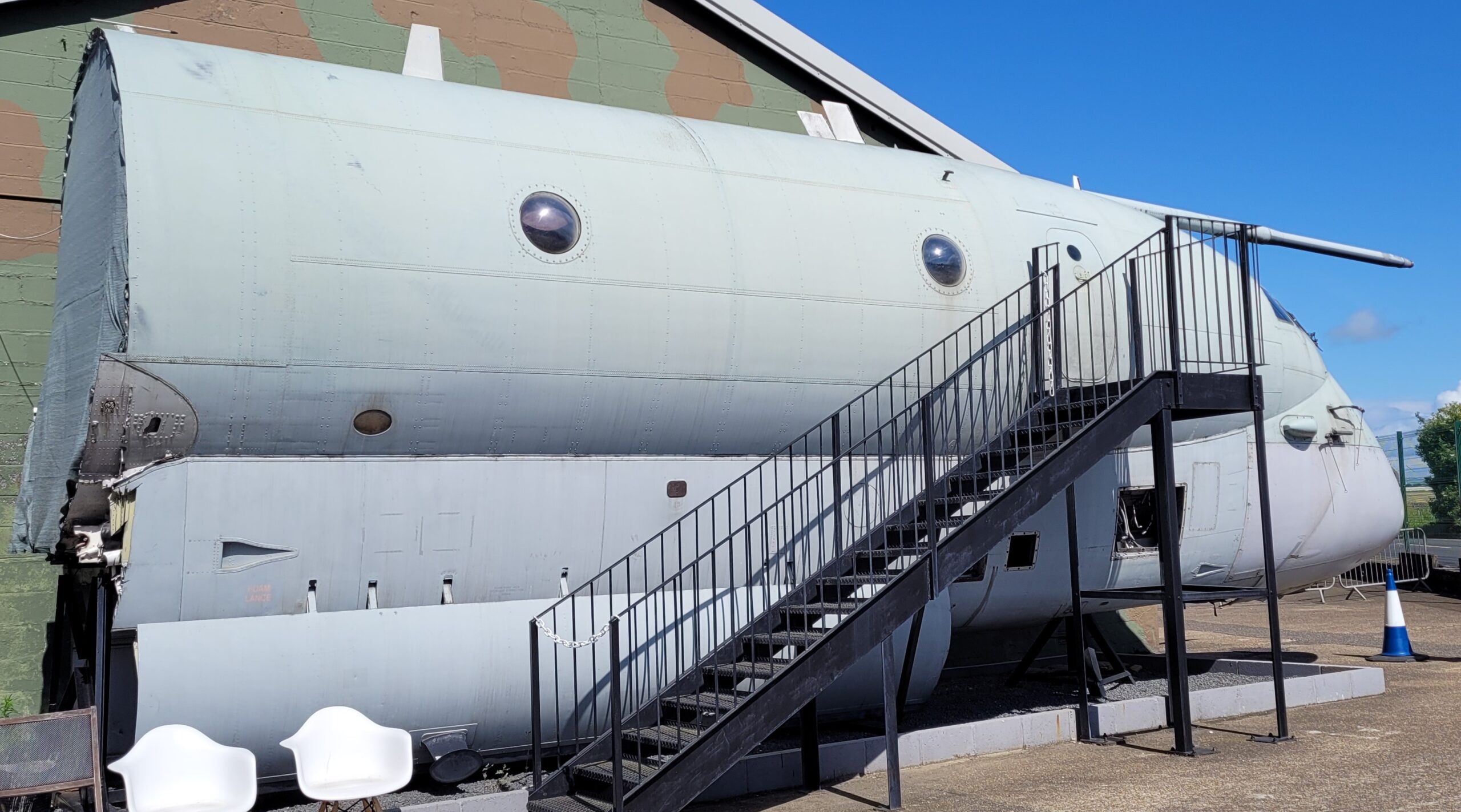 Sadly we didn’t have time to do it justice, it’s definitely worth a visit if you’re over that way.
Quiz time now, what is this aircraft that I spotted at the RAF Manston History Museum?
Sadly we didn’t have time to do it justice, it’s definitely worth a visit if you’re over that way.
Quiz time now, what is this aircraft that I spotted at the RAF Manston History Museum?
 Now for some of Kryten’s excellent action shots from June. The first two are Woody’s F-15 and MacFly’s Ruckus that were sadly both lost in a mid-air collision later in the month:
Now for some of Kryten’s excellent action shots from June. The first two are Woody’s F-15 and MacFly’s Ruckus that were sadly both lost in a mid-air collision later in the month:

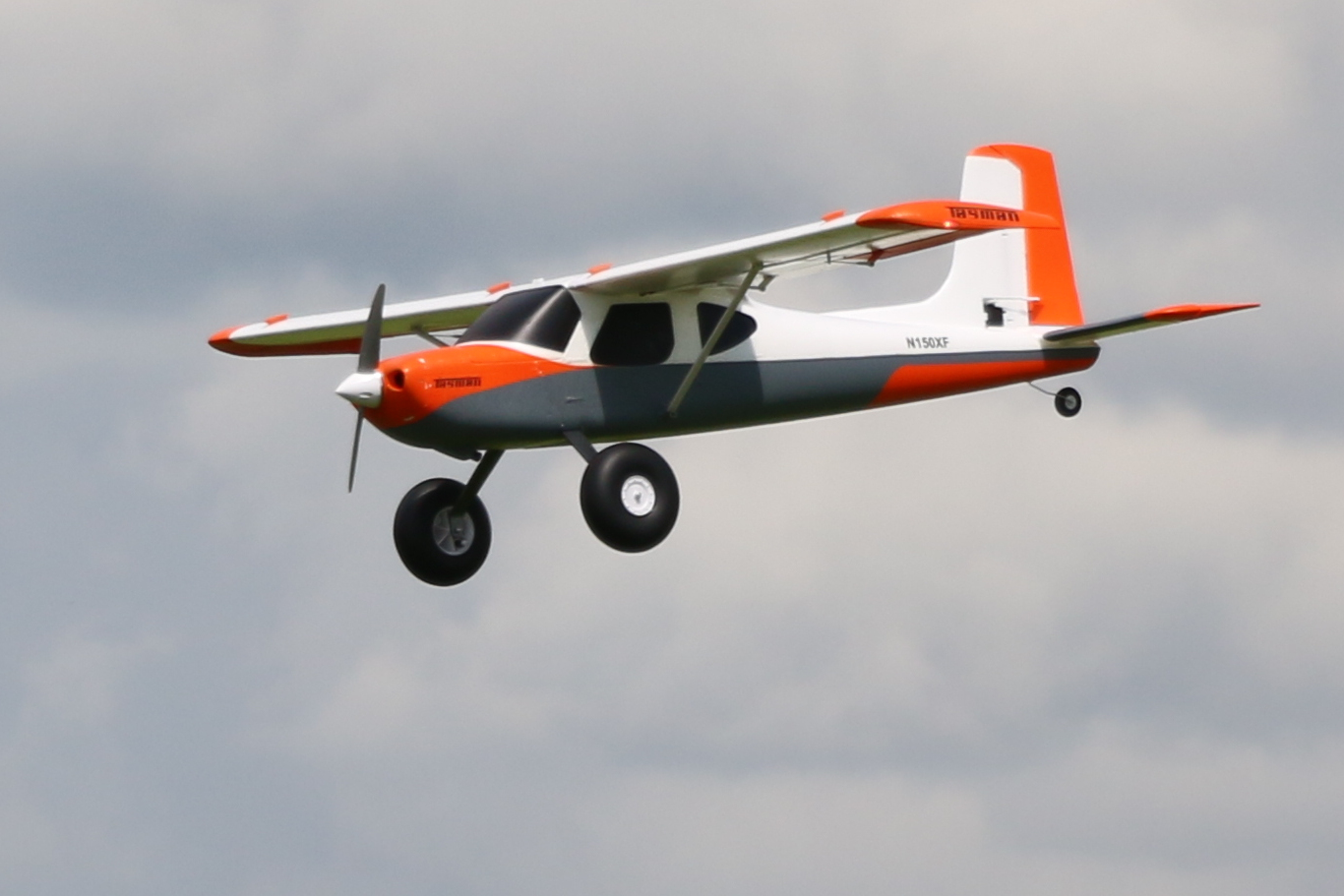
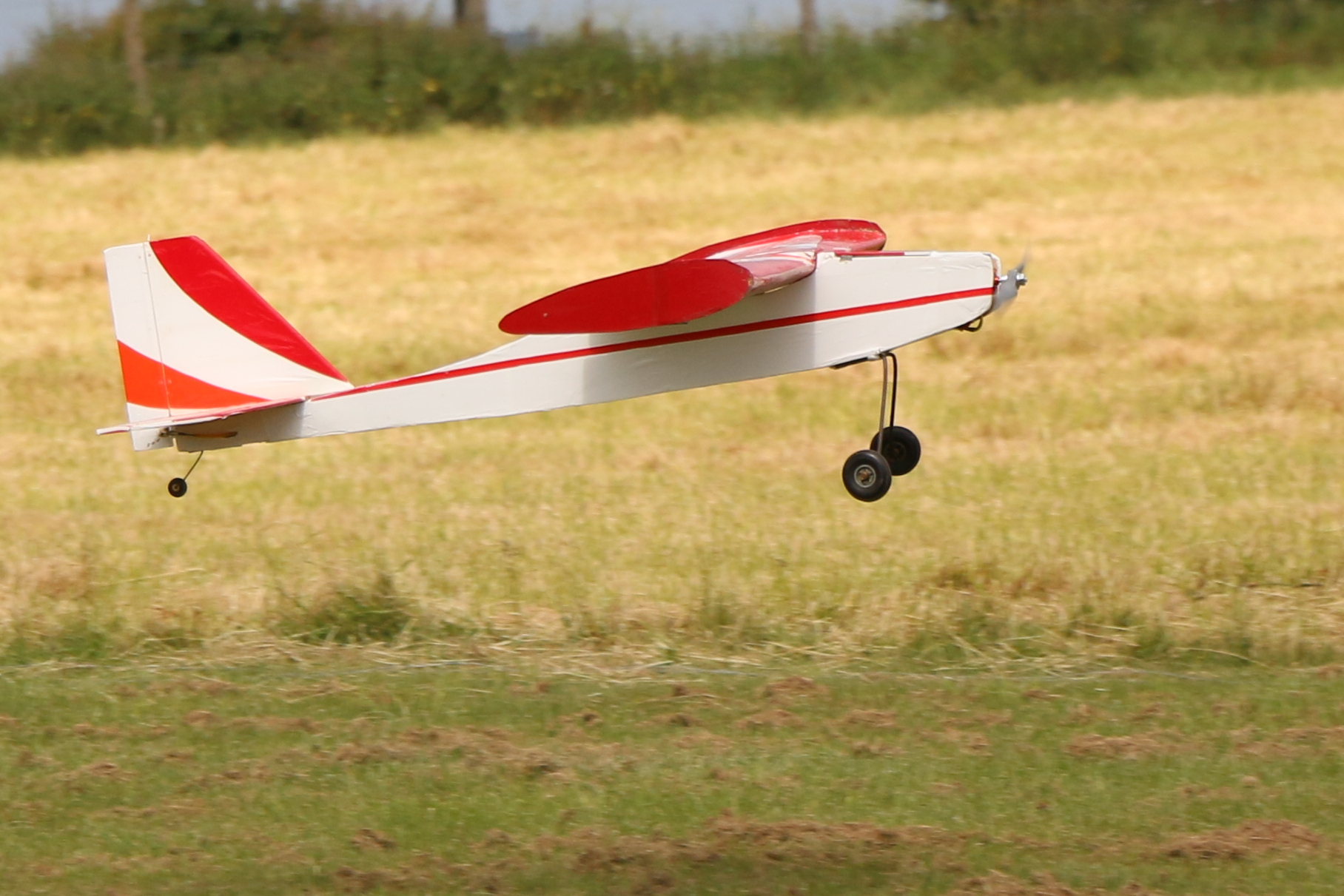
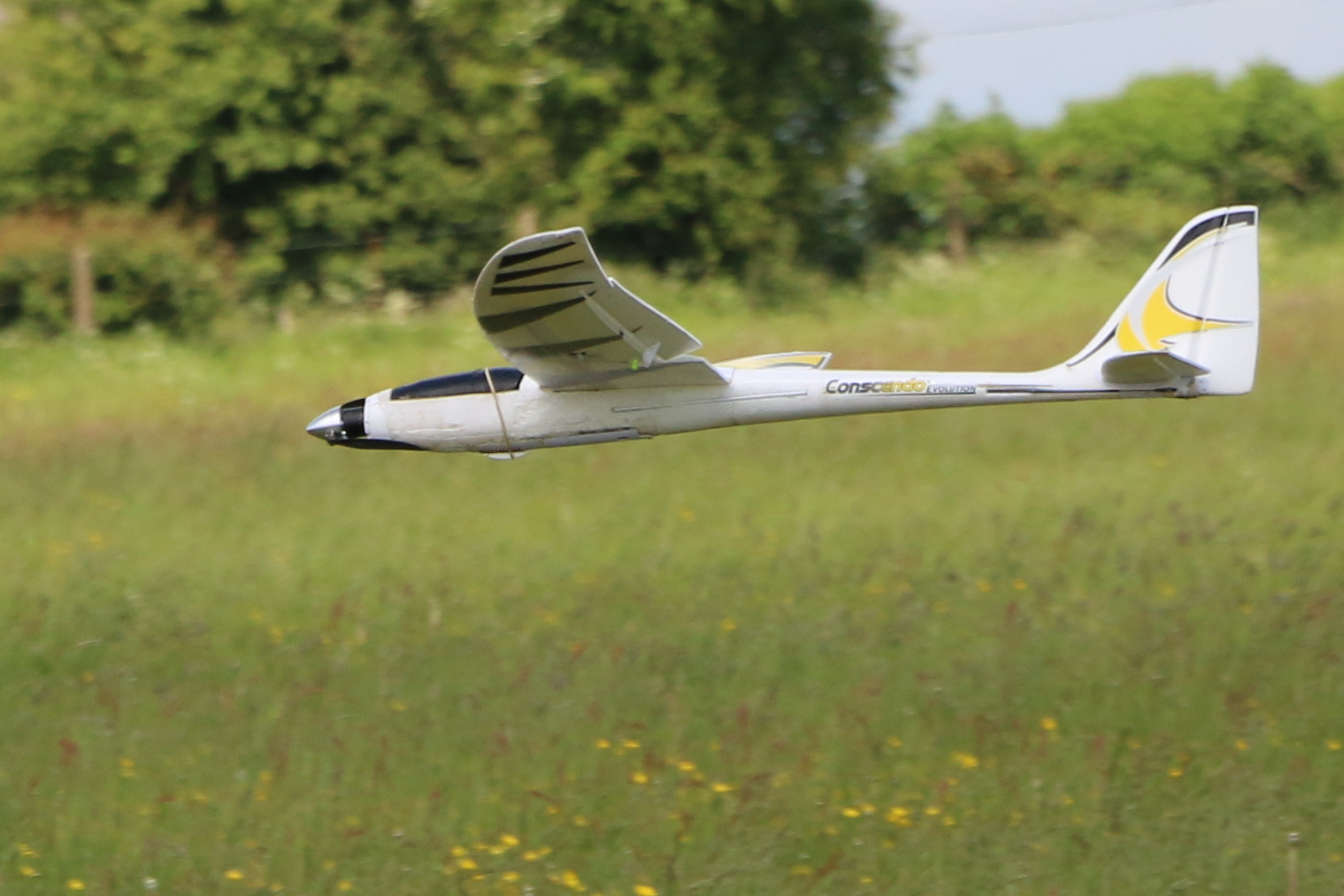
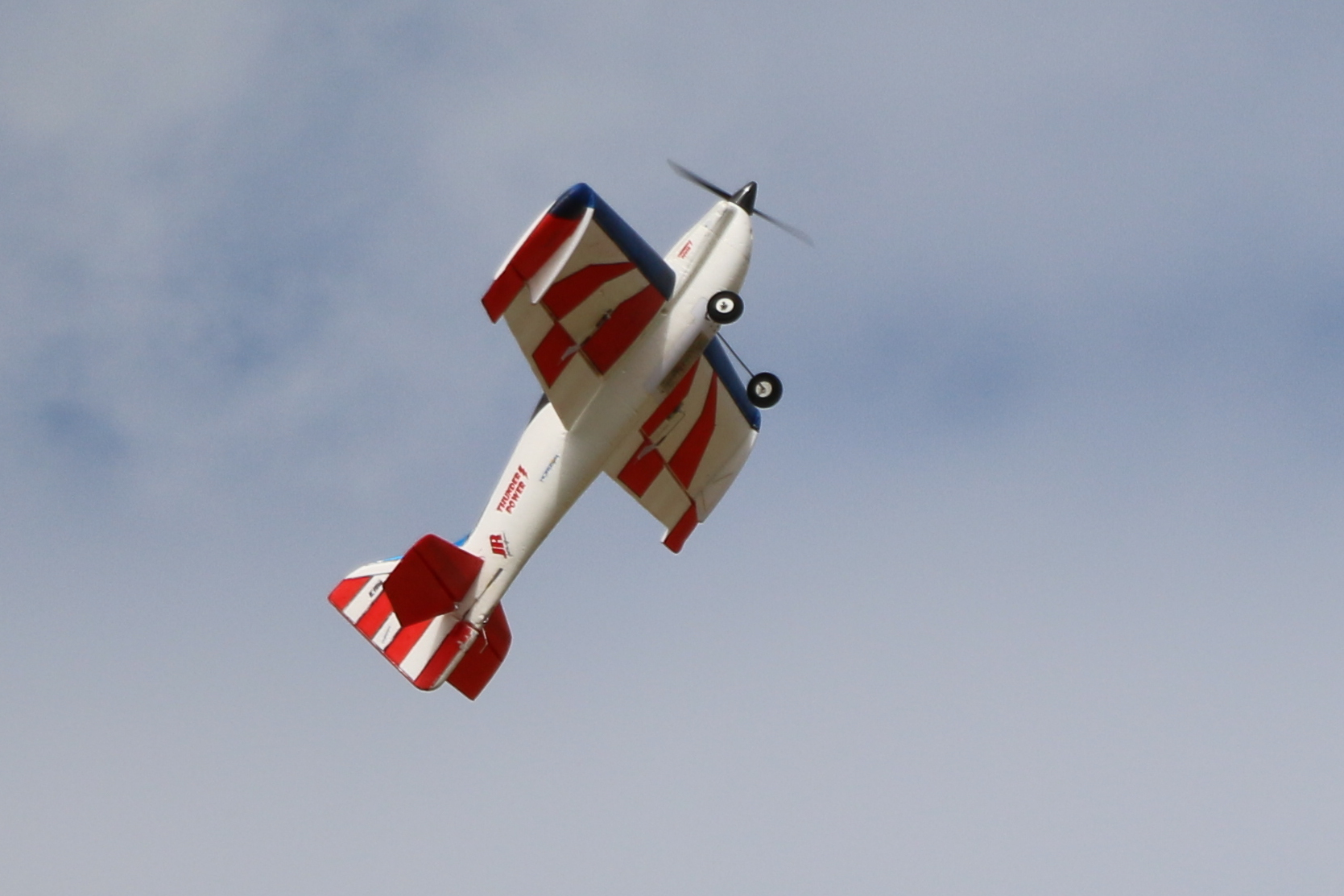 This month’s video has footage filmed by me, MacFly, and Dougal Entendre, thanks guys.
Please watch the video full-screen, it’s so much better with small models flying around:
If the video won’t play for you please click HERE
The invention of the air friar:
This month’s video has footage filmed by me, MacFly, and Dougal Entendre, thanks guys.
Please watch the video full-screen, it’s so much better with small models flying around:
If the video won’t play for you please click HERE
The invention of the air friar: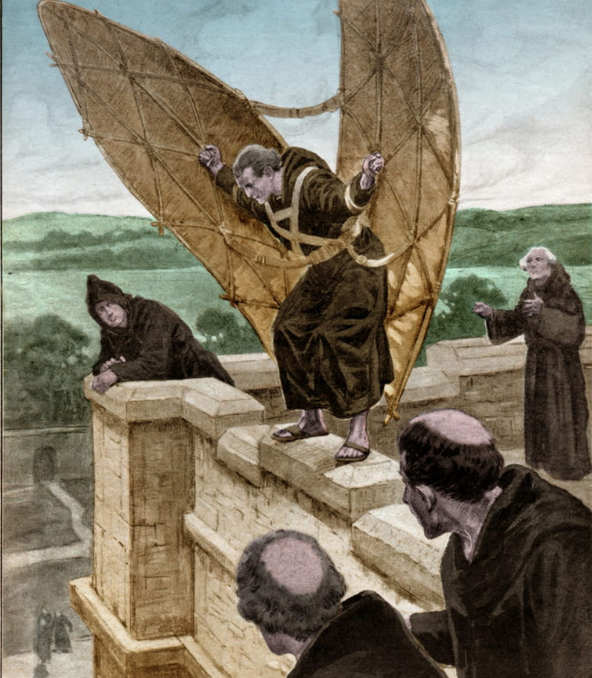 Colin Cowplain
Colin Cowplain Patch News – May 2024
I was away at the end of April and the start of May so I missed some of the action but fortunately other PAM members kept me up to date and took lots of photos and videos for us all to enjoy. Overall, the weather in May was pretty good and a fair bit of flying was enjoyed but of course the mixture of warm sunshine interspersed with rain showers meant that the grass grew quickly. As I mentioned last month we’ve had to replace the old yellow mower and Gordon Bennett sourced a replacement and a second mower box to protect it from the elements. This was kindly delivered to the field by our always helpful farmer and put in place and painted by 1066 and Woody. The patch can now be cut much more easily and is in great condition, especially considering it was just a field a few months ago.
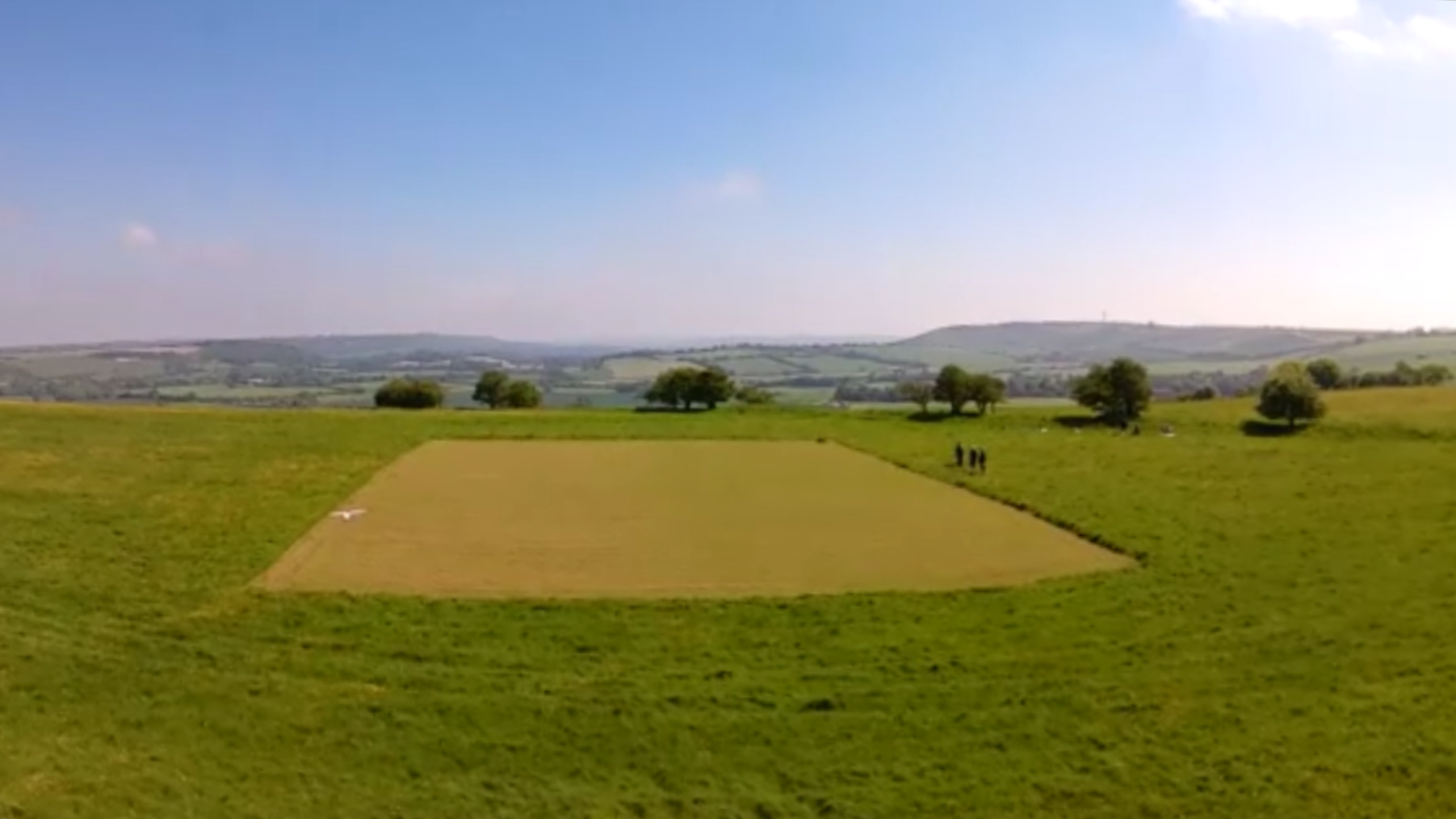
One day we spotted a deer in the field as we arrived. It quickly ran off as we approached but it was nice to see even if only briefly. I just had time to take this rather blurry picture:
At the end of April Woody brought along a model that he’d built from a plan by Tomas Hellberg. Tomas has a great website with plans and information for various foamies that can be downloaded for free: rc.tomhe.net Woody’s is an F/A-18 Super Hornet which is designed to be built from 6mm Depron but Woody has used Hobbycraft foamboard.
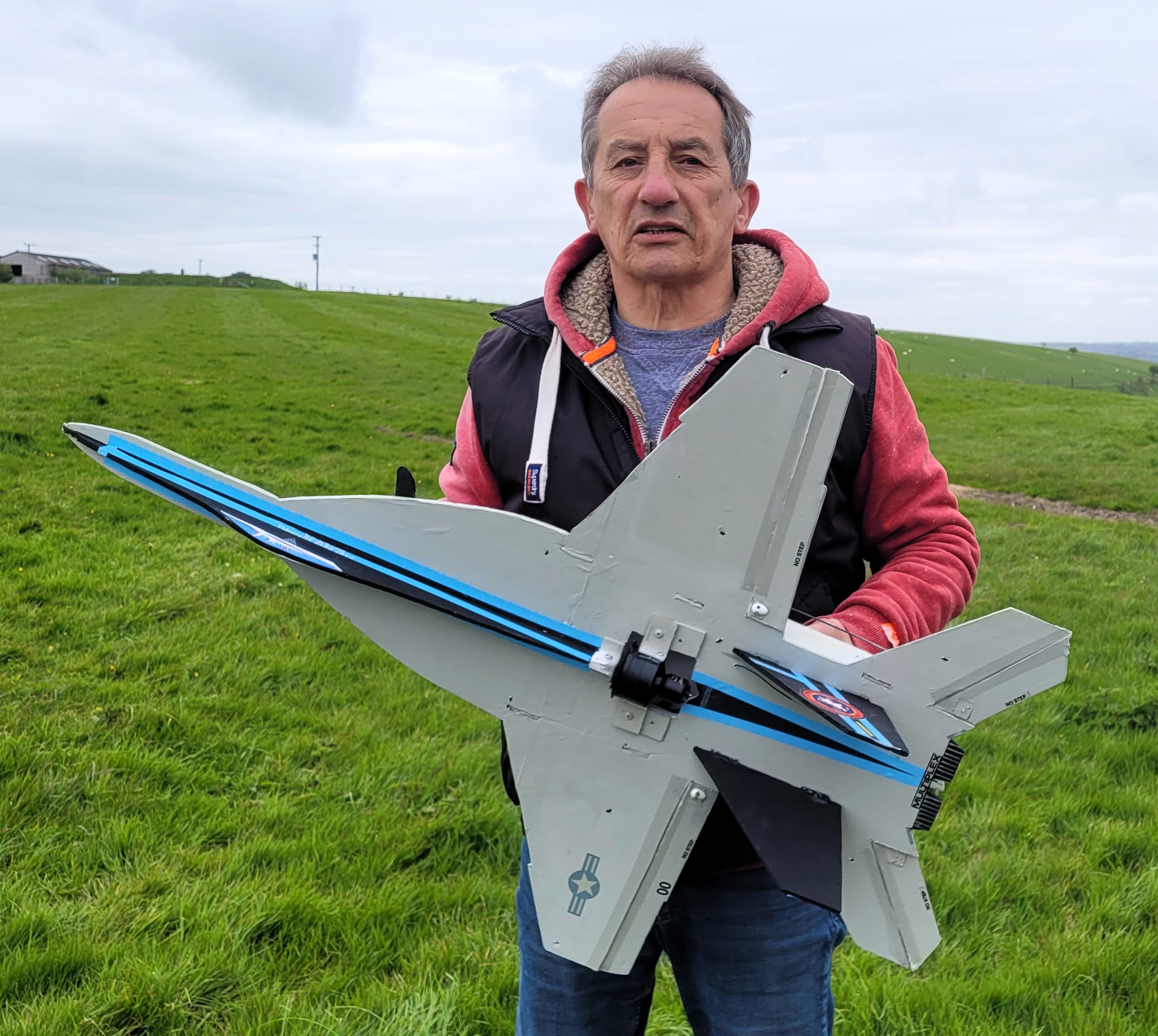 The Hornet has a wingspan of 735mm and a length of 1025mm and, like the other foamboard models, is supposed to be fitted with a centre mounted motor with the propellor running in a slot. We know that this arrangement can be noisy due to the propellor being close to the slot although enlarging the slot to increase the clearance, especially in front of the propellor, can reduce the noise significantly. Being concerned about the noise and not wanting to upset our new neighbours Woody decided to fit his Hornet with a 50mm FMS ducted fan unit which would definitely be a quieter option.
The Hornet has a wingspan of 735mm and a length of 1025mm and, like the other foamboard models, is supposed to be fitted with a centre mounted motor with the propellor running in a slot. We know that this arrangement can be noisy due to the propellor being close to the slot although enlarging the slot to increase the clearance, especially in front of the propellor, can reduce the noise significantly. Being concerned about the noise and not wanting to upset our new neighbours Woody decided to fit his Hornet with a 50mm FMS ducted fan unit which would definitely be a quieter option.
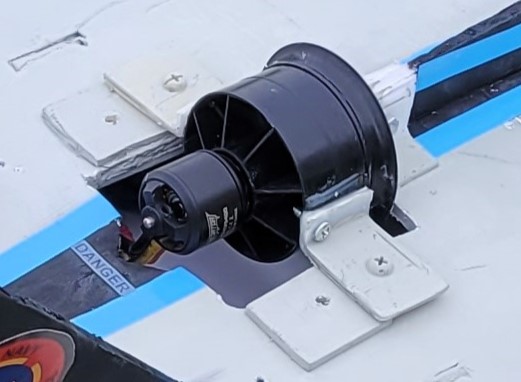 The designer’s model used tailerons only for control although he does mention that ailerons can be added as an option and Woody has done that. He’s linked each aileron to a taileron using one Tower Pro servo each side, a system I first saw on the HobbyKing SU-27 foamie. It seems a very odd set-up as when up elevator is applied the ailerons also go up rather than down but it worked very well on the SU-27. Woody has finished his Hornet in the colour scheme of the one flown by Captain Pete Mitchell (Maverick) in the movie Top Gun Maverick. So, does it make Woody fly like Tom Cruise? Er…no…well not yet anyway.
The designer’s model used tailerons only for control although he does mention that ailerons can be added as an option and Woody has done that. He’s linked each aileron to a taileron using one Tower Pro servo each side, a system I first saw on the HobbyKing SU-27 foamie. It seems a very odd set-up as when up elevator is applied the ailerons also go up rather than down but it worked very well on the SU-27. Woody has finished his Hornet in the colour scheme of the one flown by Captain Pete Mitchell (Maverick) in the movie Top Gun Maverick. So, does it make Woody fly like Tom Cruise? Er…no…well not yet anyway. 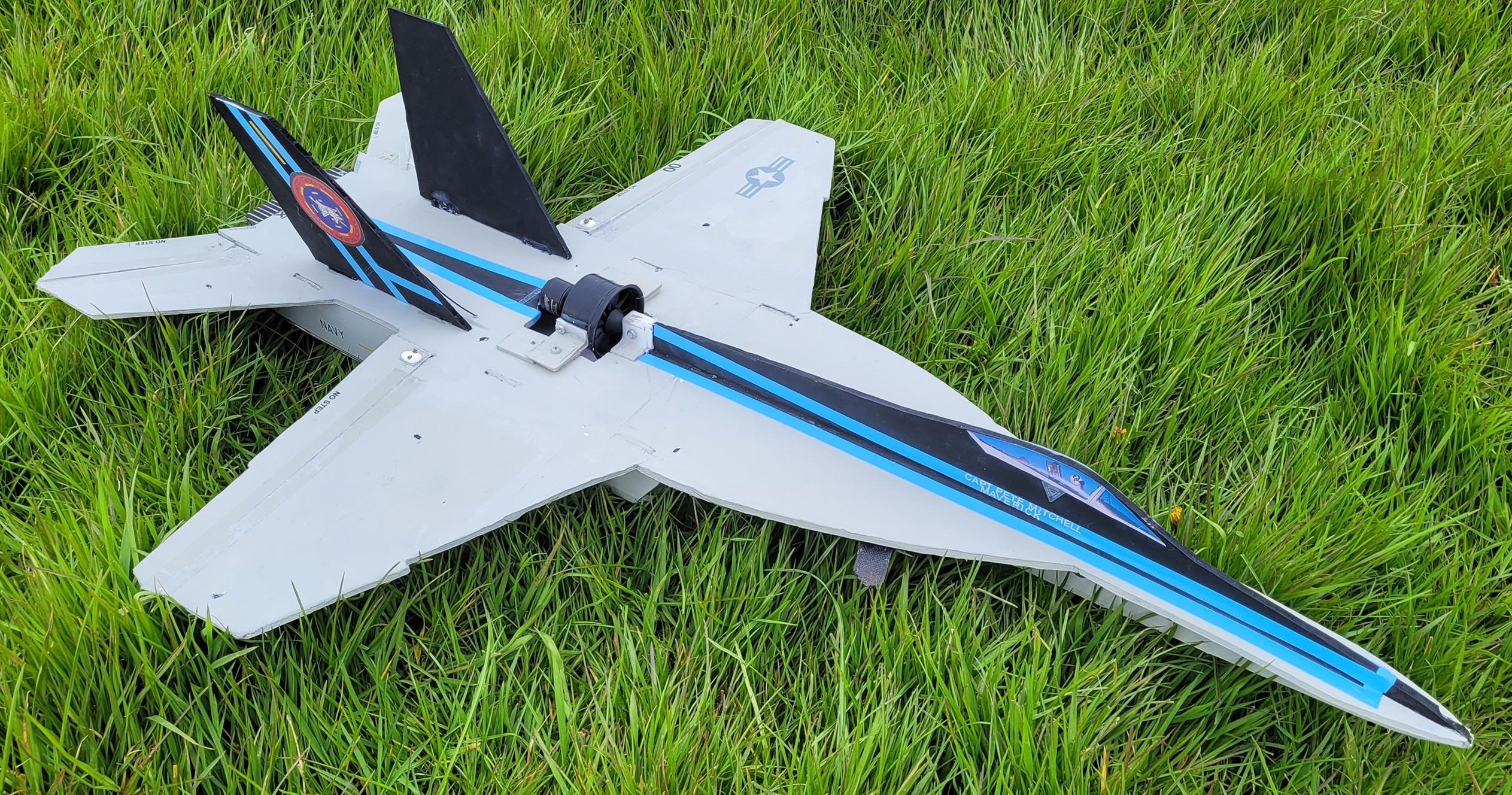 The initial test flights with the EDF unit showed that although the model sounded good there simply wasn’t enough power. So Woody reluctantly replaced the FMS unit with a Turnigy Aerodrive 2826/6 2200kv motor and a 6×4.5 prop. I had a few more test flights with it and made various changes which included moving the centre of gravity forward a lot and eventually I got it flying reasonably well but certainly not properly.
The initial test flights with the EDF unit showed that although the model sounded good there simply wasn’t enough power. So Woody reluctantly replaced the FMS unit with a Turnigy Aerodrive 2826/6 2200kv motor and a 6×4.5 prop. I had a few more test flights with it and made various changes which included moving the centre of gravity forward a lot and eventually I got it flying reasonably well but certainly not properly.
 I suggested Dougal Entendre try it to see if he had any ideas and was secretly rather pleased when he had exactly the same result as me, it flew but only just. Dougal suggested a higher kv motor running a smaller prop to give the Hornet more speed so Woody then fitted a T-Motor AS2308 2600kv and a 5” propellor. That produced more speed but the flying characteristics were still ‘interesting’ and it was very noisy, too noisy to use, so Woody is going to try a 6” prop instead. At the moment trials are ongoing so watch this space. The first attempts with the Turnigy motor fitted can be seen in this month’s video.
I suggested Dougal Entendre try it to see if he had any ideas and was secretly rather pleased when he had exactly the same result as me, it flew but only just. Dougal suggested a higher kv motor running a smaller prop to give the Hornet more speed so Woody then fitted a T-Motor AS2308 2600kv and a 5” propellor. That produced more speed but the flying characteristics were still ‘interesting’ and it was very noisy, too noisy to use, so Woody is going to try a 6” prop instead. At the moment trials are ongoing so watch this space. The first attempts with the Turnigy motor fitted can be seen in this month’s video.
At the end of April 1066 and Woody were at the field getting the mower box sorted out for us when some members of the Sky Surfing Club were flying. As neither 1066 nor Woody wanted to fly that day it made no difference to them but it they did note that some of the paragliders flew along the ridge well into the area we would normally be using.
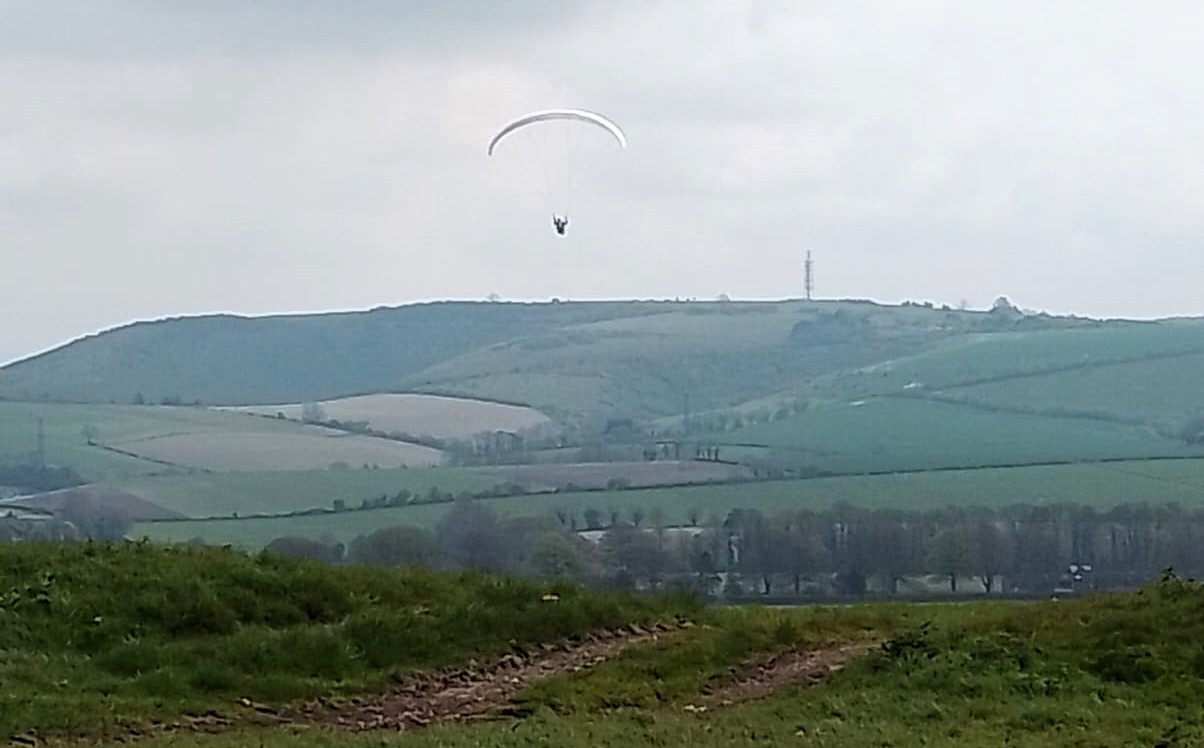
 Then one Sunday morning in May we realised the wind direction would be suitable for the Sky Surfers and as we were getting ready to fly we saw a couple of hang glider pilots arrive so we quickly got a few flights in before they launched. It was almost 11.30am before the first one got airborne at which point we all immediately landed and spent the next hour or so watching two hang gliders and two paragliders have some short flights. They came along well into ‘our’ airspace although they stayed fairly well forward over the ridge and model flying could have continued with care to not go forward to anywhere near them.
Then one Sunday morning in May we realised the wind direction would be suitable for the Sky Surfers and as we were getting ready to fly we saw a couple of hang glider pilots arrive so we quickly got a few flights in before they launched. It was almost 11.30am before the first one got airborne at which point we all immediately landed and spent the next hour or so watching two hang gliders and two paragliders have some short flights. They came along well into ‘our’ airspace although they stayed fairly well forward over the ridge and model flying could have continued with care to not go forward to anywhere near them.
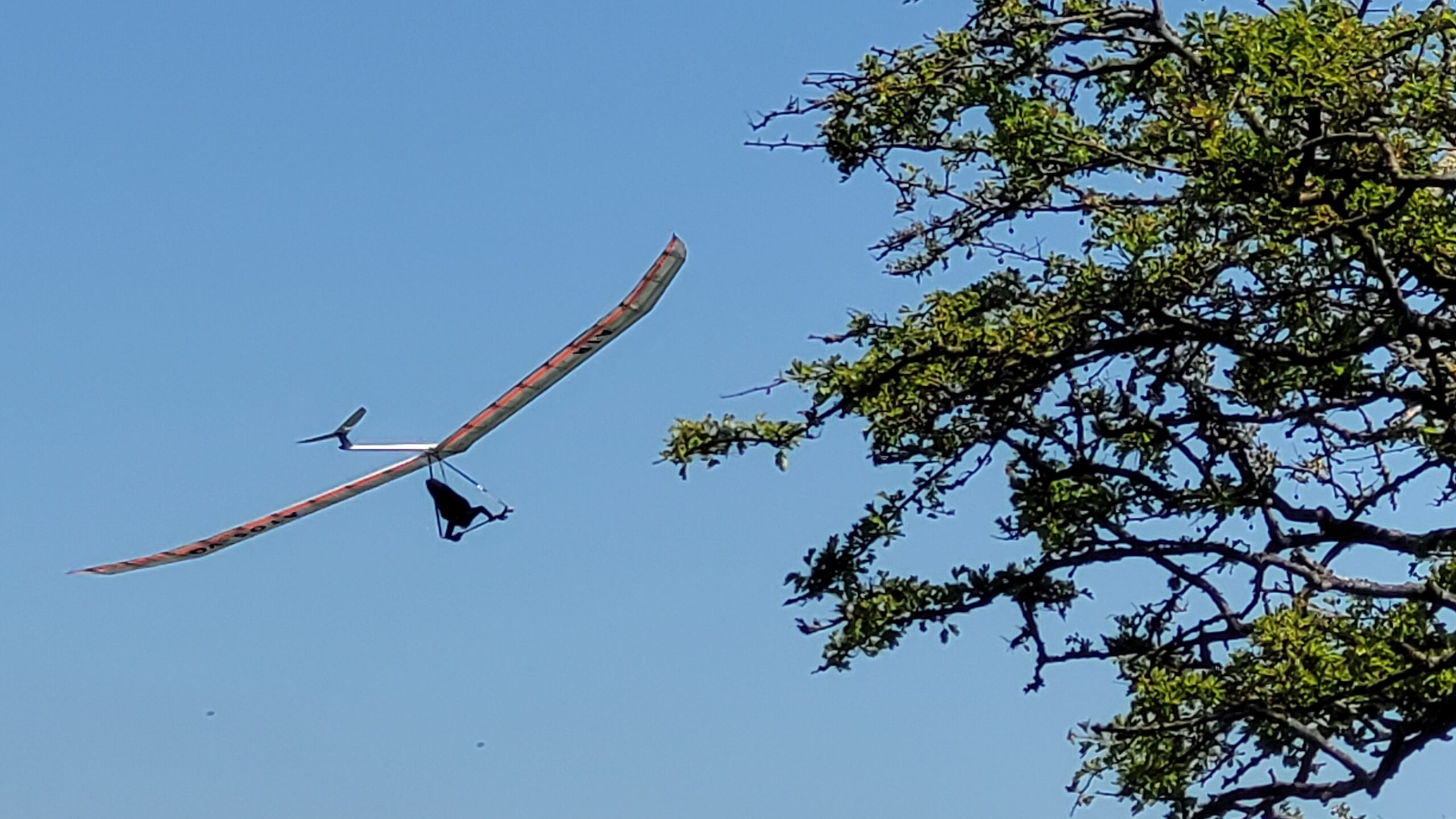
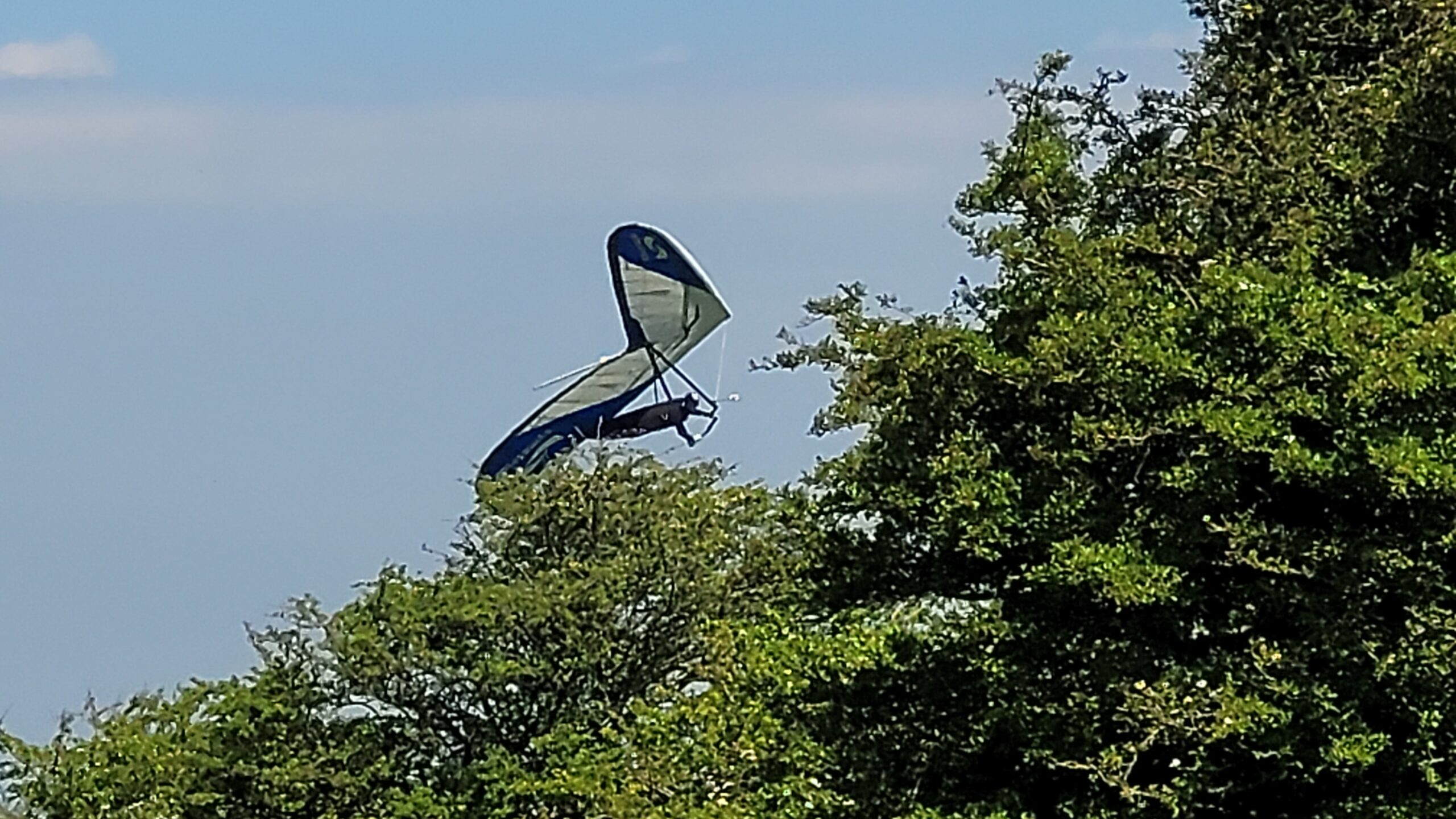 When we packed up 1066 went to chat with them and they explained that the conditions were marginal for them, hence their short flights. They said they would have been happy for us to have continued flying, ideally with a spotter to keep our pilots informed of their whereabouts. Several times the guy flying the blue and white hang glider looked as if he was about to stall and crash but he had come 5th in the World Championships apparently so he certainly knew what he was doing! It was interesting to watch them and as the wind direction is rarely suitable for them to fly I doubt they will be a problem for us very often.
When we packed up 1066 went to chat with them and they explained that the conditions were marginal for them, hence their short flights. They said they would have been happy for us to have continued flying, ideally with a spotter to keep our pilots informed of their whereabouts. Several times the guy flying the blue and white hang glider looked as if he was about to stall and crash but he had come 5th in the World Championships apparently so he certainly knew what he was doing! It was interesting to watch them and as the wind direction is rarely suitable for them to fly I doubt they will be a problem for us very often.
Those of you on the club WhatsApp group will have seen that Gordon Bennett has got his name in lights…well in letters and a photo anyway, when the RCM&E mag published this:
 Well done Gordon, it’s good to see you got a mention for PAM…oh hang on, you didn’t!
Well done Gordon, it’s good to see you got a mention for PAM…oh hang on, you didn’t!
Gordon has now got another new plane finished and ready to test fly. Well at around twenty five years old it’s not exactly new, and Gordon didn’t build it… I’ll let him explain:
At the club meeting in October last year Mark kindly ran an auction that included models from John Bourne’s collection. There was a rather beaten-up early monoplane for sale that no one had any interest in. I thought it looked interesting so picked it up for a tenner. The tail plane had fallen off and there were many holes in the tissue covering.  Inspecting the power train exposed kit built around a brushed motor and nicad battery.
Inspecting the power train exposed kit built around a brushed motor and nicad battery.
I hooked it up to my bench power supply to see if it was still running and it jumped into life. Jump is probably a reasonable word to use as the noise and vibration from the gearbox was phenomenal. The whole bench shook and most of my fillings dropped out. So, without any thought or planning I ripped the old setup out intending to go brushless. Some planning would have been prudent as John had built a dummy Anzani 3-cylinder radial around the original motor and gearbox which I definitely wanted to keep.
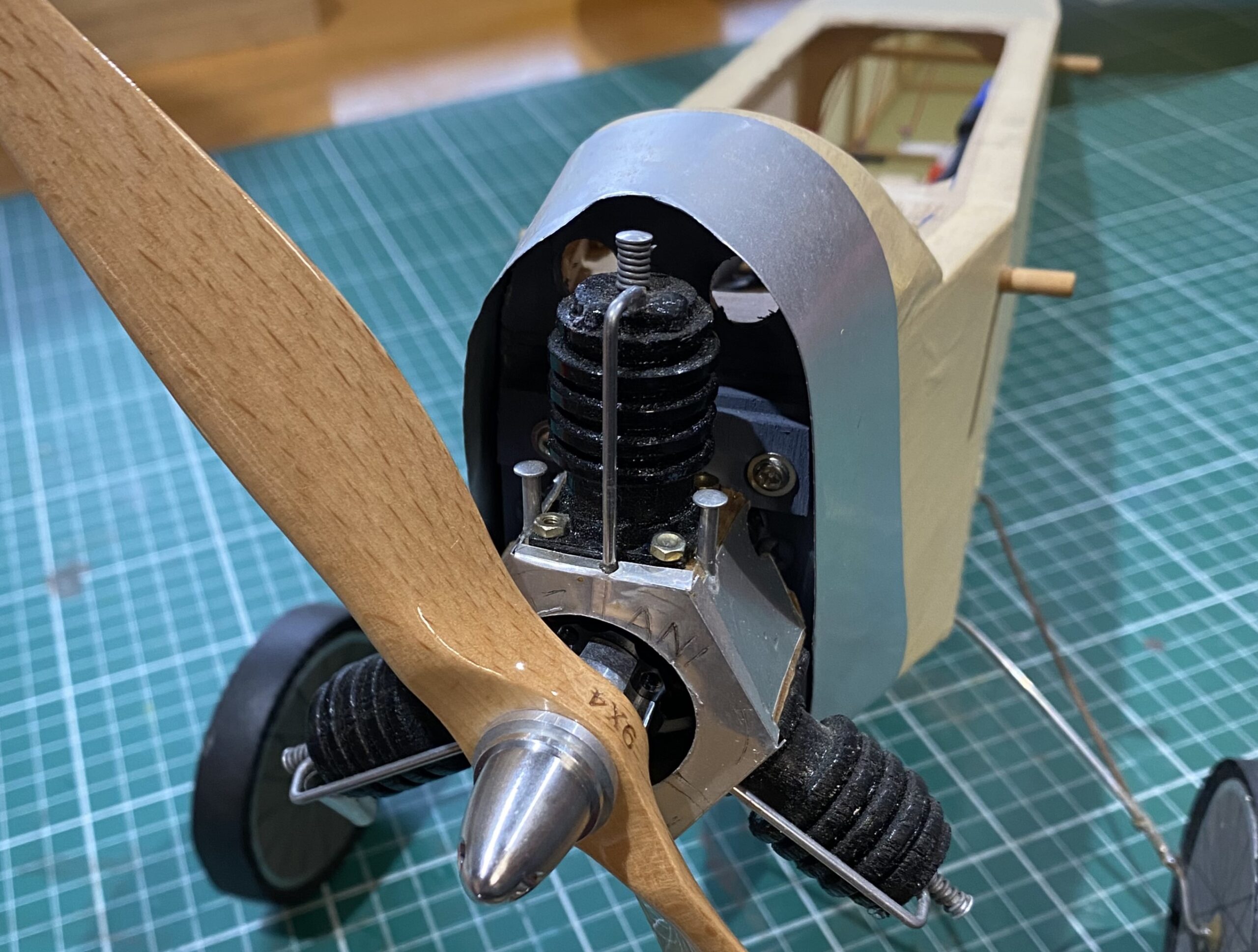 This meant I had a maximum diameter for the brushless motor, I figured I could accommodate varying depths. I got onto the phone and called my new best-mate George at 4-Max. ‘What is it?’ he wanted to know. No idea, I’ll send a photo. How much did it weigh, how much did the old powertrain weigh, had I thought about C of G. Of course I had. Only an idiot would etc etc…. George did his exhaustive questioning and calculating. I pretended everything was carefully planned. To this point we thought the plane might have been something created by John. It was similar to a Deperdussin or Eastbourne Monoplane but nothing matched exactly. Then out of the blue George called and said a mate had come round with an old plans book and they’d found it, a Fosdyke Flyer.
This meant I had a maximum diameter for the brushless motor, I figured I could accommodate varying depths. I got onto the phone and called my new best-mate George at 4-Max. ‘What is it?’ he wanted to know. No idea, I’ll send a photo. How much did it weigh, how much did the old powertrain weigh, had I thought about C of G. Of course I had. Only an idiot would etc etc…. George did his exhaustive questioning and calculating. I pretended everything was carefully planned. To this point we thought the plane might have been something created by John. It was similar to a Deperdussin or Eastbourne Monoplane but nothing matched exactly. Then out of the blue George called and said a mate had come round with an old plans book and they’d found it, a Fosdyke Flyer.
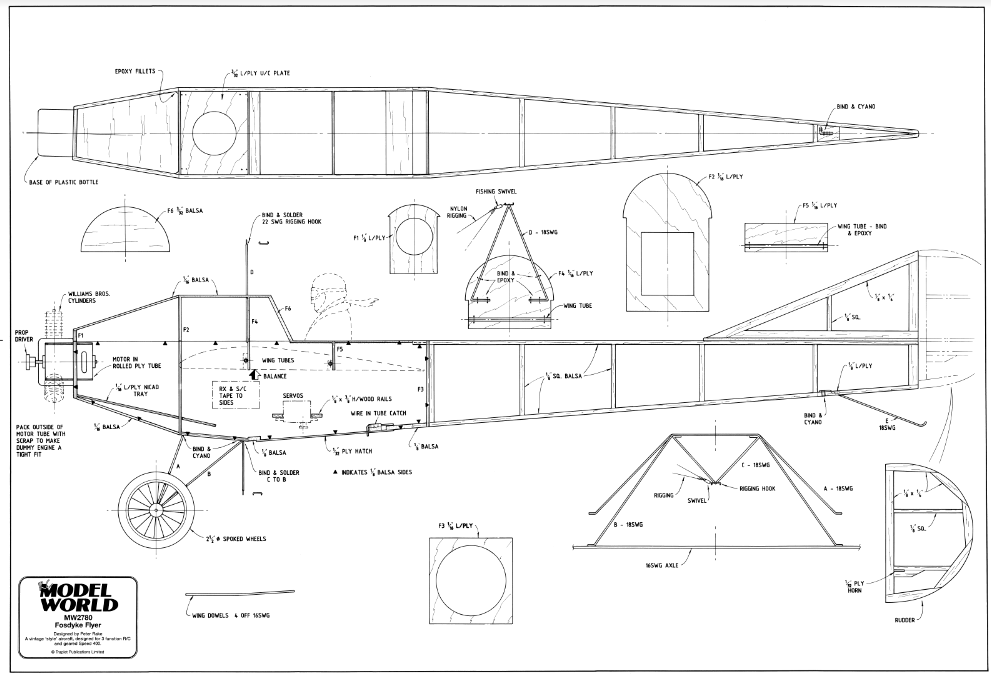
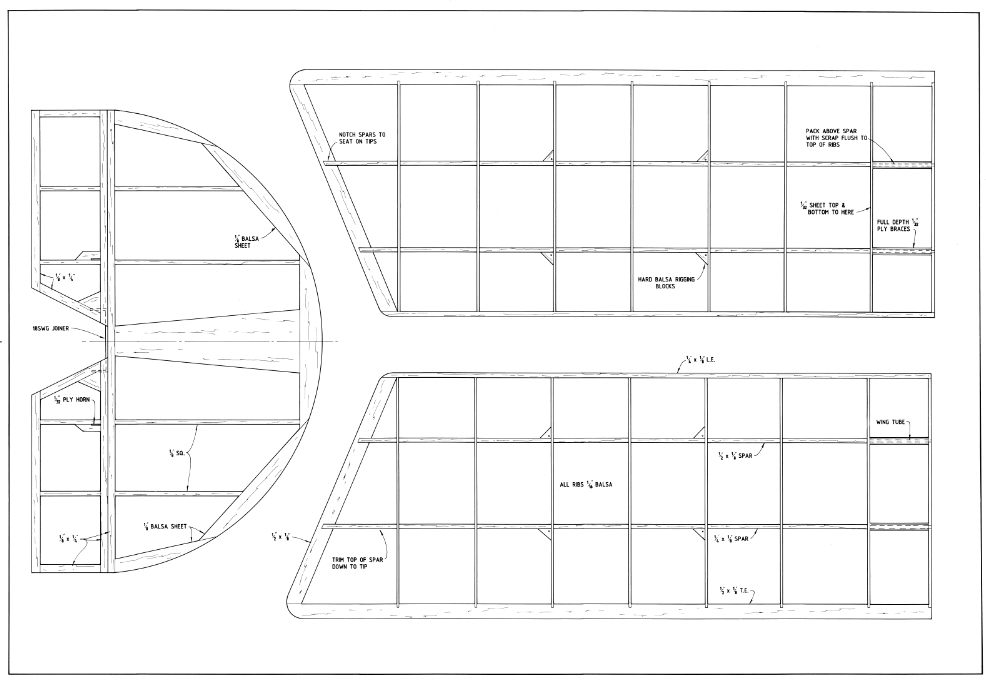 A free plan had been produced in RC Model World around March 2000. The plans were available on the net and it was clear there was lots of C of G thinking to be done.
A free plan had been produced in RC Model World around March 2000. The plans were available on the net and it was clear there was lots of C of G thinking to be done.
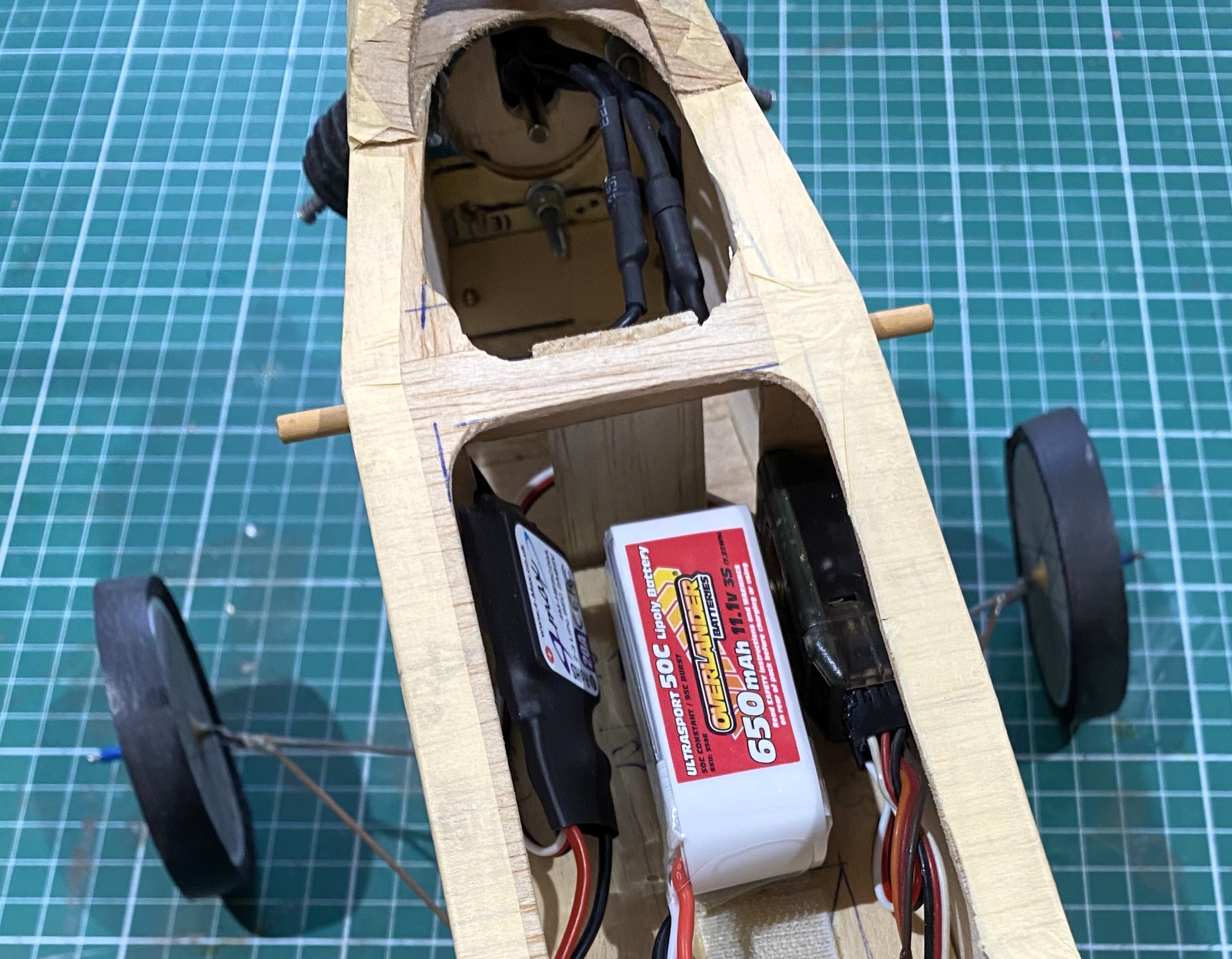 I had to create a new firewall bulkhead as the old motor had robbed me of any new mounting points for the new motor. This allowed me to shove everything as far forward as possible and now the Cof G is just behind the spar. The original article warns to keep the total weight below 25 oz and the author was pretty chuffed as his was just 20 oz. I know John got his in at 23 oz as its written on the plane in biro! With the advent of new technology and much better batteries the new set-up come in at just 16 oz, amazing how much has changed in 25 years. John changed the design a lot by making removable wings, separating the fuselage around the cockpit, also making it easy to get to the radio gear and battery. This does mean there’s no rigging wires on the underside of the wing… I’m assuming he beefed up the main spar at the wing root…. Did anyone ever see it fly?!!
I had to create a new firewall bulkhead as the old motor had robbed me of any new mounting points for the new motor. This allowed me to shove everything as far forward as possible and now the Cof G is just behind the spar. The original article warns to keep the total weight below 25 oz and the author was pretty chuffed as his was just 20 oz. I know John got his in at 23 oz as its written on the plane in biro! With the advent of new technology and much better batteries the new set-up come in at just 16 oz, amazing how much has changed in 25 years. John changed the design a lot by making removable wings, separating the fuselage around the cockpit, also making it easy to get to the radio gear and battery. This does mean there’s no rigging wires on the underside of the wing… I’m assuming he beefed up the main spar at the wing root…. Did anyone ever see it fly?!!
 It’s only rudder and elevator (none of those aileron things) and I only intend to fly it on very gentle days. Hopefully at 16 oz’s things won’t get too stressy around the wing root. As they say, watch this space. Thanks for that Gordon, I look forward to seeing it fly.
It’s only rudder and elevator (none of those aileron things) and I only intend to fly it on very gentle days. Hopefully at 16 oz’s things won’t get too stressy around the wing root. As they say, watch this space. Thanks for that Gordon, I look forward to seeing it fly.
If you’re worried about the lack of rigging wires on the underside just fly it inverted!
While I was away MacFly shot lots of video for me to use and he took this screenshot from one of them. The video shows that it was actually just a fleeting pass but the photo makes it look as if 1066 and Dougal are flying an inverted circuit together. 1066 is on top…
I didn’t forget PAM while I was away and I snapped this photo of five Britten-Norman Islanders sat at an airport. I’ve never seen a gaggle of Islanders like this before but as over eight hundred have been built it’s probably not really a particularly unusual sight.
 The first one to correctly name the location in the Comments section wins…er…nothing!
The first one to correctly name the location in the Comments section wins…er…nothing!
In the February 2022 Patch News I featured a new model that Woody had just bought, an XFly T-7A Red Hawk. I did the maiden flight and found that it only just got off our patch with the small wheels fitted. A few flights later Woody removed the undercarriage and the Red Hawk flew better after being hand launched and it belly landed with no problems.
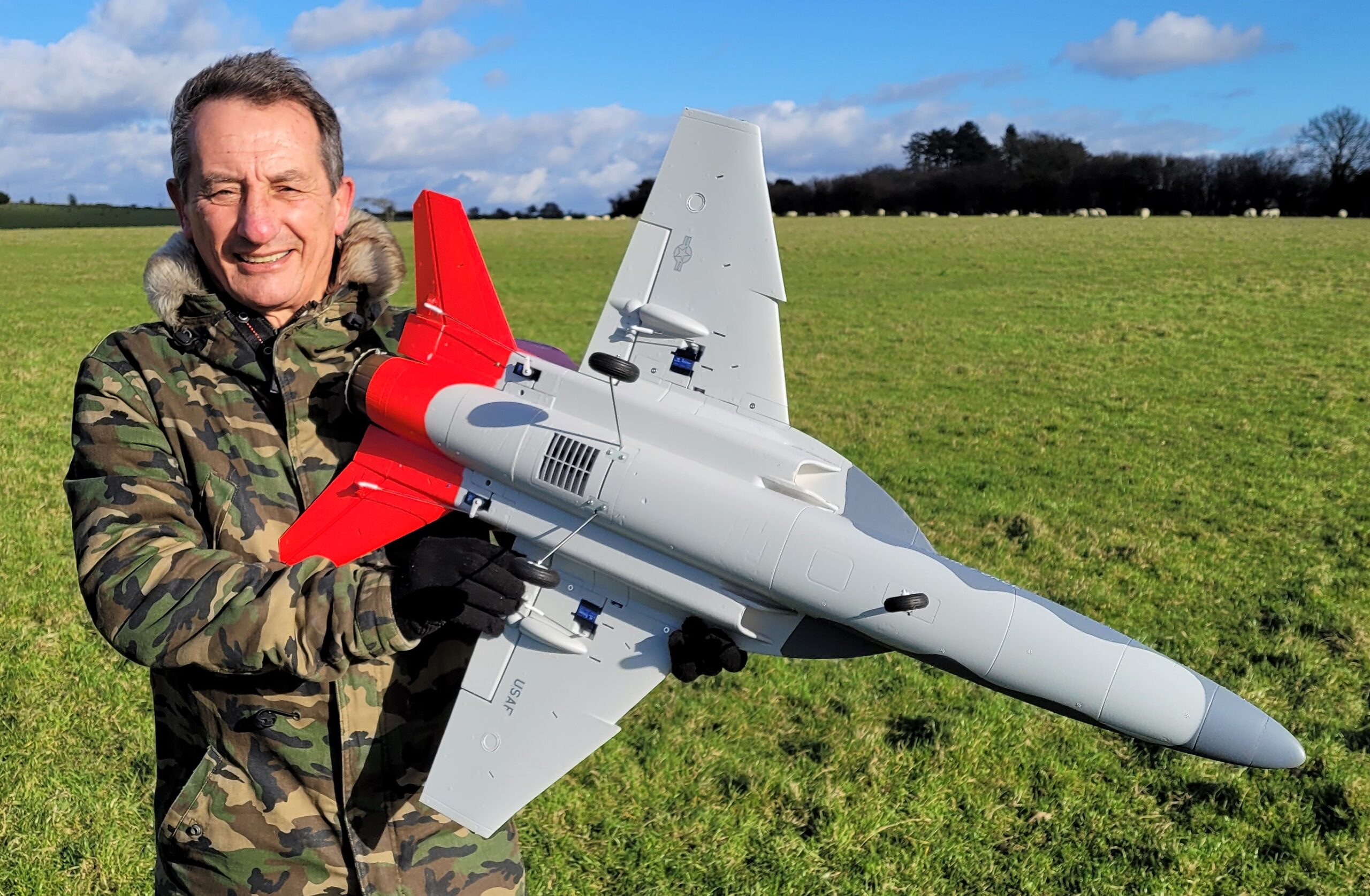
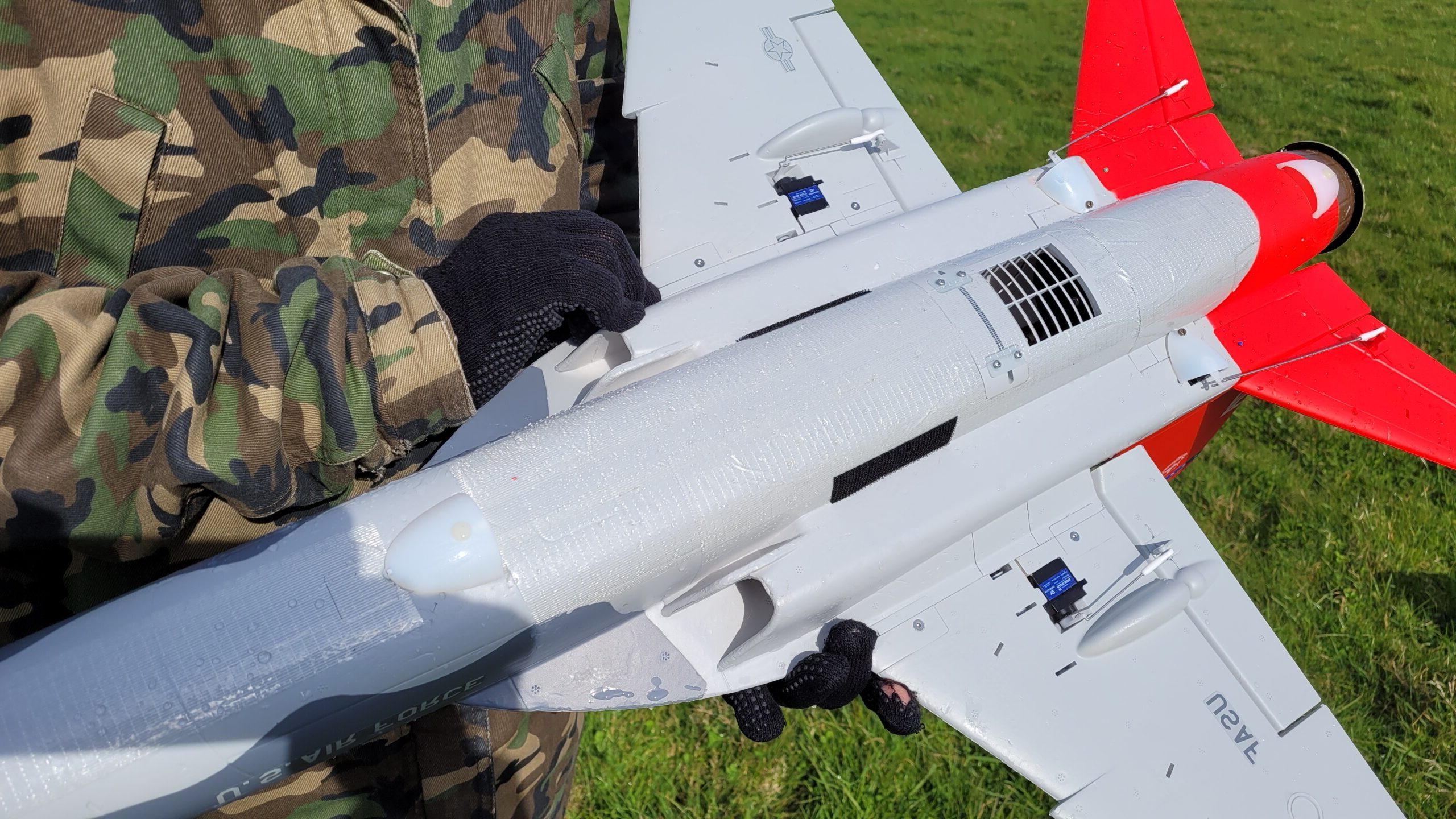 He struggled a bit with flying it himself so fitted an XFly gyro which helped but still found the model a bit of a handful and for the last couple of years it’s mostly been a hangar queen. This month Woody brought it along and I flew it again and it went well enough but I didn’t really feel at ease and Woody chose not to have a go on the controls. It’s sometimes difficult flying other people’s models as you are never sure if they’ve been set up in the best way and with the Red Hawk the gyro was an added complication as Woody was a bit vague about the different switch settings. Following the flight Woody offered it to me for a good price, saying he’d rather see me flying it than have it hanging up in his workshop.
He struggled a bit with flying it himself so fitted an XFly gyro which helped but still found the model a bit of a handful and for the last couple of years it’s mostly been a hangar queen. This month Woody brought it along and I flew it again and it went well enough but I didn’t really feel at ease and Woody chose not to have a go on the controls. It’s sometimes difficult flying other people’s models as you are never sure if they’ve been set up in the best way and with the Red Hawk the gyro was an added complication as Woody was a bit vague about the different switch settings. Following the flight Woody offered it to me for a good price, saying he’d rather see me flying it than have it hanging up in his workshop.
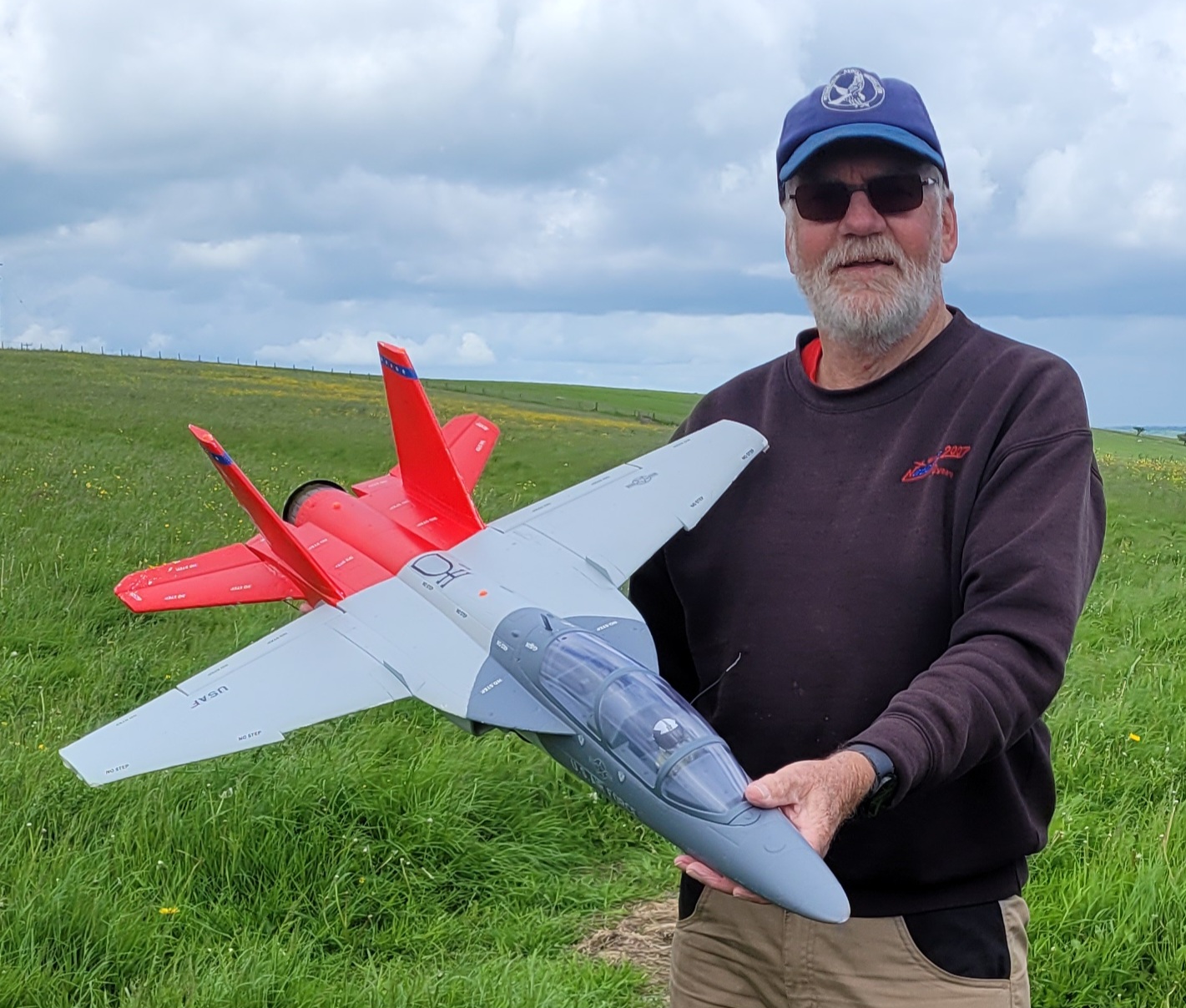 So I took the Red Hawk home and downloaded the manuals for the model and the gyro.
So I took the Red Hawk home and downloaded the manuals for the model and the gyro.
A few hours later I’d replaced Woody’s Spektrum receiver with a Multiplex one and had added the Red Hawk as a new model with the recommended settings on my transmitter.
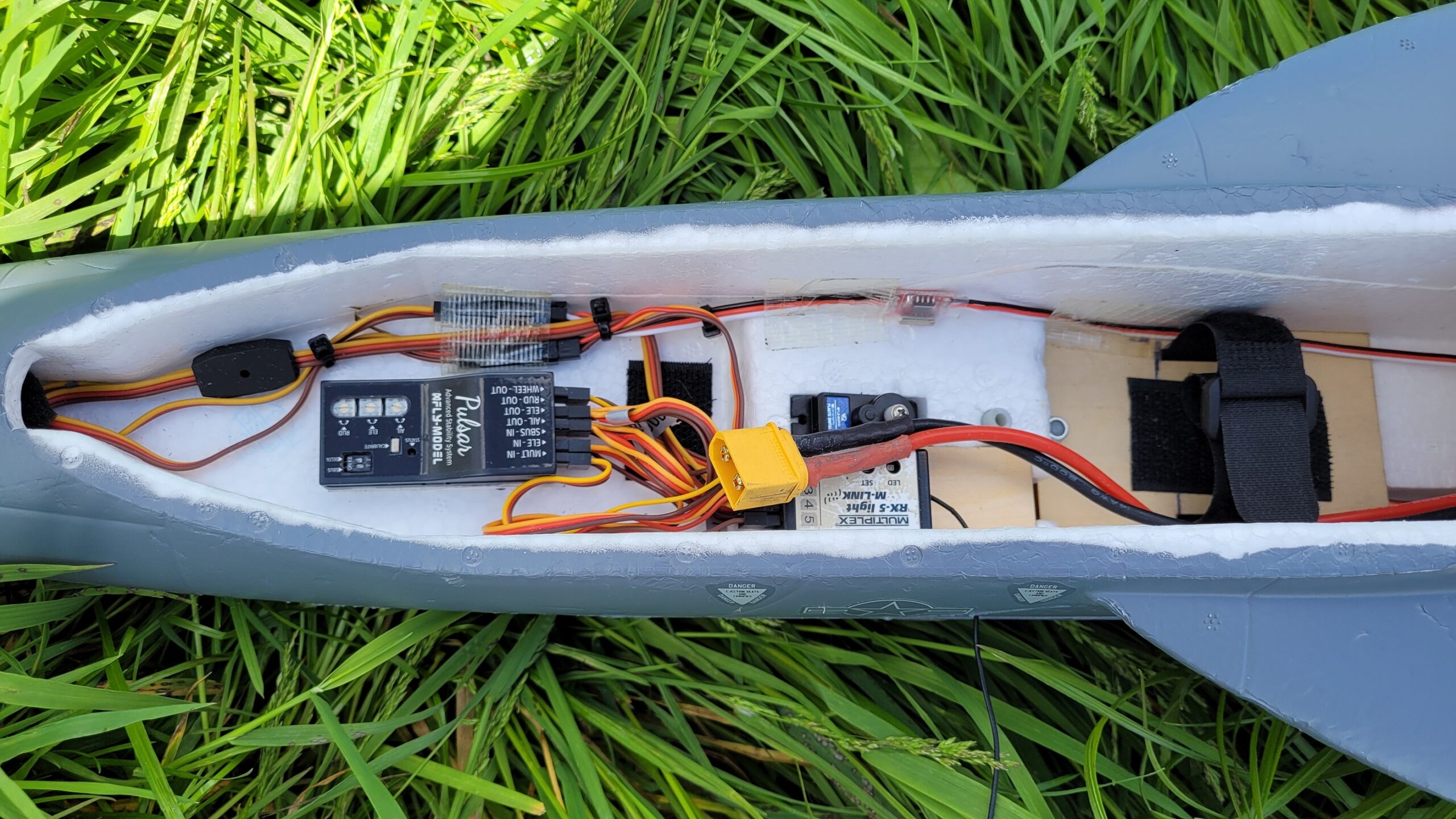 I had also set the gyro up correctly and assigned it to a three position switch with speech leaving no doubt about which mode was which. I have four suitable 4 cell 2200mAh batteries so I charged them up and the following day I had four flights with no problems, just a few small setting changes after each flight to get the characteristics to my liking.
I had also set the gyro up correctly and assigned it to a three position switch with speech leaving no doubt about which mode was which. I have four suitable 4 cell 2200mAh batteries so I charged them up and the following day I had four flights with no problems, just a few small setting changes after each flight to get the characteristics to my liking.
On 17th May 1066 reached the grand old age of 65 and he promised to bring us some cakes at the patch, but he failed to deliver so as a penance I’ve made him write for Patch News: Over the last month or so I have had a hankering for an out and out fun fly model. Searching the internet did not give many options, i.e. Weston UK Cougar, Slec Limbo dancer, Balsa Cabin Funfly. However there was one other that looked interesting, this was Evolution Models Fusion range, which comprises the Micro Fusion, Fusion V2, Fusion V3, and the Mega Fusion. To be honest I don’t like the look of the model, but the V2 had won everything in it’s class in the UK during the 2019 season, and was the mid-priced option at £99.00 plus £9.99 delivery so this is the version I decided to buy, the order was placed, and the model duly arrived a few days later. Not so long ago you could spend a lot less and the postman would be completely hidden by the box of your new toy so the skinny one that arrived was a bit of disappointment. I suppose it’s bigger than the plastic bag it could end up in. Disappointment aside let’s see what’s inside.
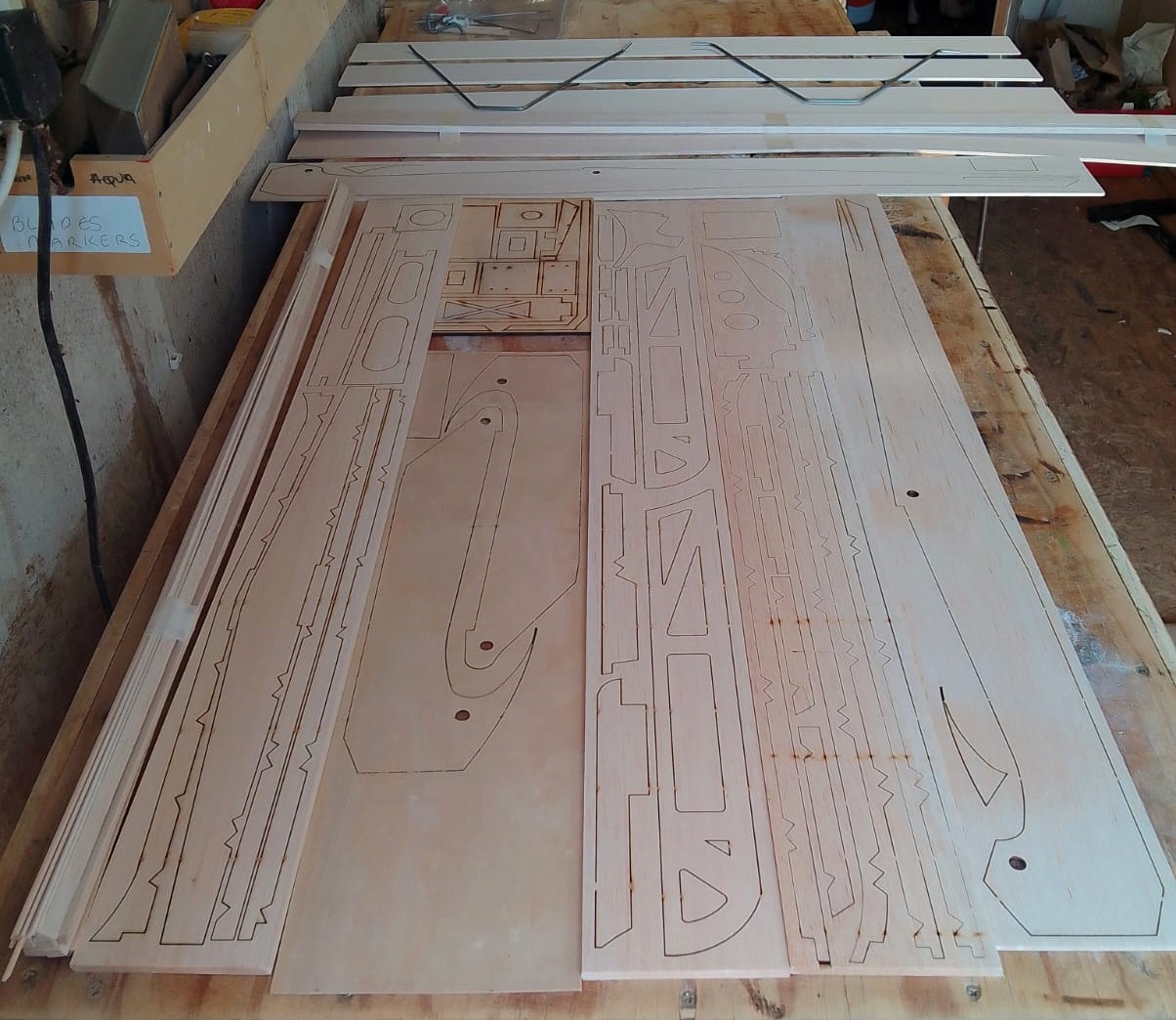 Or not as it turns out, starting with what you don’t get, there are no instructions you have to download these as a PDF, there is no plan, that’s right, there really is no plan at all, and no wheels. You do get a box of strip wood, sheet stock, a bag of good quality hardware, and some very nice laser cut parts, in both ply and 6mm balsa, all of which has been graded perfectly for its respective job. The laser cutting is superb, with 1.5mm tabs holding the parts in place. A small criticism is none of the parts are numbered, also the parts needed to build the tailplane for instance, are all on different sheets, so it took me a little time using the PDF instructions on my phone to identify all the parts.
Or not as it turns out, starting with what you don’t get, there are no instructions you have to download these as a PDF, there is no plan, that’s right, there really is no plan at all, and no wheels. You do get a box of strip wood, sheet stock, a bag of good quality hardware, and some very nice laser cut parts, in both ply and 6mm balsa, all of which has been graded perfectly for its respective job. The laser cutting is superb, with 1.5mm tabs holding the parts in place. A small criticism is none of the parts are numbered, also the parts needed to build the tailplane for instance, are all on different sheets, so it took me a little time using the PDF instructions on my phone to identify all the parts.
The other unusual feature is the wing ribs are made of Depron.
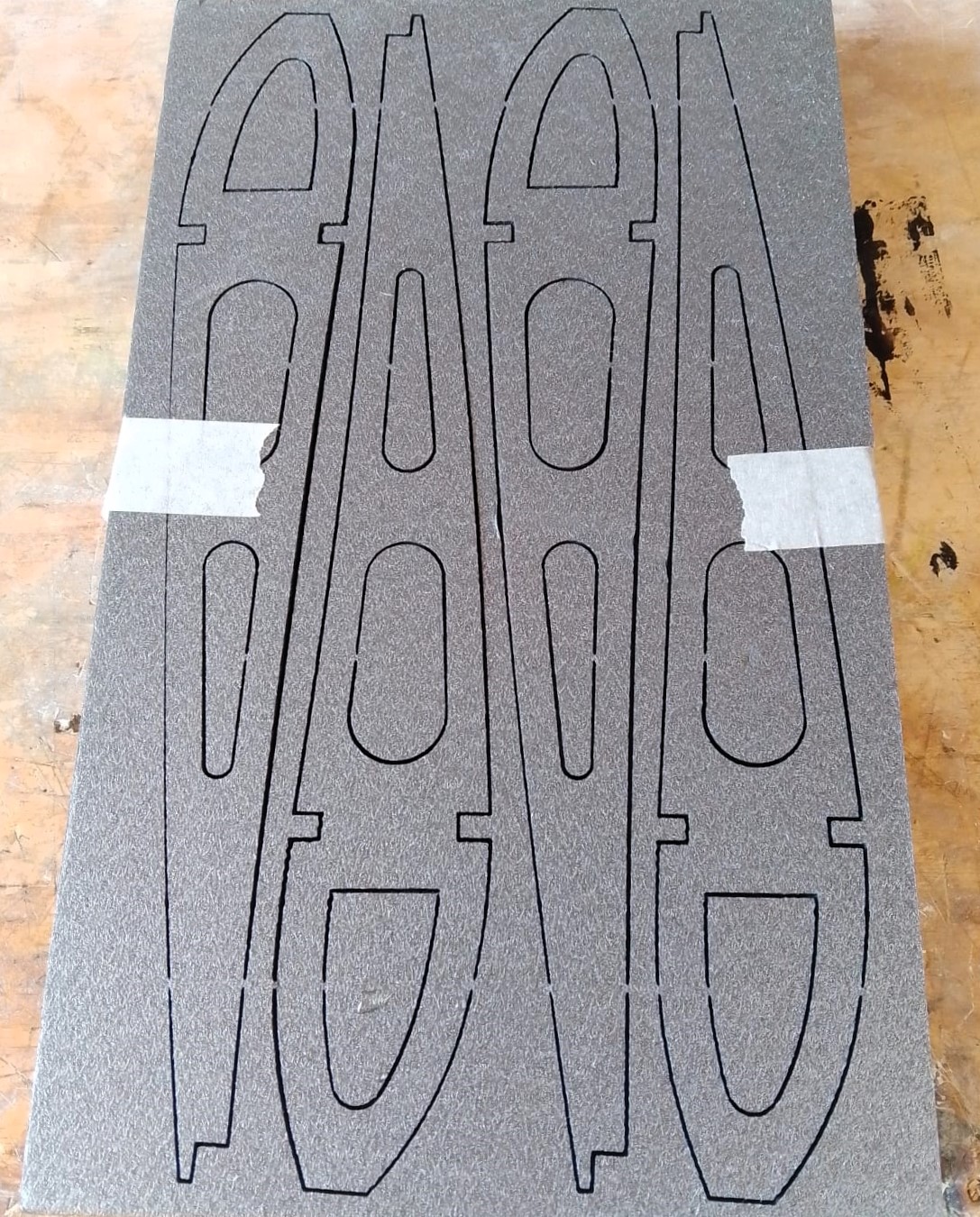 With all the materials laid out on the bench, I felt a bit better about my £110.00 spend, and when you take into account the amount of thought the designers have given to producing a traditional builders kit, but have removed the hassle of cutting out all the fiddly parts, it’s not so bad. I decided to start the build with the tail feathers, having identified the parts required they were released from the sheets, and as can be seen in the photos, needed almost no fettling to make them fit. My next concern was the amount of carbon on the edges of these parts where they join, may affect the integrity of the joint.
With all the materials laid out on the bench, I felt a bit better about my £110.00 spend, and when you take into account the amount of thought the designers have given to producing a traditional builders kit, but have removed the hassle of cutting out all the fiddly parts, it’s not so bad. I decided to start the build with the tail feathers, having identified the parts required they were released from the sheets, and as can be seen in the photos, needed almost no fettling to make them fit. My next concern was the amount of carbon on the edges of these parts where they join, may affect the integrity of the joint.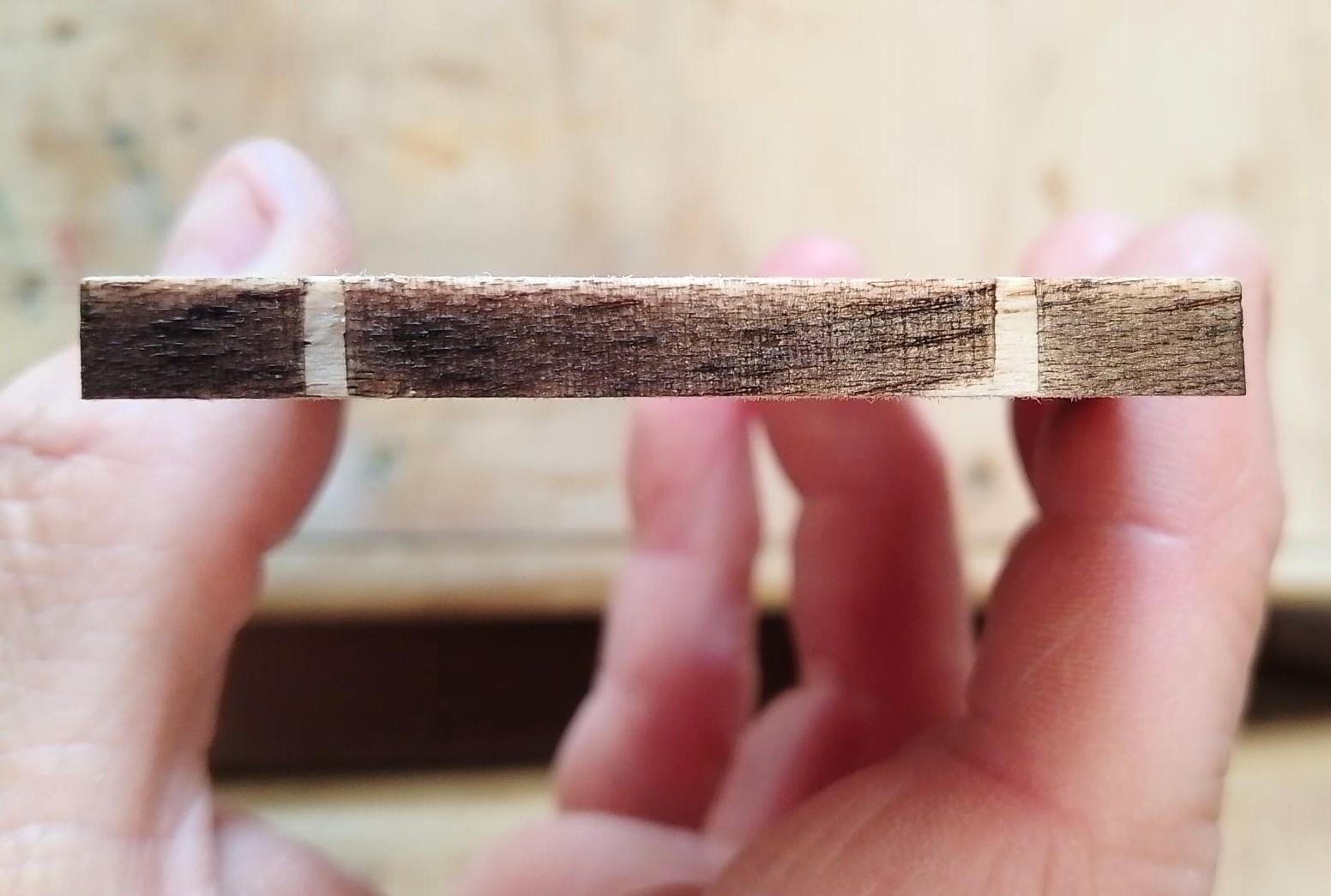
I felt it would be a shame to spoil those perfectly square edges trying to remove the carbon with sand paper, so I tried joining some scrap with super glue without removing the carbon, and I’m happy to report the joint strength was more than adequate.
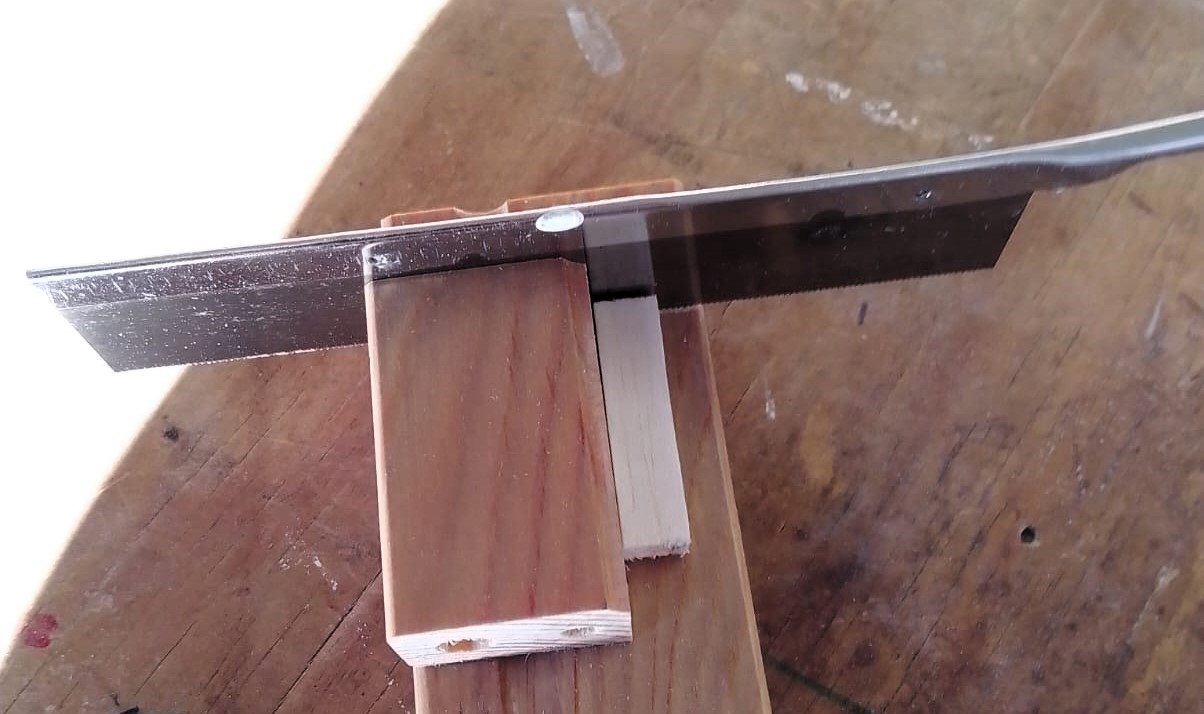 The outline of the tail and elevator is made up from 10 laser cut parts plus cross bracing cut from 9 x 6mm soft wood strip. I don’t own a mitre block for my razor saw so after a minute’s thinking and another minute with the chop saw I made a little cutting jig, which made cutting nice square ends on the cross bracing a breeze. Two hours after opening the box, including taking photos etc, I had a completed tail.
The outline of the tail and elevator is made up from 10 laser cut parts plus cross bracing cut from 9 x 6mm soft wood strip. I don’t own a mitre block for my razor saw so after a minute’s thinking and another minute with the chop saw I made a little cutting jig, which made cutting nice square ends on the cross bracing a breeze. Two hours after opening the box, including taking photos etc, I had a completed tail.
 Thanks 1066, it looks good so far and I’m looking forward to next month’s instalment.
Thanks 1066, it looks good so far and I’m looking forward to next month’s instalment.
We can always rely on Norwegian Nick to produce a beautifully finished model and in May he turned up to fly with an exceptional one, a very realistic two metre wingspan Eagle!
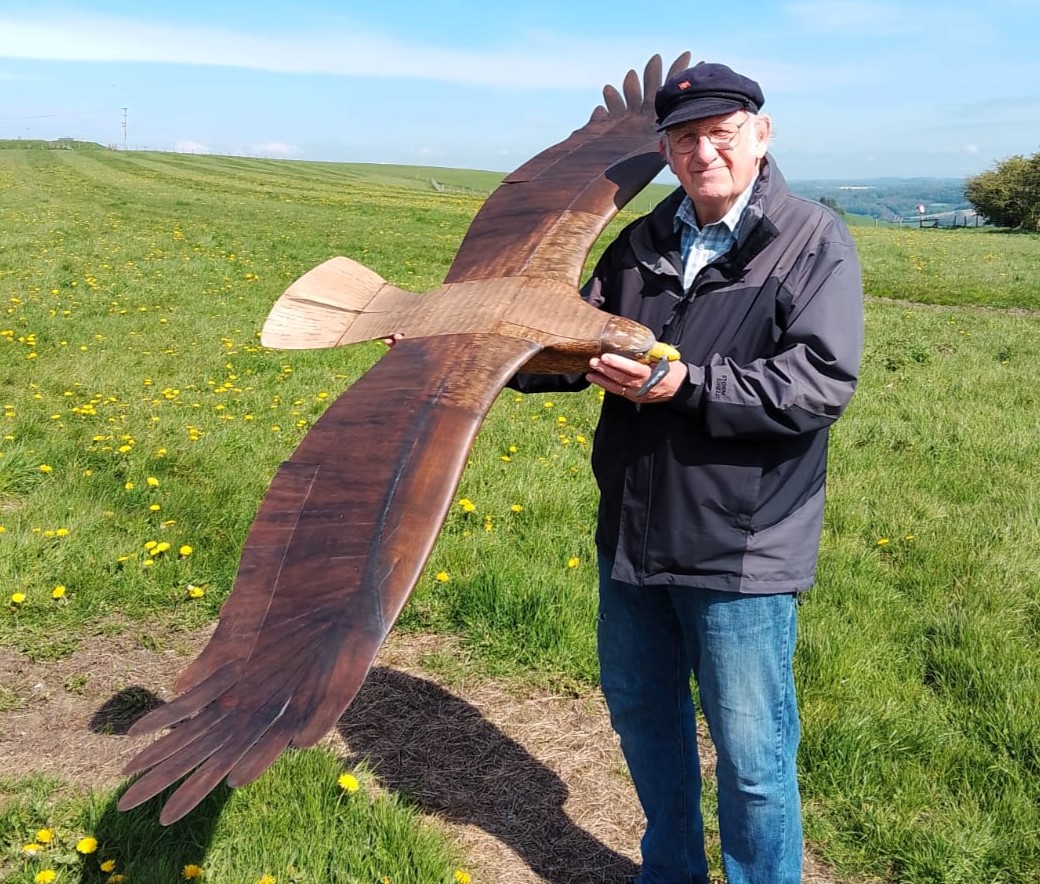
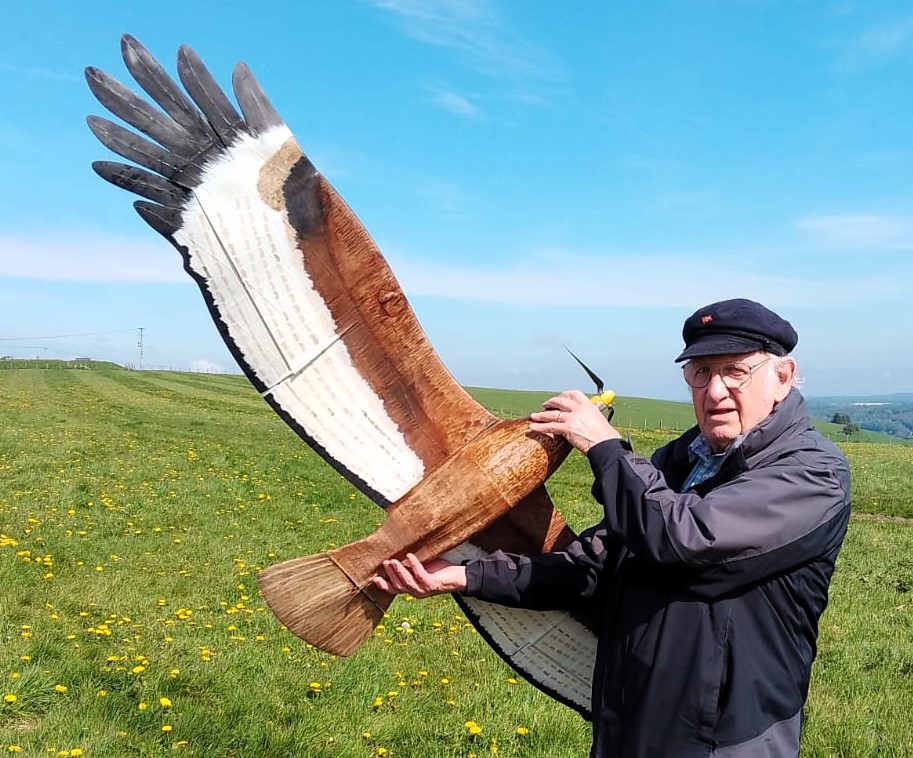 The design is from the Plane Print website (planeprint.com/eagle) and it’s a 3D printed plastic model. There are a lot of parts and they were all printed for Nick by his son Shaun.
The design is from the Plane Print website (planeprint.com/eagle) and it’s a 3D printed plastic model. There are a lot of parts and they were all printed for Nick by his son Shaun. 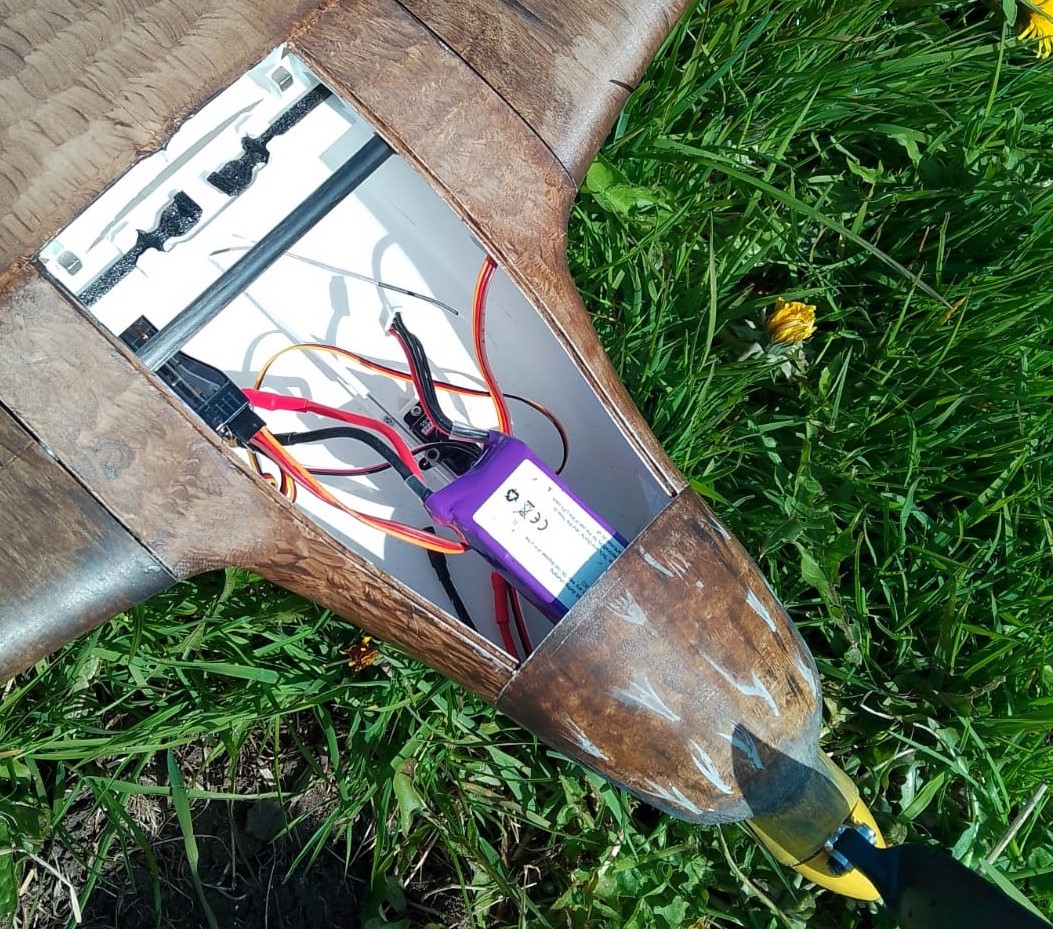 You really need to visit the website to see how it’s done, there’s loads of info including a build by a guy named Troy MacMillan who does a video of him constructing and flying it. The plastic is white so Nick had to do all the painting and he made a fantastic job of it.
You really need to visit the website to see how it’s done, there’s loads of info including a build by a guy named Troy MacMillan who does a video of him constructing and flying it. The plastic is white so Nick had to do all the painting and he made a fantastic job of it.
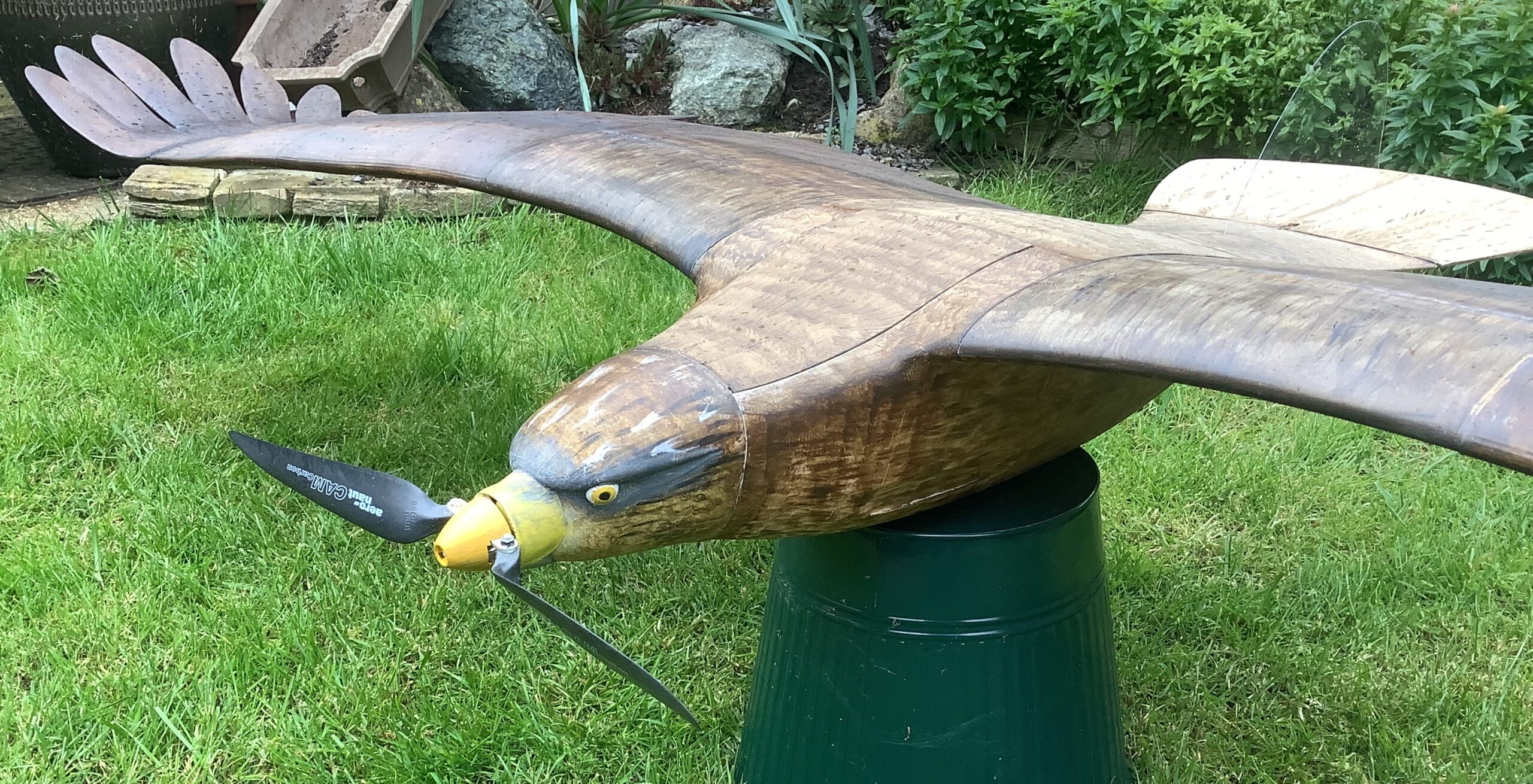
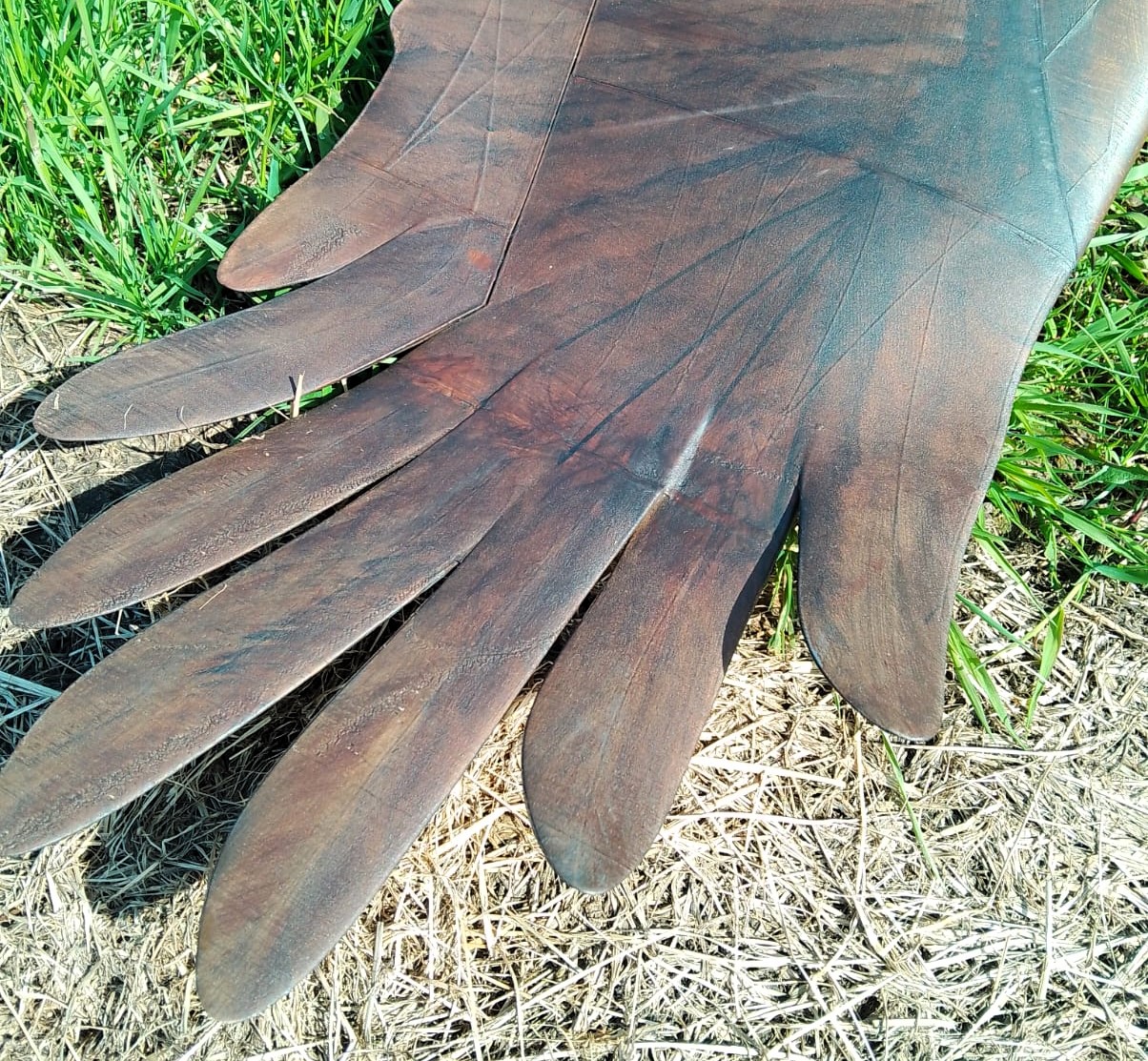 On it’s maiden flight the Eagle went away from the launch but unfortunately crashed shortly afterwards. This is what Nick says: On the test flight, after launch I was trying to trim it out but it started to do its own thing, loop the loop and was uncontrollable.
On it’s maiden flight the Eagle went away from the launch but unfortunately crashed shortly afterwards. This is what Nick says: On the test flight, after launch I was trying to trim it out but it started to do its own thing, loop the loop and was uncontrollable. 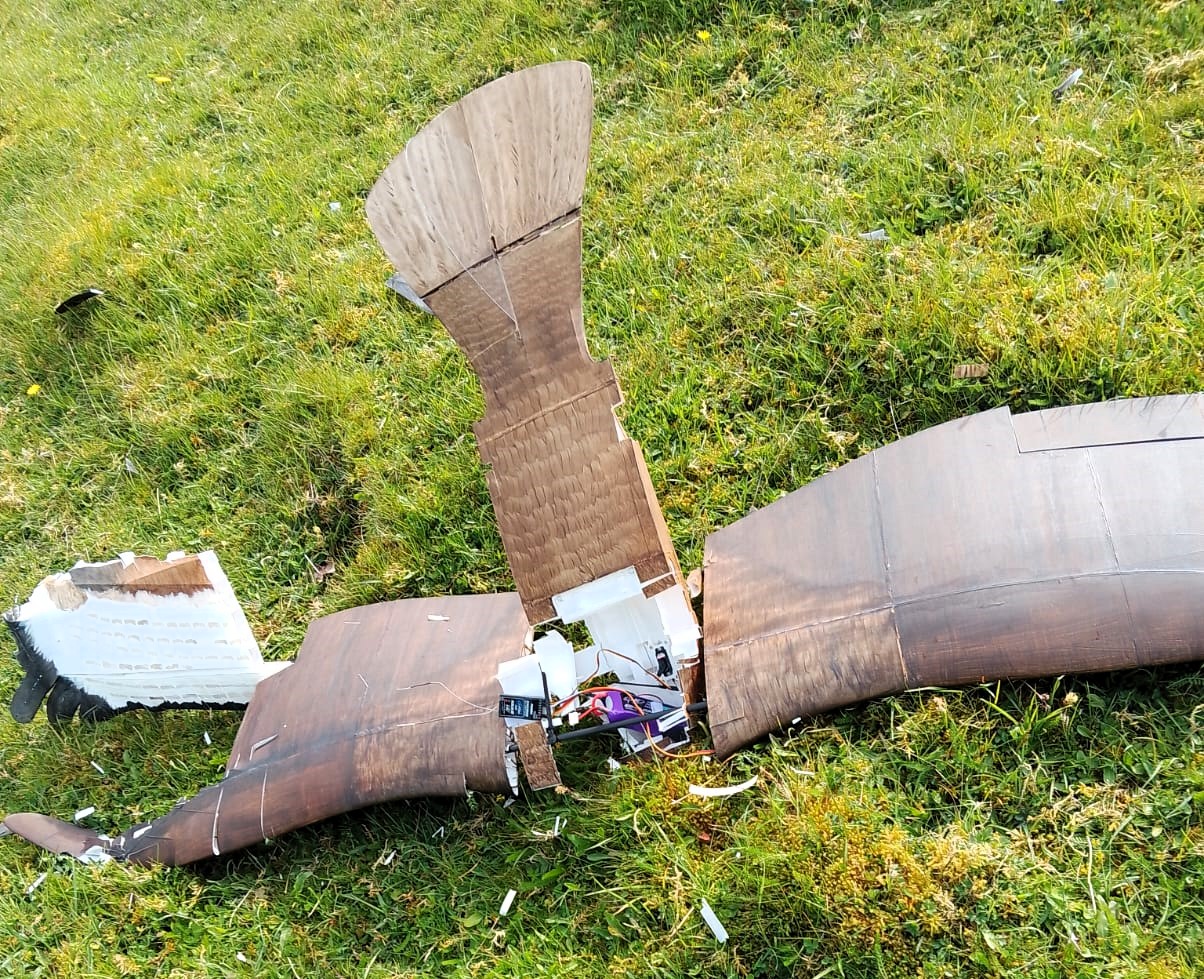 Anyway it buried itself in the valley and is non-repairable. Everything went into a bin liner and I took it home. All servos, motor and battery were salvaged but when I went to take out the aileron servo I noticed that the grub screw which held the pushrod attached to the servo arm was missing. Aargh, I think the unfortunate missing screw explains everything Nick but at least the cause of the crash is probably known. Nick says that he’s hoping Shaun will print him a replacement next month, I’m looking forward to seeing it.
Anyway it buried itself in the valley and is non-repairable. Everything went into a bin liner and I took it home. All servos, motor and battery were salvaged but when I went to take out the aileron servo I noticed that the grub screw which held the pushrod attached to the servo arm was missing. Aargh, I think the unfortunate missing screw explains everything Nick but at least the cause of the crash is probably known. Nick says that he’s hoping Shaun will print him a replacement next month, I’m looking forward to seeing it.
Here are a few excellent action shots that Kryten kindly took for us this month: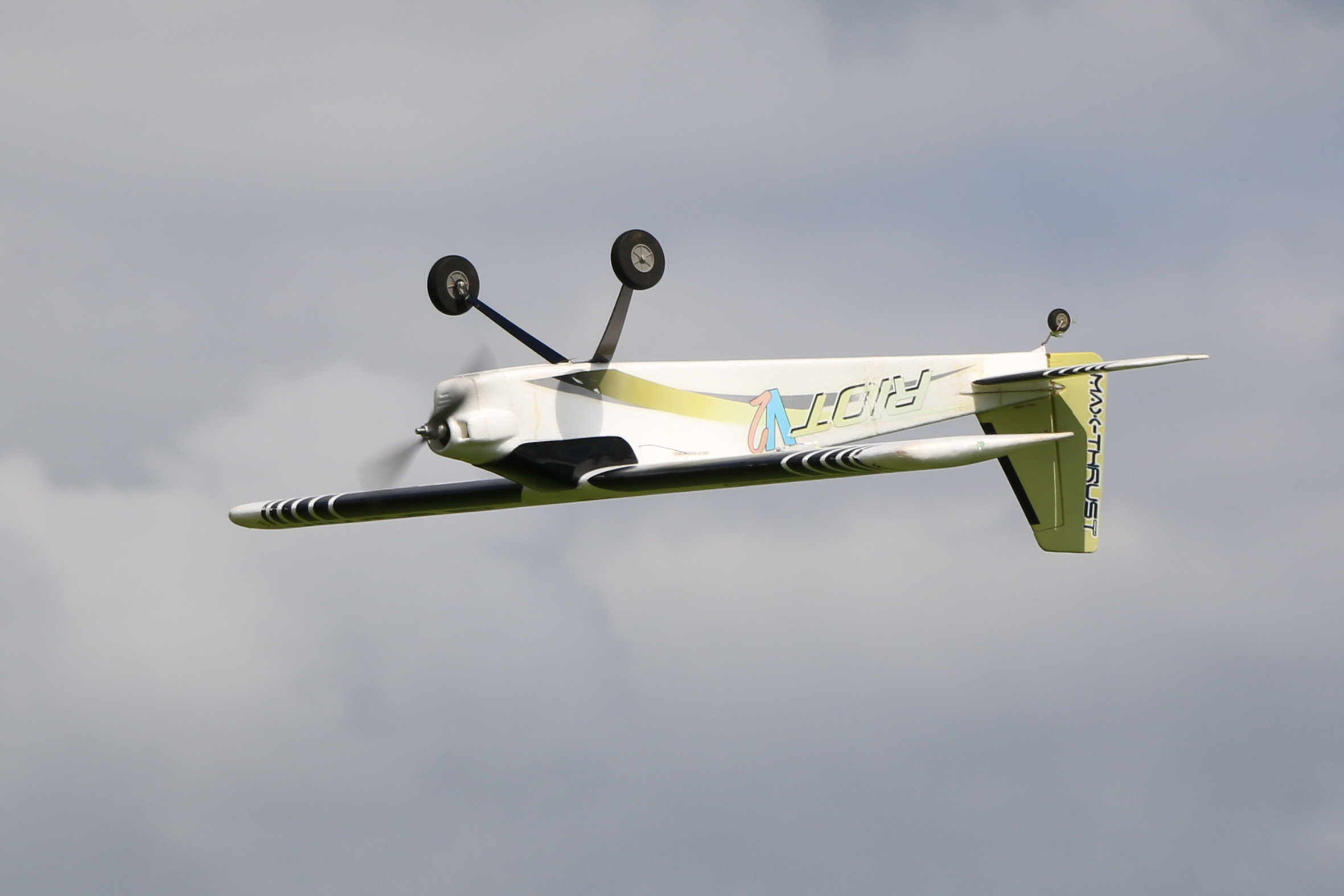
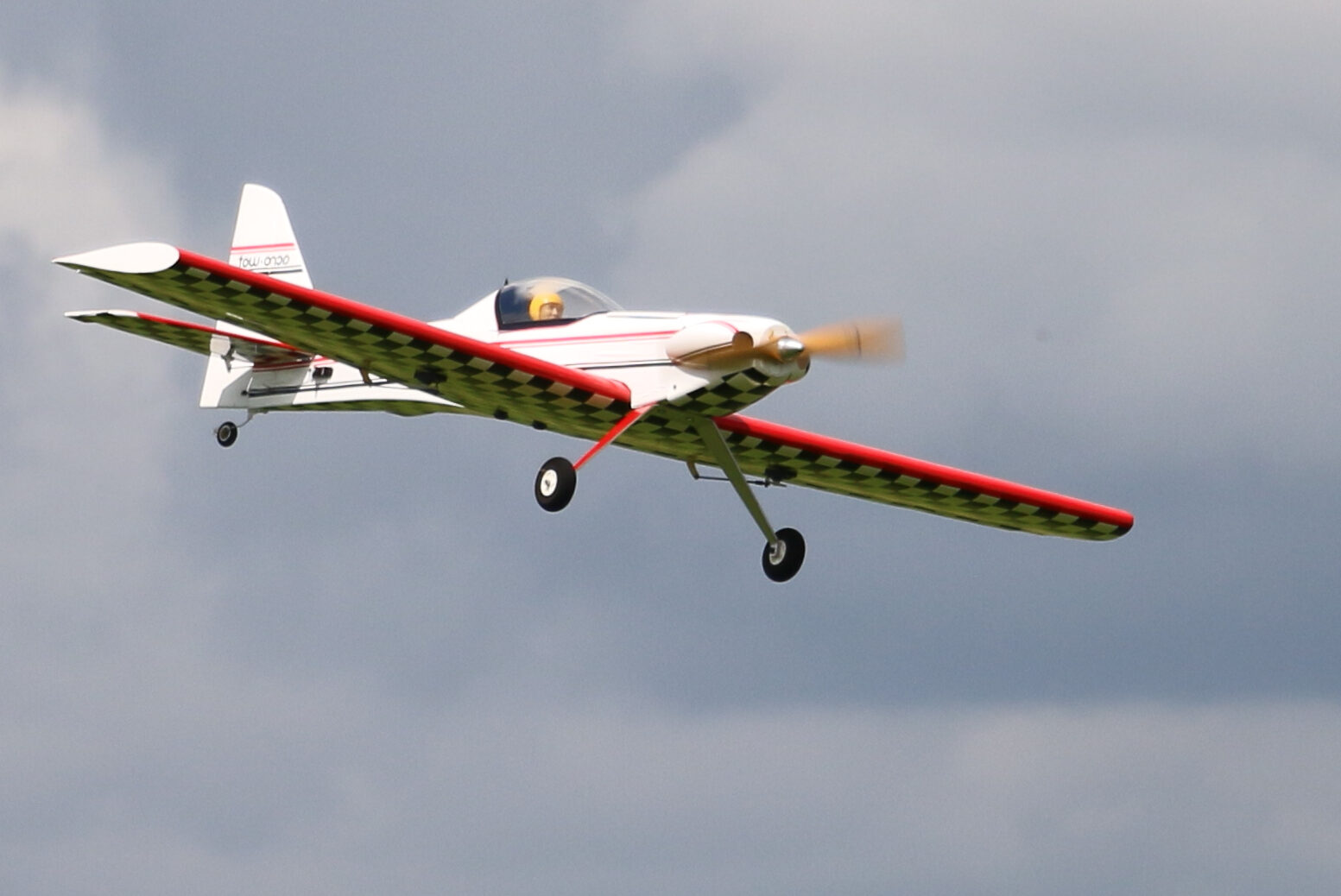



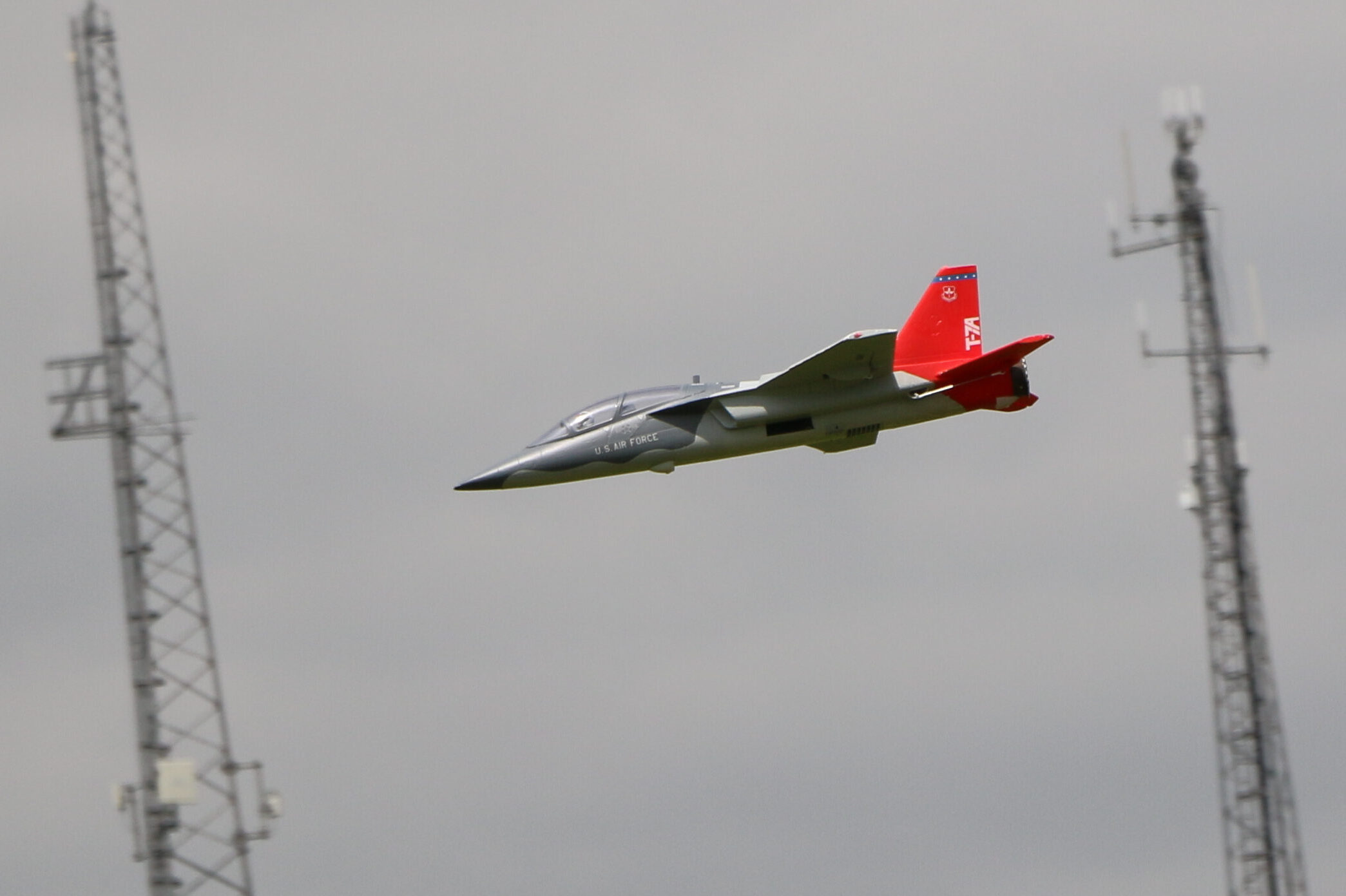
Video time now this month with footage taken by me, MacFly, and Dougal Entendre. Please watch the video full screen, it’s so much better with small models flying around:
If the video won’t play for you please click HERE
This month the end ‘joke’ is a bit sensitive so I’ve protected it with a Captcha image:
Colin Cowplain
Patch News – April 2024
At last, the weather seems to be improving. It’s certainly still spring like and some days we have had all four seasons in one day but there have been quite a few good flying days.
The parking area that was very mucky has dried out a lot and the wood chippings that the farmer laid down for us last month have made the situation very much better. The farmer rolled the whole field (except our patch) while some of us were flying on 18th March.
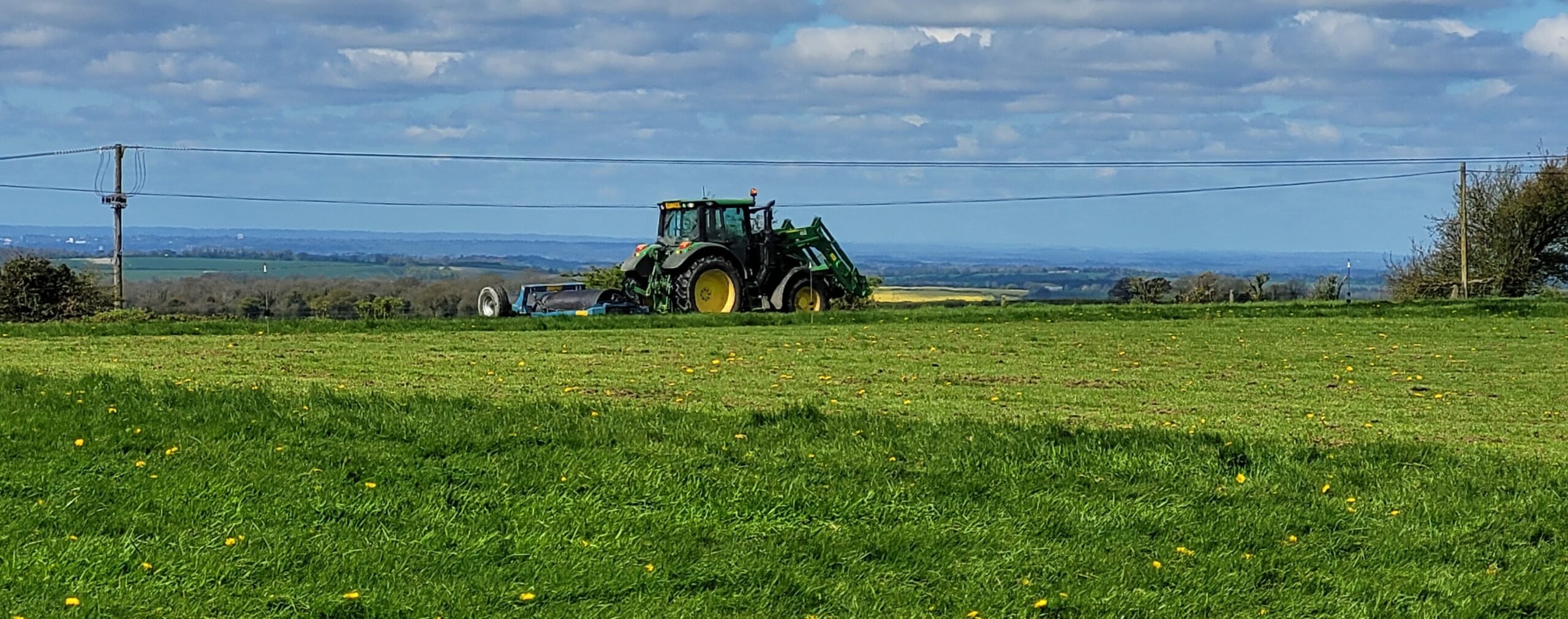 The driver saw us arriving and kindly rolled our pits area as we were walking down from the car park so we didn’t need to move our stuff out of his way. We were able to fly as usual, just being careful to avoid the tractor on take-off and landing, it was bigger than us!
The driver saw us arriving and kindly rolled our pits area as we were walking down from the car park so we didn’t need to move our stuff out of his way. We were able to fly as usual, just being careful to avoid the tractor on take-off and landing, it was bigger than us!
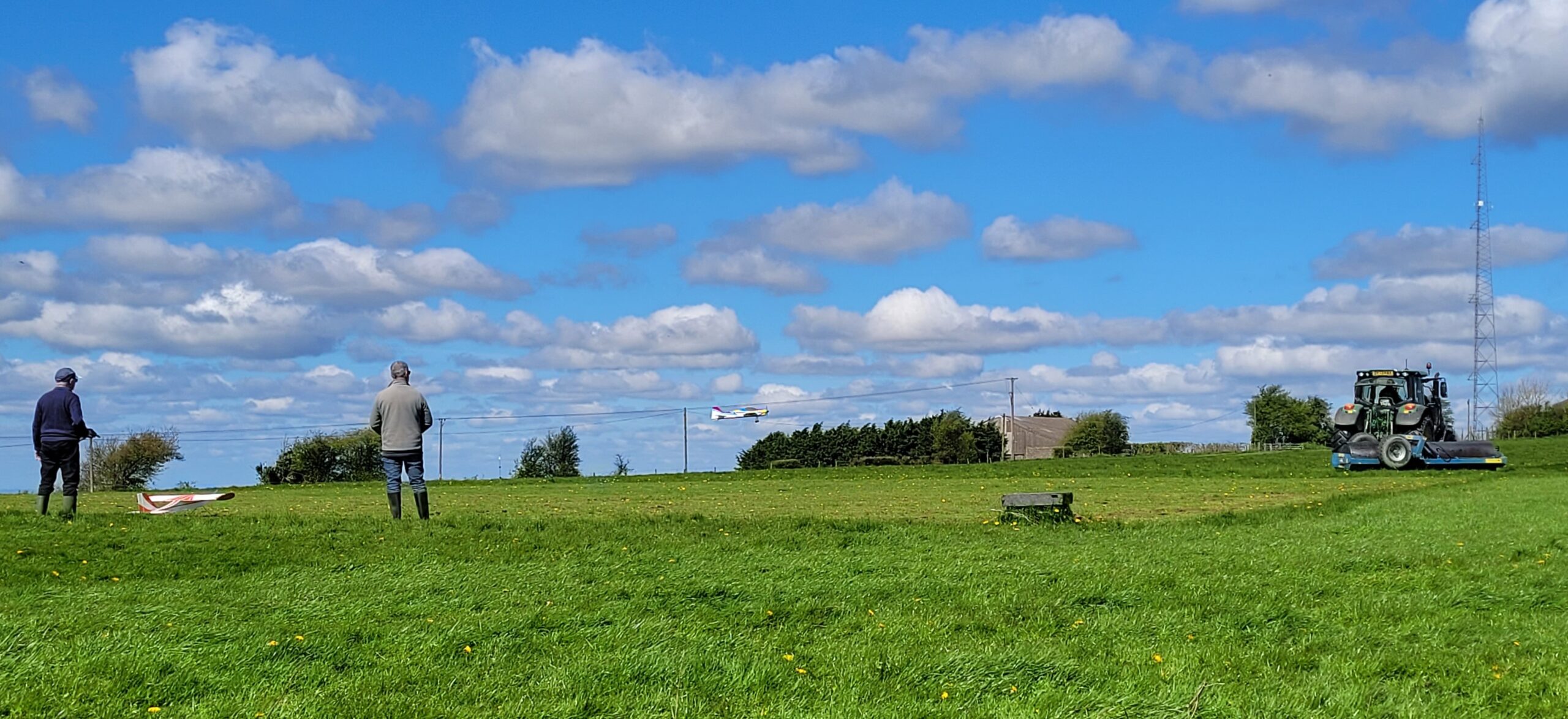 Captain Slow has been diligently looking after the fence batteries and changing them when required with the Woody’s help. Hopefully Captain Slow will be flying with us again soon. We mowed the patch several times in April, and despite the increase in size over the old one it only takes about 45 minutes using both mowers so it’s not too much of a problem. What was a problem was that the older mower decided it had mown enough and died.
Captain Slow has been diligently looking after the fence batteries and changing them when required with the Woody’s help. Hopefully Captain Slow will be flying with us again soon. We mowed the patch several times in April, and despite the increase in size over the old one it only takes about 45 minutes using both mowers so it’s not too much of a problem. What was a problem was that the older mower decided it had mown enough and died. 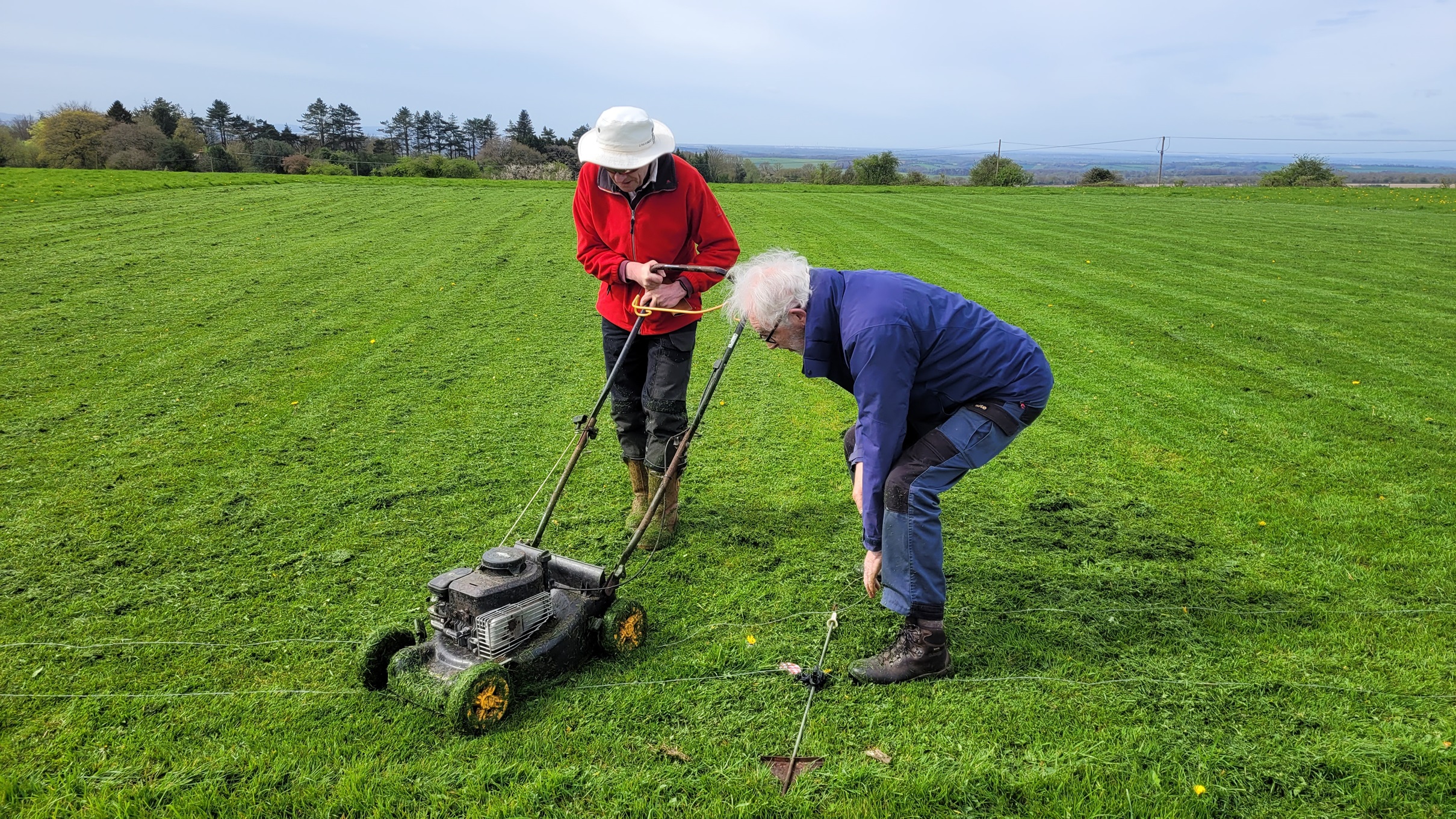
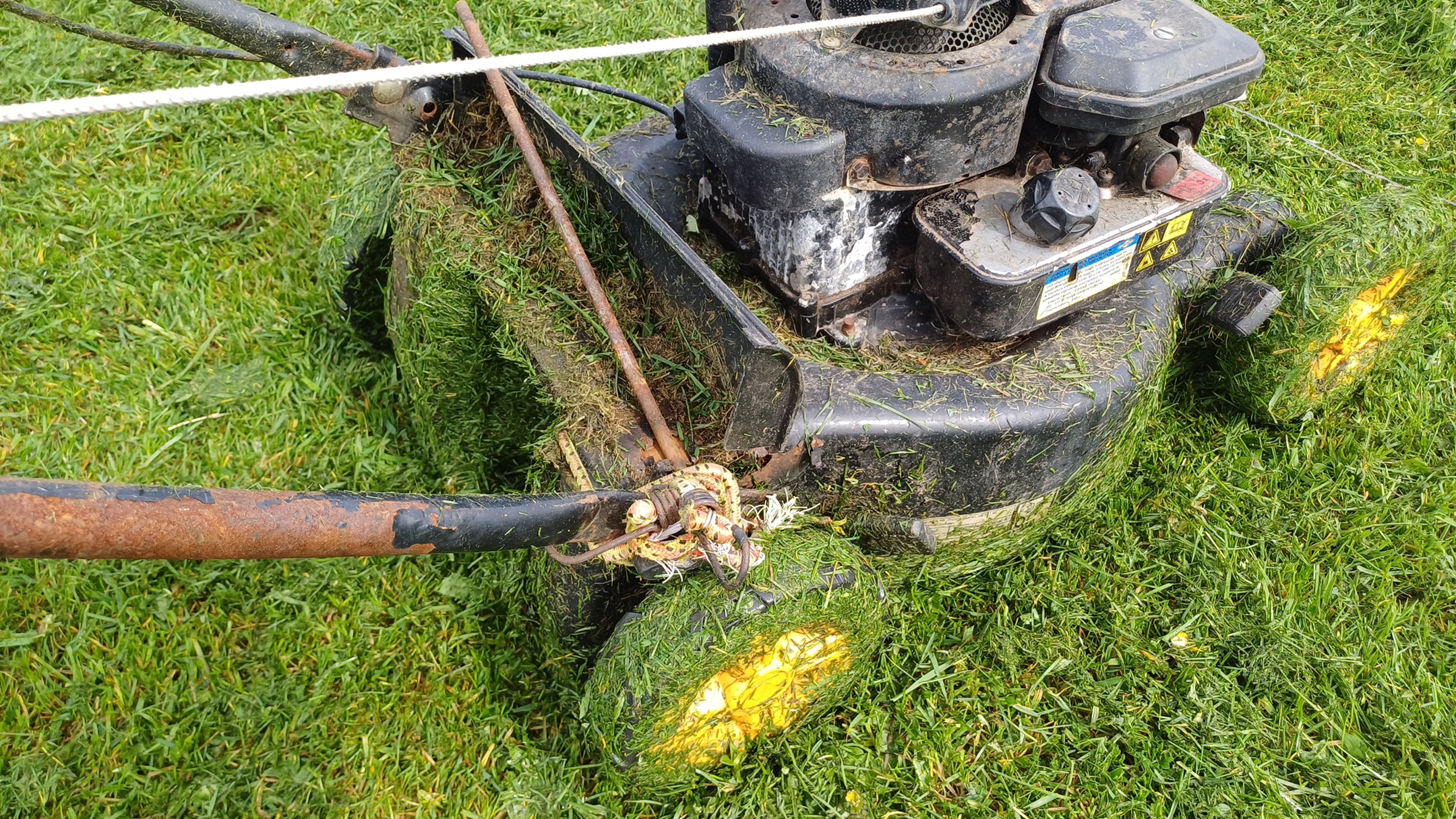
We have had a few problems with it before which we’ve managed to sort out but this time the actual chassis broke. After a quick committee discussion it was decided to purchase a replacement, another of the same type as the newer mower which seems to do a good job. 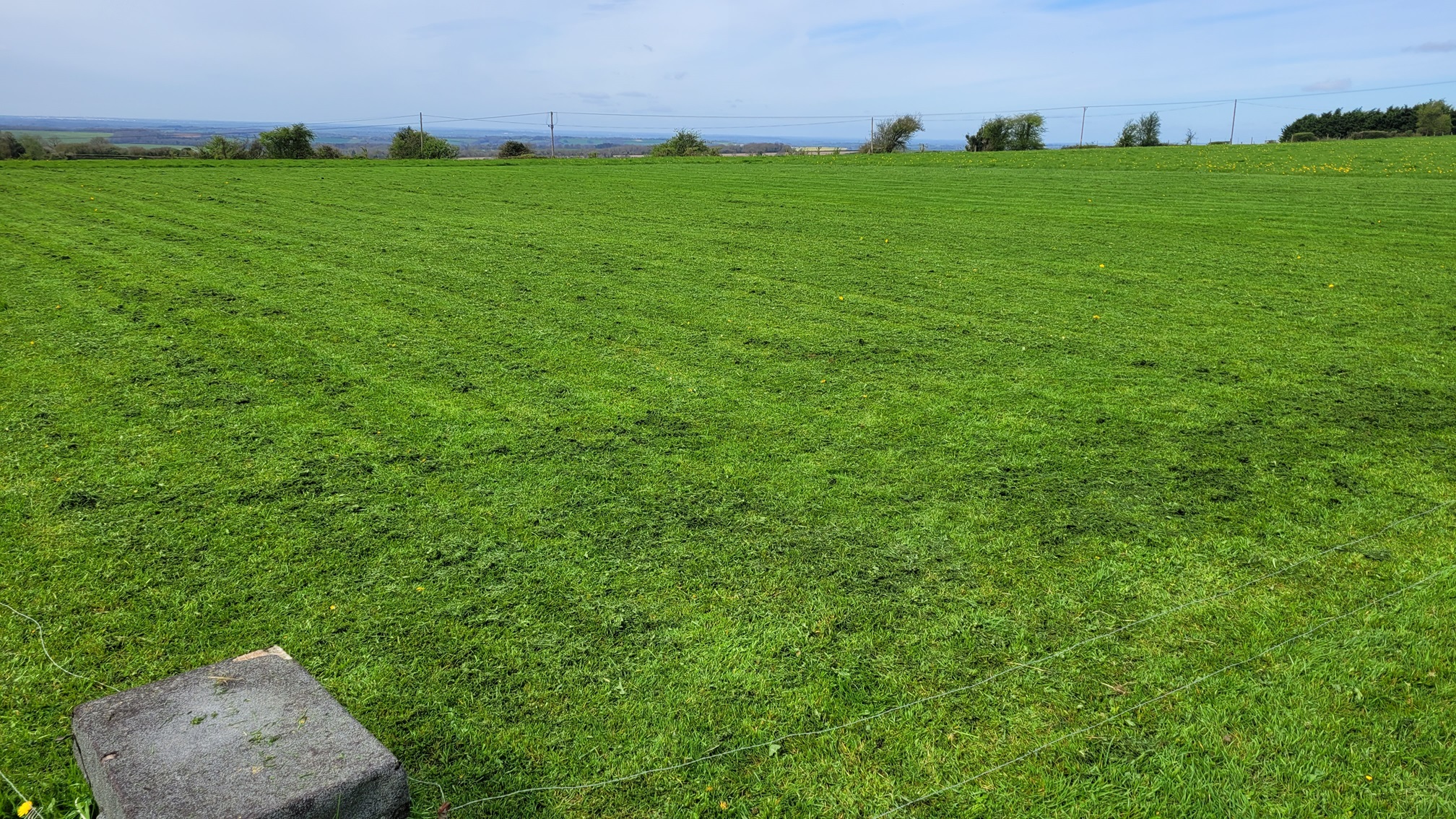 Mowing a field is asking rather a lot of any domestic mower so the old one hasn’t done us too badly. We also decided to buy a second storage box as we don’t want our shiny new mower left out in all weathers. The chosen new box is bright orange so we’ll need to paint it black but by the time you read this both the mower and the storage box should be in use.
Mowing a field is asking rather a lot of any domestic mower so the old one hasn’t done us too badly. We also decided to buy a second storage box as we don’t want our shiny new mower left out in all weathers. The chosen new box is bright orange so we’ll need to paint it black but by the time you read this both the mower and the storage box should be in use.
Now look, I have no way of knowing how many people read Patch News each month and I don’t know how much attention readers pay to what they read. But I do know that not one person has queried my report in the last Patch News which was published on 1st April of a Lancaster circling low over the field. There were several pointers to it being an April Fool, not least of which that WE were amazed to see it. So who else saw it with me? The report went on to say that the sighting was on the FIRST of the month, that the pilot was too ALOOF to respond to our waving, and that I took the photo on the FOURTH pass.
Lastly, in the photo I included it’s easy to see that it has two-bladed propellors. The plane is in fact ex-club member Mick Harper’s electric powered model, taken several years ago.
Several new models arrived at the patch and were successfully flown in April and I’ll begin with Mini-Mike’s Max Thrust Aggressor. Mini-Mike already owns an Extreme Aggressor which is the EDF version using the same fuselage as the glider Aggressor but with a streamlined 1.2m wing and the addition of a pylon mounted ducted fan unit on top.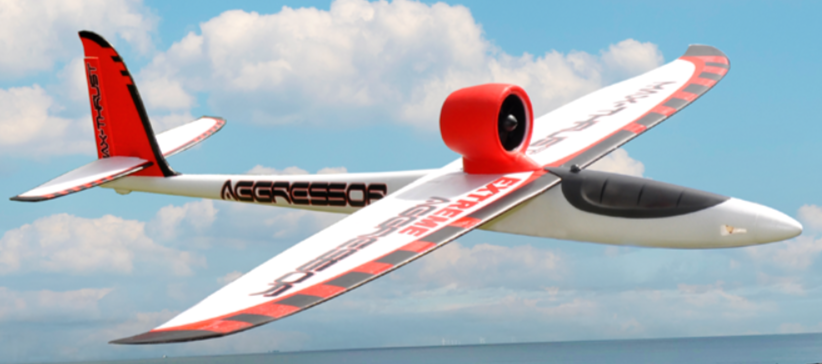
The one he bought this month is not actually a new model, Mini-Mike spotted it for sale on Facebook Marketplace for £90 and snapped it up. I reckon it was real bargain at that price as it looks as good as new to me and apparently the seller said he’d only flown it a couple of times. Another plus is that it’s the Thermic version which is the same as the Sport one but also has a removeable 500mm wing centre section that takes the wingspan up to 2m.
 When Mike flew it he was using it without the extension piece in place so it was 1.5m span.
When Mike flew it he was using it without the extension piece in place so it was 1.5m span. 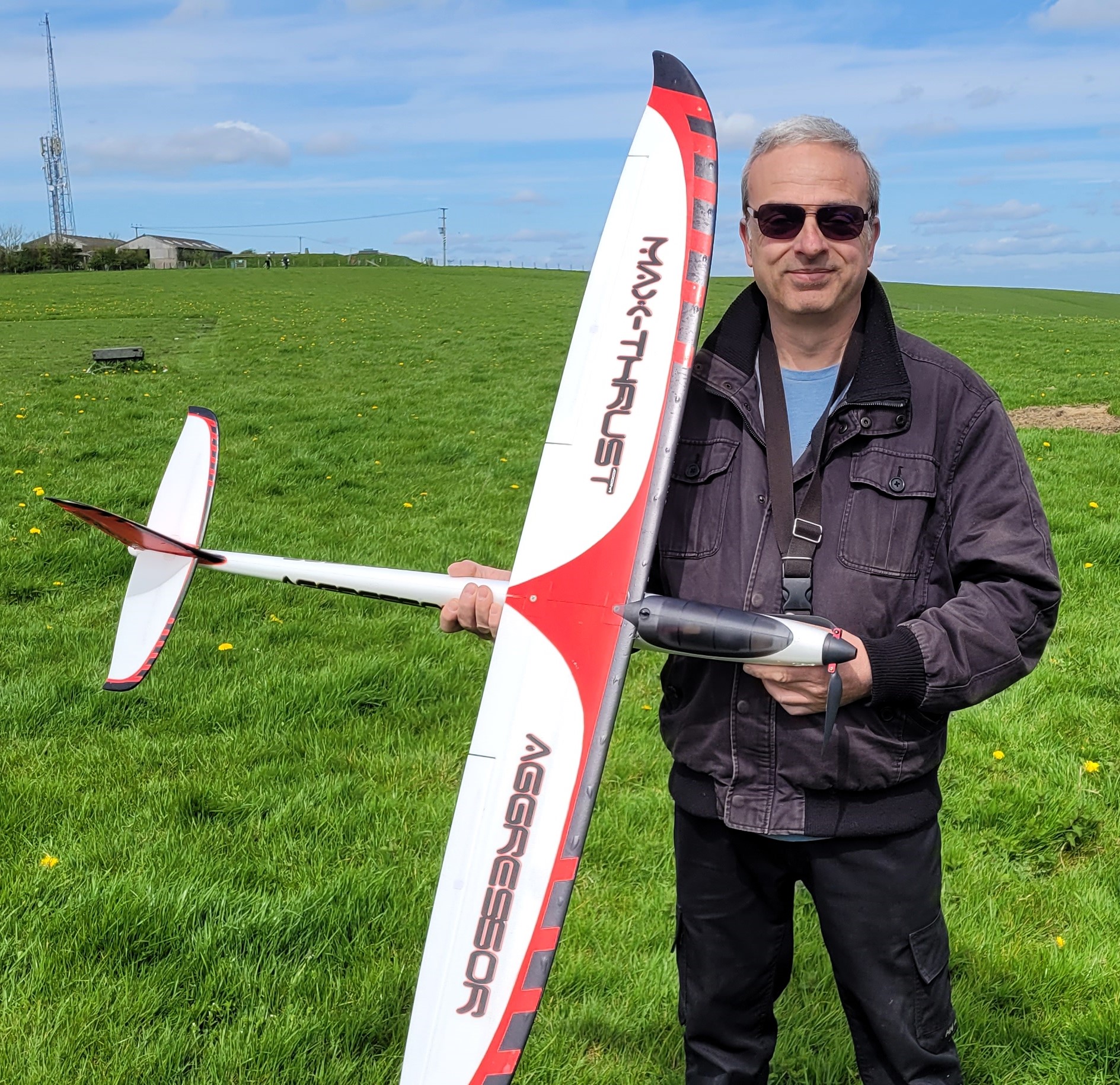 Several PAM members fly Aggressor Sports and they are really good all-rounders, they will fly in pretty much any wind condition and will either float around fairly gently or do all the aerobatics you want in true hotliner fashion. Well more warm liner but good anyway. Chas also has the Thermic version but I can’t remember if he usually flies his with or without the extension in place. Mike’s first flight was uneventful, it flew just like the all the others. I did say to him I thought it looked awful but I’d take it off his hands for £95 but he turned down my generous offer! You can see some of the first flight in this month’s video.
Several PAM members fly Aggressor Sports and they are really good all-rounders, they will fly in pretty much any wind condition and will either float around fairly gently or do all the aerobatics you want in true hotliner fashion. Well more warm liner but good anyway. Chas also has the Thermic version but I can’t remember if he usually flies his with or without the extension in place. Mike’s first flight was uneventful, it flew just like the all the others. I did say to him I thought it looked awful but I’d take it off his hands for £95 but he turned down my generous offer! You can see some of the first flight in this month’s video.
1066 also spent some of his hard earned(?) cash this month and I have to admit that I was slightly bemused when he told me he’d bought a Brio, had he suddenly got into toy trains?
 So I was somewhat relieved to find out later that what he’d actually bought was an ARTF E-flite Brio 10 when he was on a recent excursion to the Modellbau UK shop in Medstead.
So I was somewhat relieved to find out later that what he’d actually bought was an ARTF E-flite Brio 10 when he was on a recent excursion to the Modellbau UK shop in Medstead.
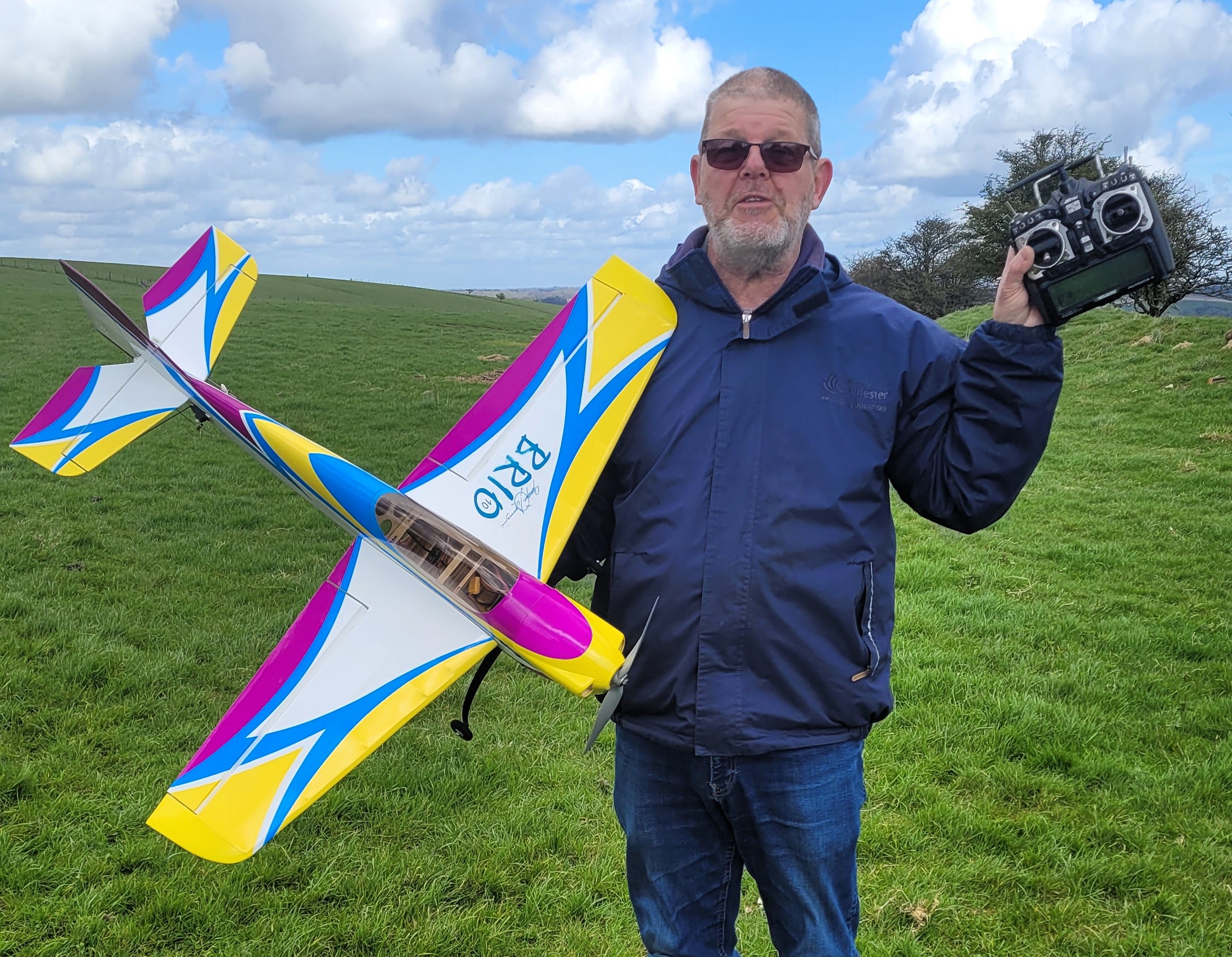 It’s 1040mm (40.9”) wingspan, 1015mm (40.0”) long and weighs around 965g with a 3 cell 2200mAh lipo battery. The Brio was discontinued by E-flite many years ago so the one at Modellbau was obviously old stock but, as a sweetener, they included a 1000kv motor and a 40A speed controller in the deal. They didn’t include any servos so 1066 had to supply his own. The heat-shrink film was a bit wrinkled on one wingtip but otherwise it was fine.
It’s 1040mm (40.9”) wingspan, 1015mm (40.0”) long and weighs around 965g with a 3 cell 2200mAh lipo battery. The Brio was discontinued by E-flite many years ago so the one at Modellbau was obviously old stock but, as a sweetener, they included a 1000kv motor and a 40A speed controller in the deal. They didn’t include any servos so 1066 had to supply his own. The heat-shrink film was a bit wrinkled on one wingtip but otherwise it was fine.
When he tried to reshrink the film 1066 found that he’d made it worse rather than better so is unsure what the film is but it looks fine to me anyway. For the first flight 1066 fitted a 10×5 prop but the Brio was underpowered so he switched to an 11×8 and that is perfect.
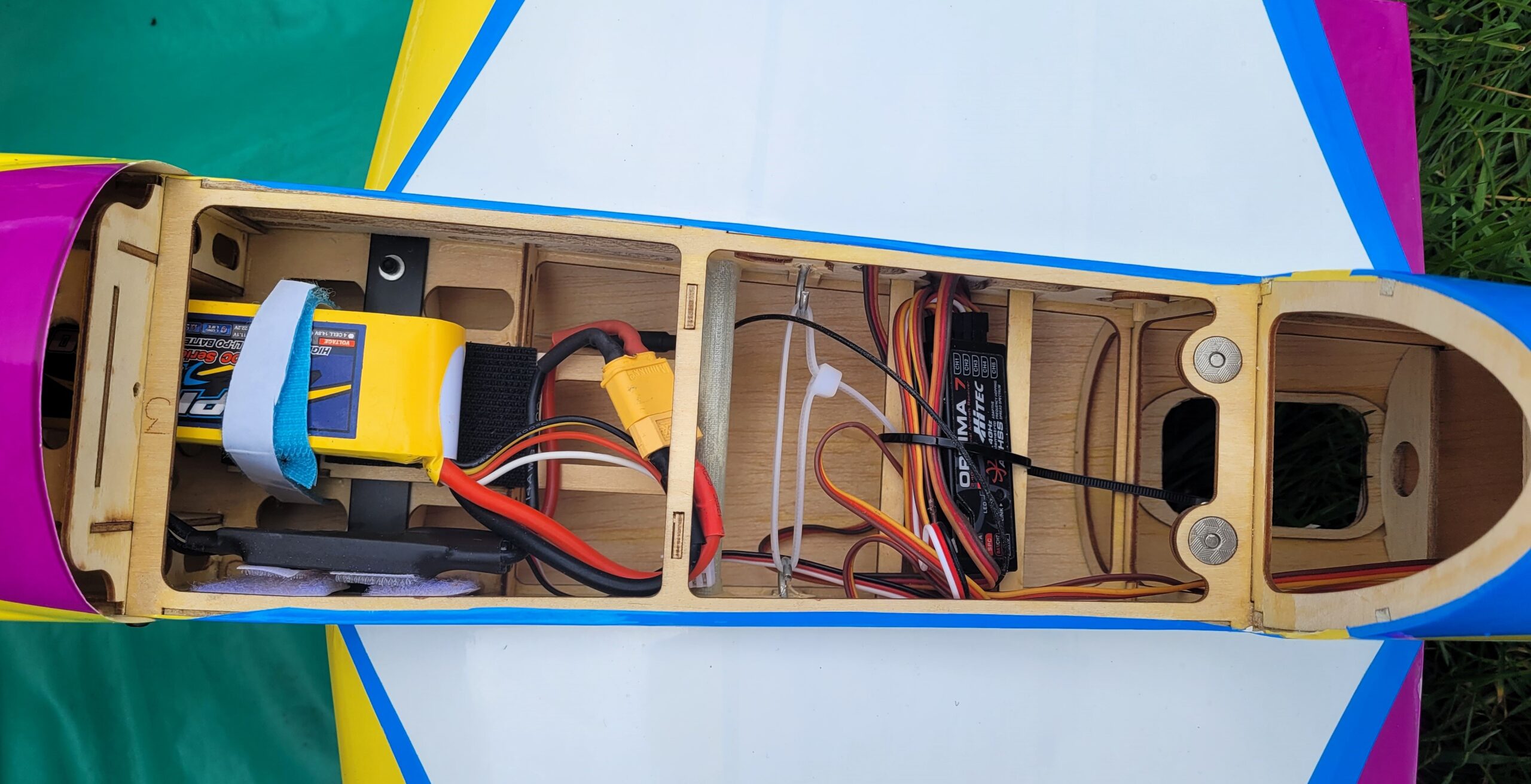 I haven’t been able to dig out much information online about the Brio 10 but did find this: If anybody knows what precision feels like, 3-time World Champion and 2-time US Champion Quique Somenzini certainly does. And he has poured all this experience into the design of the Brio 10, a 10-size replica that even flies the same as the F3A plane he used to win the 2005 US Nats. At the heart of its performance is a low aspect ratio wing that moves the center of lift closer to the fuselage. The result is an electric pattern plane with outstanding roll rates and a locked-in feel that will give you the confidence to fly artistic aerobatics with absolute precision. So the design has a good pedigree and 1066 reckons it’s really nice to fly, the knife-edge performance being especially good as there’s no coupling between the rudder and other surfaces so there’s no need to correct with ailerons or elevator. Judge for yourself, one of the April flights in is in this month’s video.
I haven’t been able to dig out much information online about the Brio 10 but did find this: If anybody knows what precision feels like, 3-time World Champion and 2-time US Champion Quique Somenzini certainly does. And he has poured all this experience into the design of the Brio 10, a 10-size replica that even flies the same as the F3A plane he used to win the 2005 US Nats. At the heart of its performance is a low aspect ratio wing that moves the center of lift closer to the fuselage. The result is an electric pattern plane with outstanding roll rates and a locked-in feel that will give you the confidence to fly artistic aerobatics with absolute precision. So the design has a good pedigree and 1066 reckons it’s really nice to fly, the knife-edge performance being especially good as there’s no coupling between the rudder and other surfaces so there’s no need to correct with ailerons or elevator. Judge for yourself, one of the April flights in is in this month’s video.
We hadn’t seen much of young Charlie for a few months but he did make it to the patch in April when he flew both his Durafly Excalibur and his tiny Volantex Spitfire. Despite not having flown for a while Charlie had no problems, he didn’t seem at all rusty…kids eh, pah! 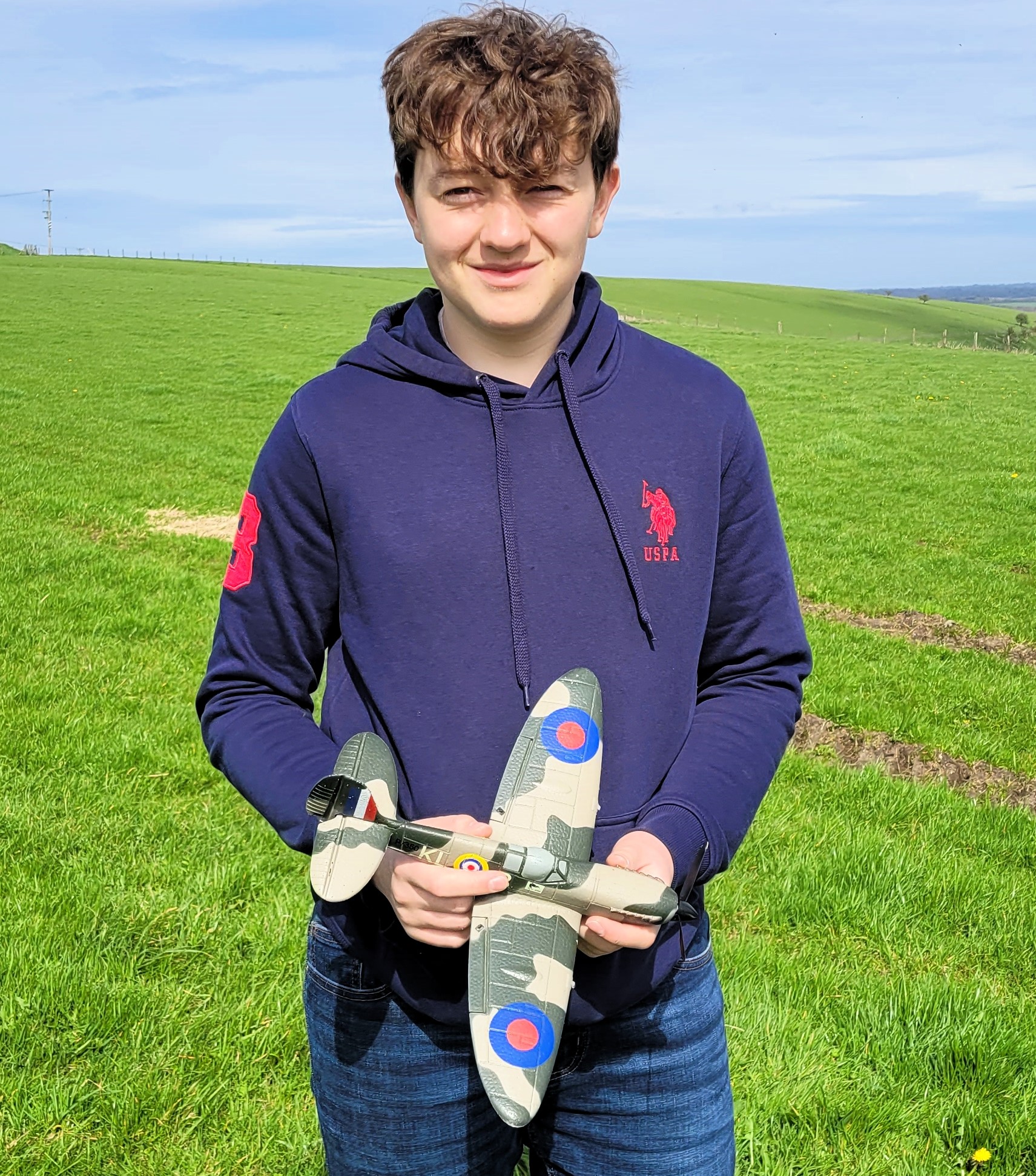 Part of the reason for his absence is that he’s been spending some of his time getting into full-size gliding at Lasham. His mum Nadine sent me some excellent photos and wrote about his experiences for us: Charlie was lucky enough to get a Trial Flight at Lasham Gliding as a Birthday present last year and he had his first flight in a glider in October.
Part of the reason for his absence is that he’s been spending some of his time getting into full-size gliding at Lasham. His mum Nadine sent me some excellent photos and wrote about his experiences for us: Charlie was lucky enough to get a Trial Flight at Lasham Gliding as a Birthday present last year and he had his first flight in a glider in October.
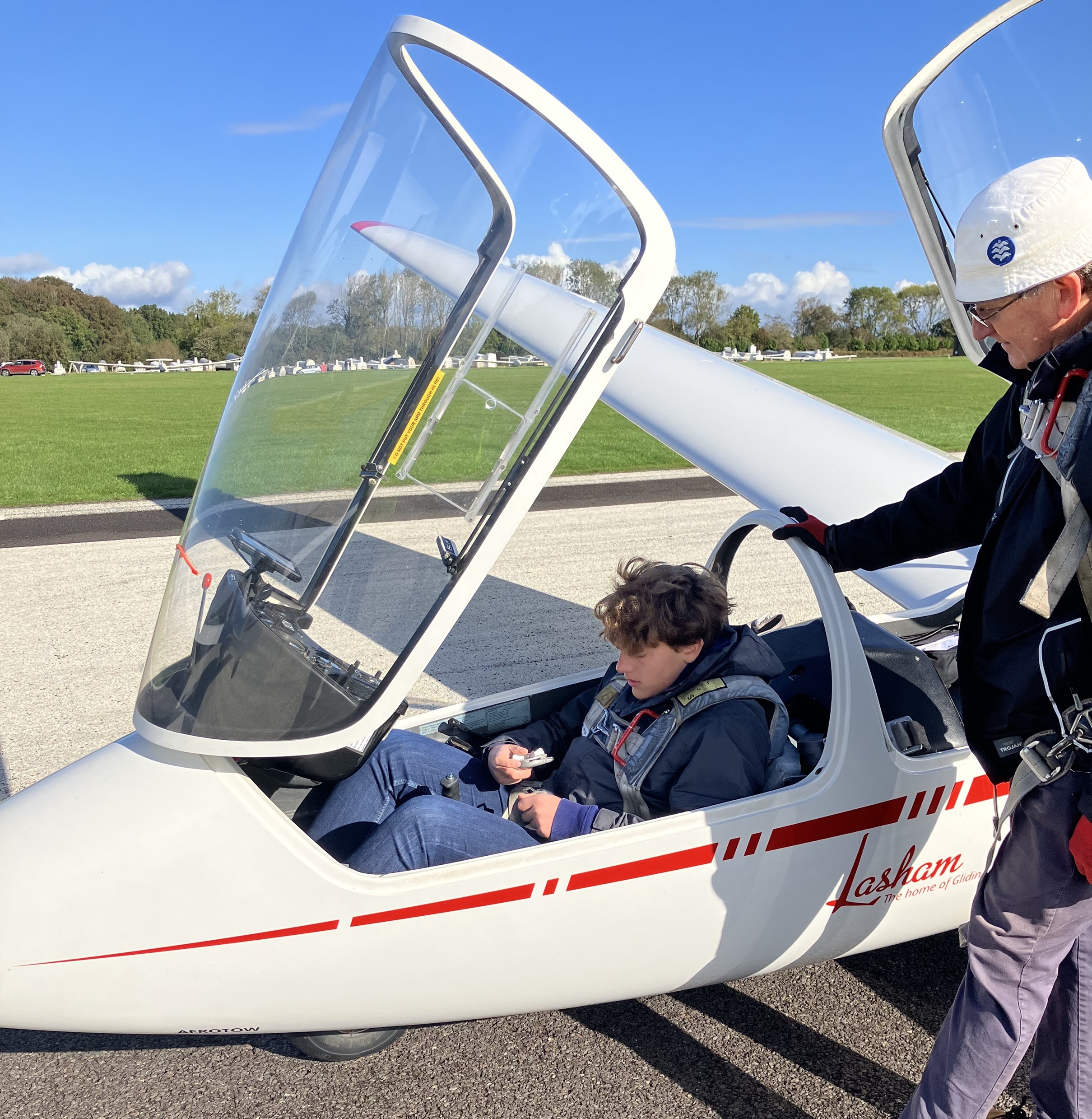
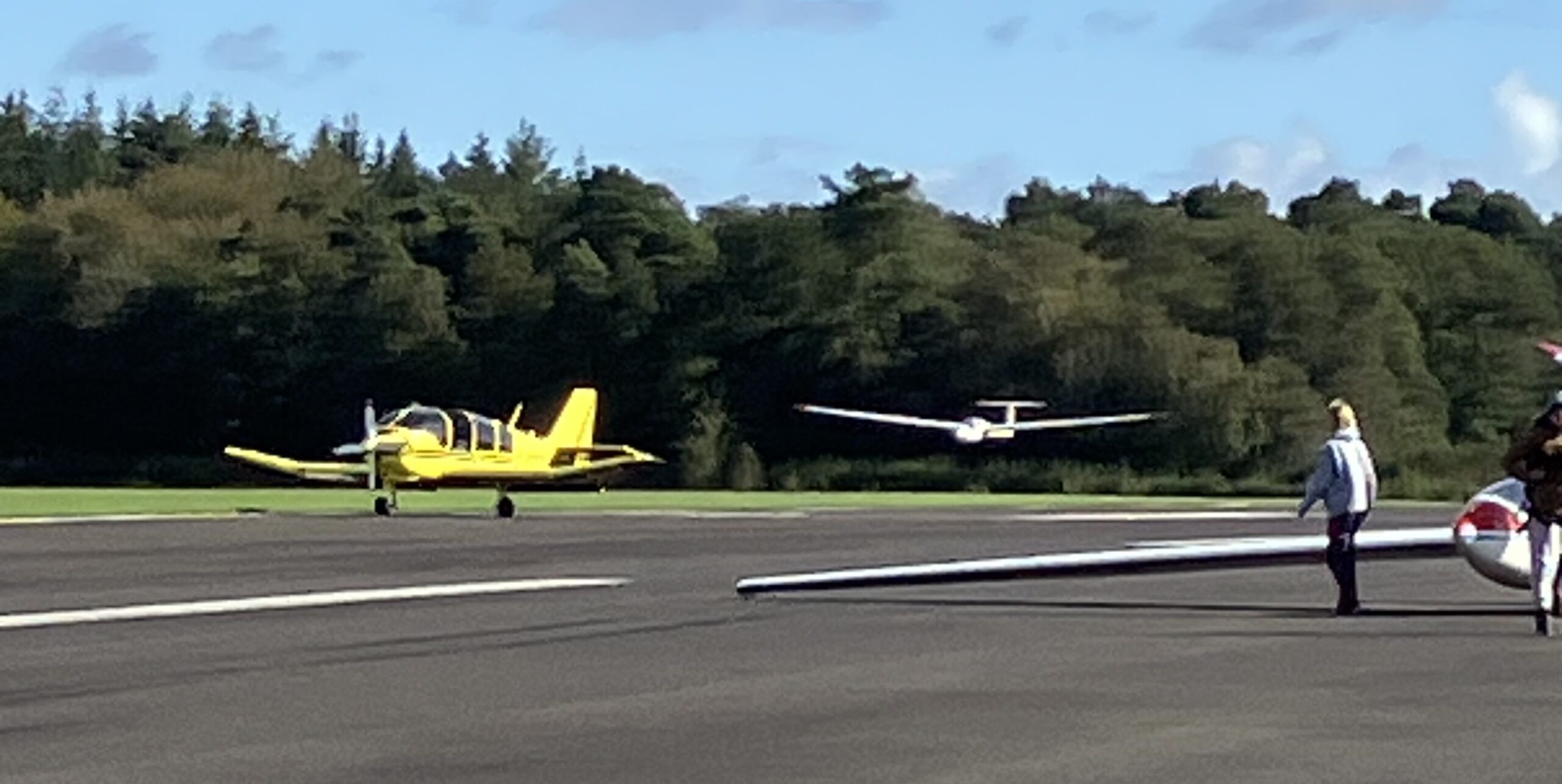
 Then he had a month’s free membership, but due to the weather at the end of the year they were kind enough to extend it, allowing him four sessions until the end of the year.
Then he had a month’s free membership, but due to the weather at the end of the year they were kind enough to extend it, allowing him four sessions until the end of the year.

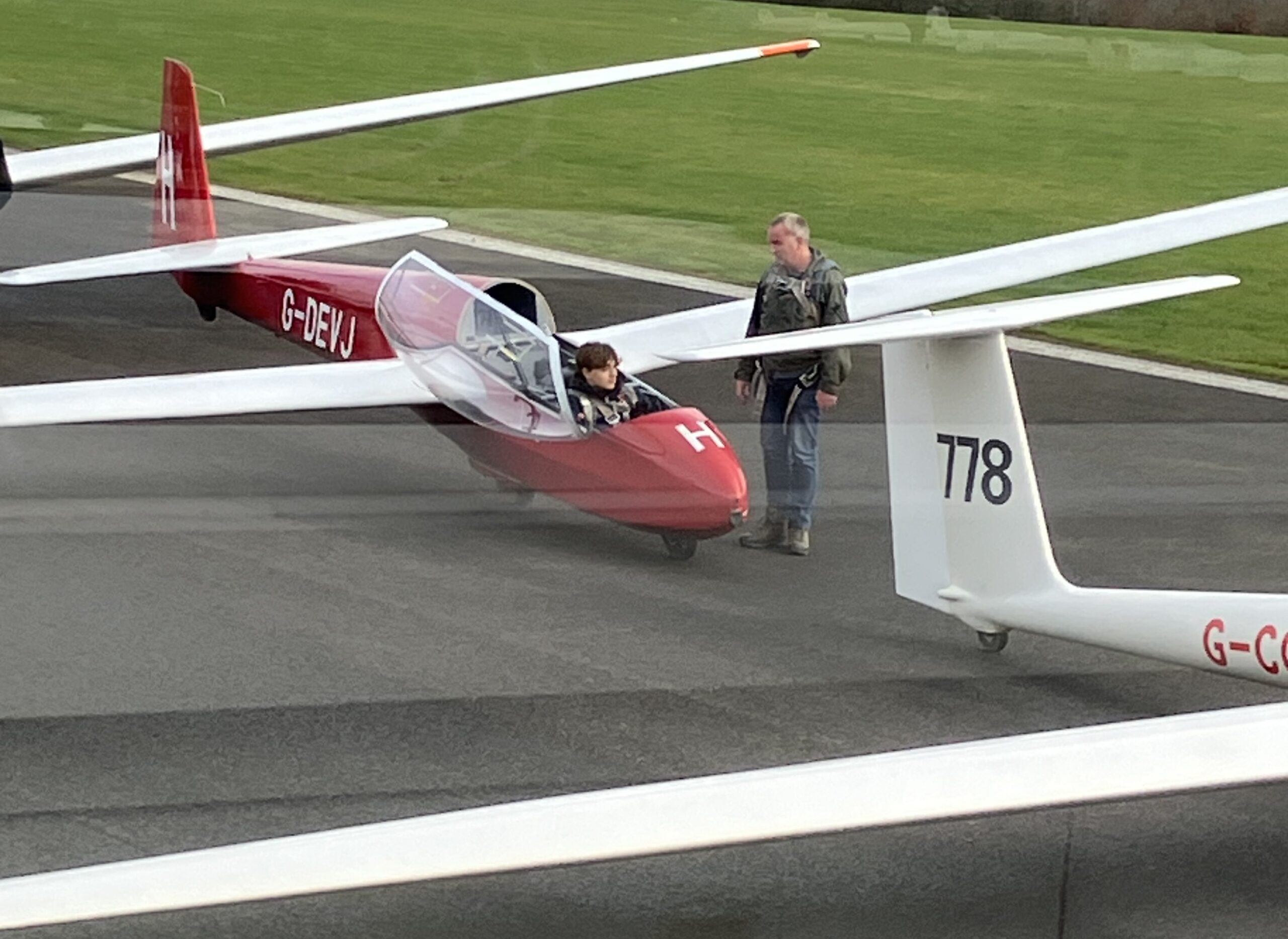 During these flights, Charlie was able to take the controls for the take-off which is done with a winch launch and do most of the gliding on his own with the instructor taking back the controls for the landings. Above: That’s a Schleicher ASK13 for initial training.
During these flights, Charlie was able to take the controls for the take-off which is done with a winch launch and do most of the gliding on his own with the instructor taking back the controls for the landings. Above: That’s a Schleicher ASK13 for initial training.
Below: For Charlie’s more advanced training he’s now progressed to an ASK21B.
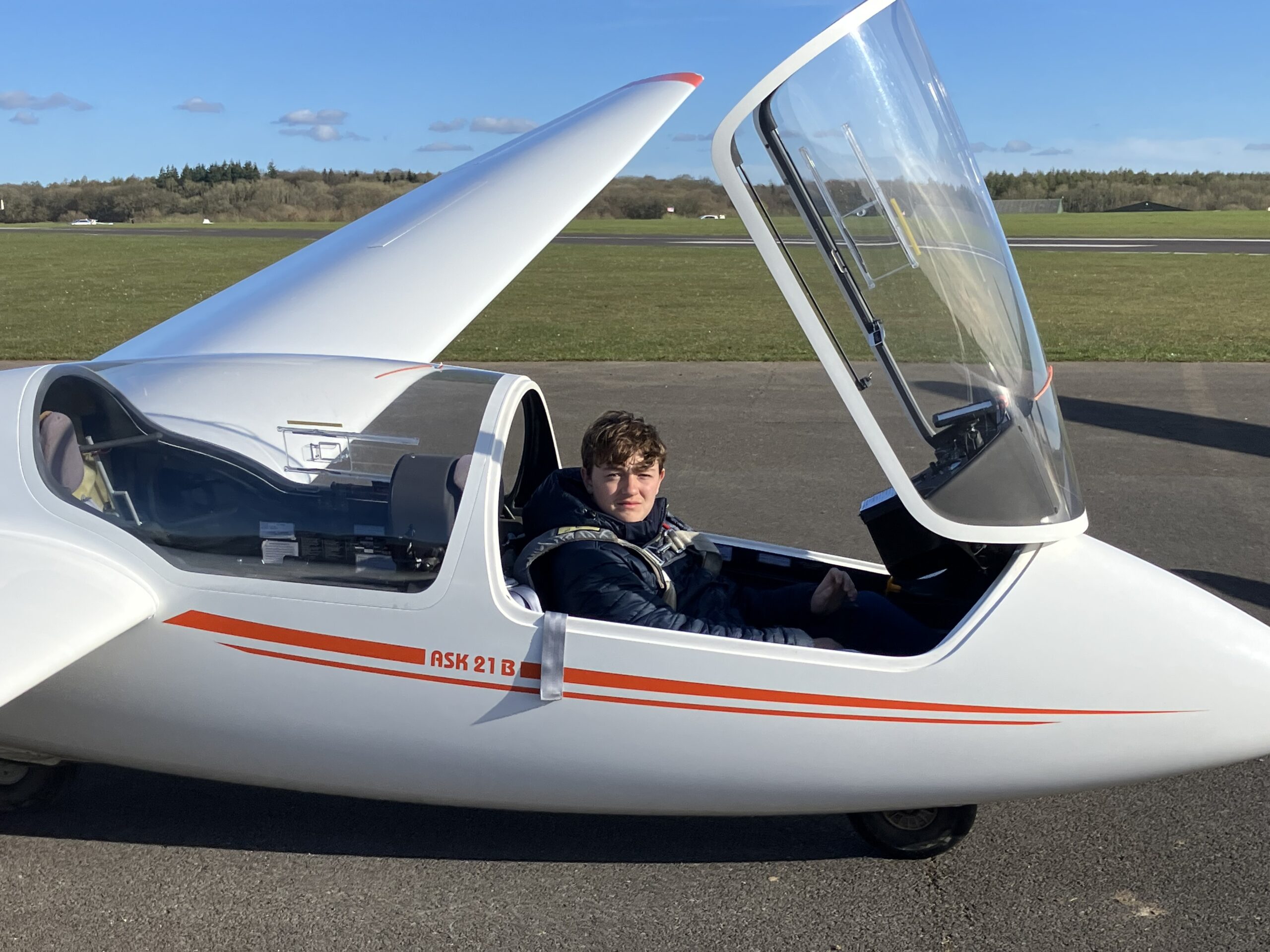
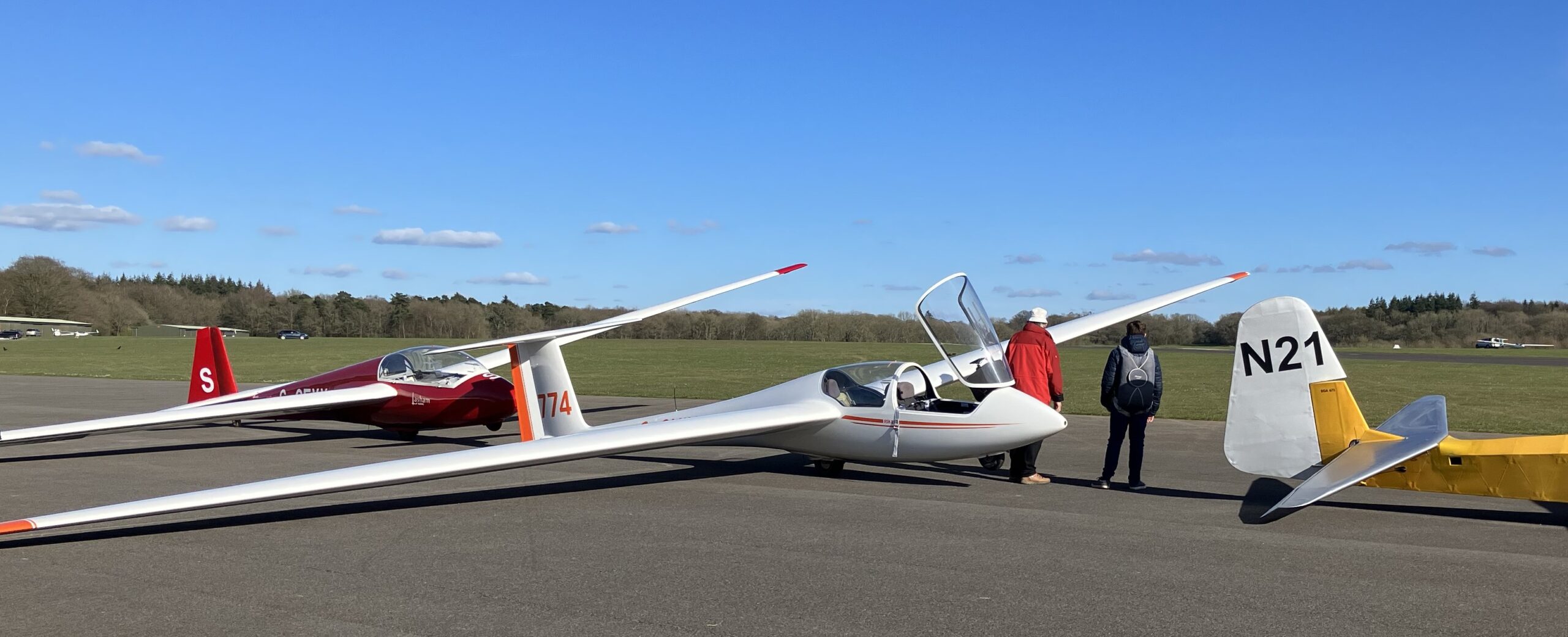 At the beginning of the year Charlie joined Lasham Gliding as a Youth member and has now had over 20 flights and on the last visit was trusted to land the glider himself.
At the beginning of the year Charlie joined Lasham Gliding as a Youth member and has now had over 20 flights and on the last visit was trusted to land the glider himself. 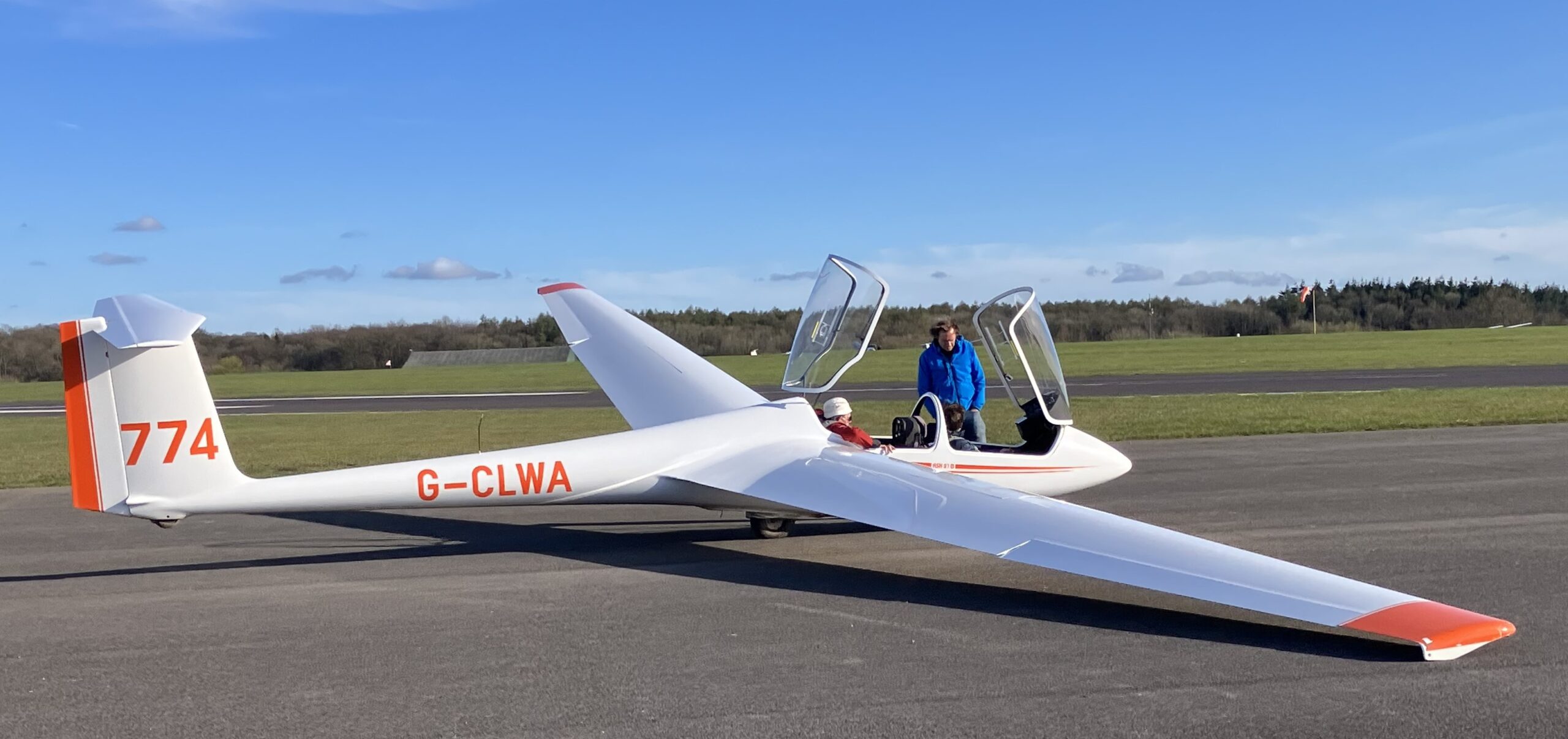 Thanks for that Nadine, it’s good to hear about Charlie’s exploits away from the patch.
Thanks for that Nadine, it’s good to hear about Charlie’s exploits away from the patch.
Well done Charlie, most full-size pilots say it’s easier than flying models so you’ll do well!
Bob the Builder bought himself a new model in April, an XFly Tasman that he got from the Kings Lynn Model Shop. The Tasman is an all-foam model that comes complete, ready fitted with a 3536 900kv motor, 40A speed controller, and six 9g digital servos.
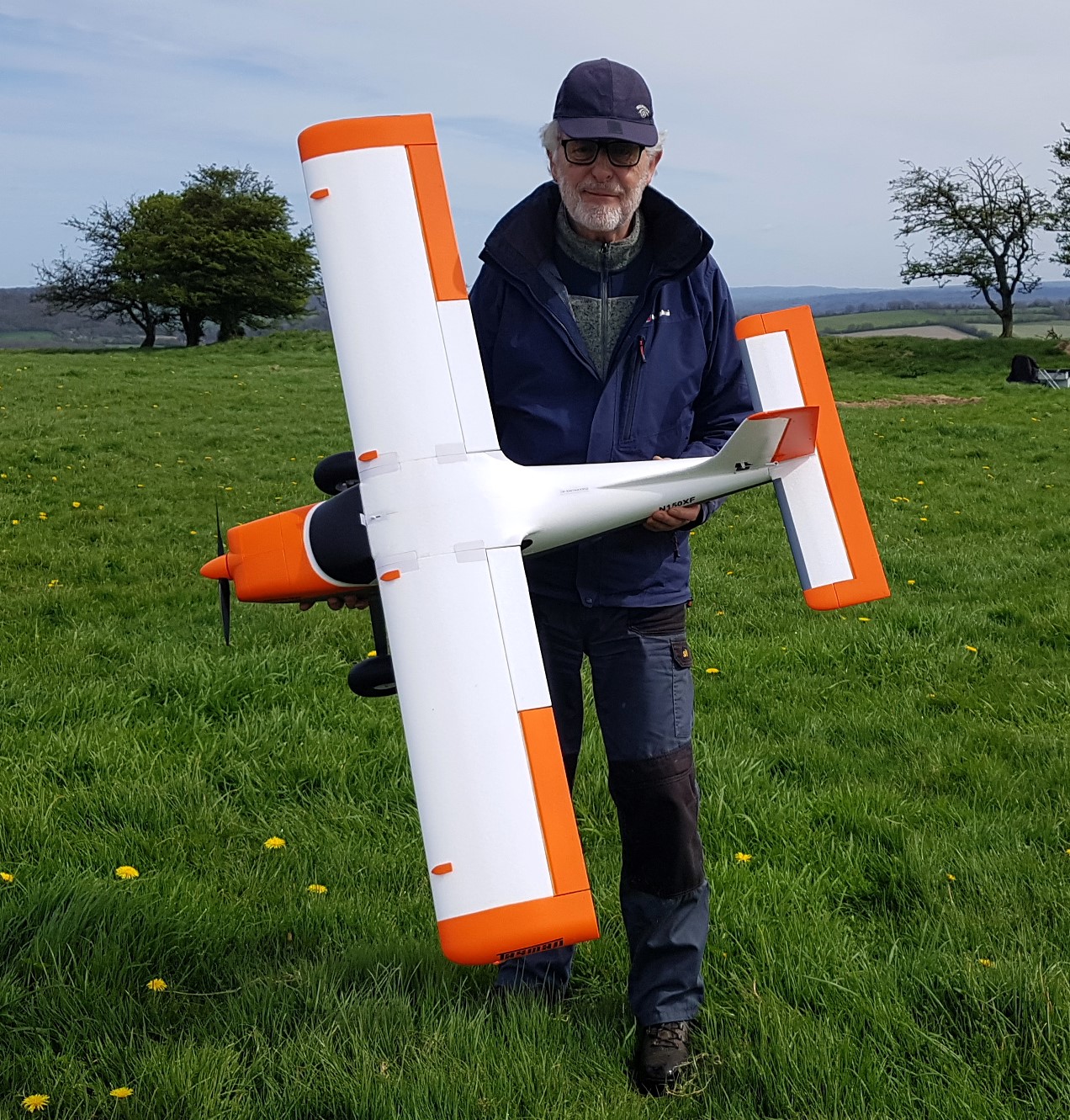
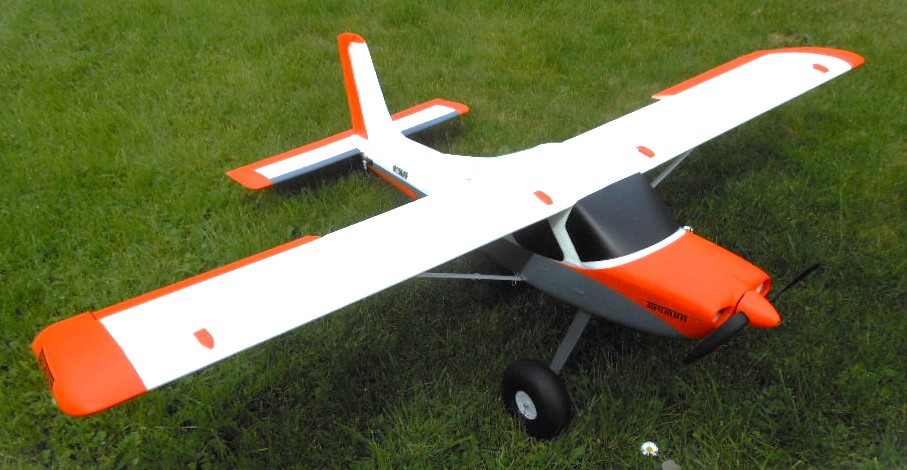 This is what the website says this about it: The XFly 1500mm (59.1”) Tasman is a STOL-capable, high-wing airplane featuring sporty flight and aerobatic 3D performance. The Tasman’s impressive flight characteristics and large air-filled shock-absorbing tires make short take-offs and aggressive landings on any type of surface easy. The 4S-compatible brushless motor, 40A ESC, 2-blade propeller and a 4S Lipo battery proved to be the optimum setup for power and duration, allowing the plane to hover, roll, loop and fly inverted easily, which makes it highly recommended as an advanced trainer.
This is what the website says this about it: The XFly 1500mm (59.1”) Tasman is a STOL-capable, high-wing airplane featuring sporty flight and aerobatic 3D performance. The Tasman’s impressive flight characteristics and large air-filled shock-absorbing tires make short take-offs and aggressive landings on any type of surface easy. The 4S-compatible brushless motor, 40A ESC, 2-blade propeller and a 4S Lipo battery proved to be the optimum setup for power and duration, allowing the plane to hover, roll, loop and fly inverted easily, which makes it highly recommended as an advanced trainer.  Factory-installed LED navigation lights, plus operational flaps, are functional scale features that take your experience to another level. The Tasman comes equipped with a latch-type top hatch to fit 4S 2200-3300mah batteries for a wide range in performance and flight times. Personally I think it’s a very attractive model which should be ideal for flying off our sometimes less than perfect grass patch. The fuselage is massive so there’s absolutely loads of space for large batteries and with big wheels it’s not going to struggle getting off the grass. Sadly the first flight didn’t go to plan and repairs are now underway.
Factory-installed LED navigation lights, plus operational flaps, are functional scale features that take your experience to another level. The Tasman comes equipped with a latch-type top hatch to fit 4S 2200-3300mah batteries for a wide range in performance and flight times. Personally I think it’s a very attractive model which should be ideal for flying off our sometimes less than perfect grass patch. The fuselage is massive so there’s absolutely loads of space for large batteries and with big wheels it’s not going to struggle getting off the grass. Sadly the first flight didn’t go to plan and repairs are now underway.
I happened to be filming at the time so I captured the crash and Bob has said he’s happy for me to include it in this month’s video. Bob explains what he thinks went wrong here: Having lost my trusty WOT4 I needed a new easy to fly go-to model for all conditions. The Xfly Tasman seemed to fit the bill. Good in all wind and terrain conditions. Also very trainer like, i.e. easy to fly, especially with a good working gyro. I need all the help I can get at my age. Well that was the plan anyway. All pre-flight checks seemed to be OK. First flight easy take off then suddenly full left aileron followed by the inevitable crash! 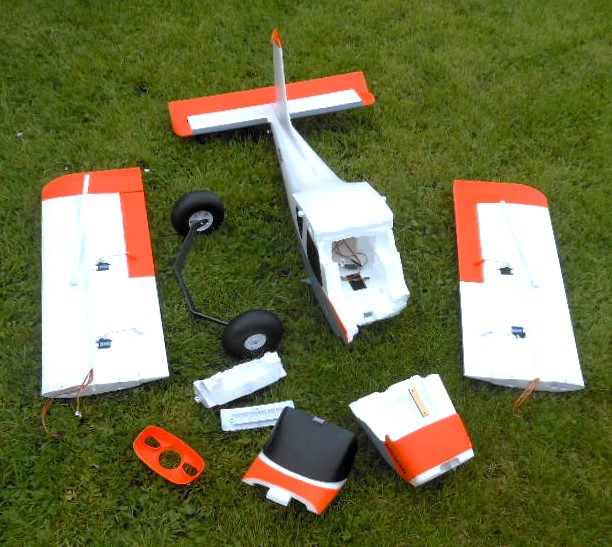 What the hell happened? Here is a lesson for anybody planning to use gyros. I think the only way it would have banged full left ailerons on would be if it thought it was inverted and tried to correct itself. Setting up these gyros is quite complicated and as careful as I was I still made the mistake of not doing a re-calibration when installed in a new model. The receiver was installed the other way up in the previous model but I had changed the orientation on the transmitter for the Tasman and it was showing as the correct way up and everything appeared to be testing OK. Although the crash damage was quite extensive it is fairly clean breaks so it should be back in the air soon complete with a simple non gyro receiver. It was a great shame to see the Tasman crash, especially on the first flight, but I look forward to the next flight when I’m sure it will perform well.
What the hell happened? Here is a lesson for anybody planning to use gyros. I think the only way it would have banged full left ailerons on would be if it thought it was inverted and tried to correct itself. Setting up these gyros is quite complicated and as careful as I was I still made the mistake of not doing a re-calibration when installed in a new model. The receiver was installed the other way up in the previous model but I had changed the orientation on the transmitter for the Tasman and it was showing as the correct way up and everything appeared to be testing OK. Although the crash damage was quite extensive it is fairly clean breaks so it should be back in the air soon complete with a simple non gyro receiver. It was a great shame to see the Tasman crash, especially on the first flight, but I look forward to the next flight when I’m sure it will perform well.
On the subject of repairs, young Leo broke the ABS moulded fuselage of his Volantex Phoenix electric glider recently. Leo had asked Dougal Entendre to take the Phoenix up and trim it for him but when Dougal gave Leo the transmitter back Leo was looking at MacFly’s Phoenix which was in the air at the same time and the inevitable happened.
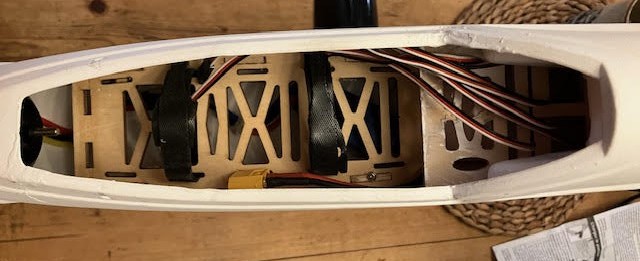
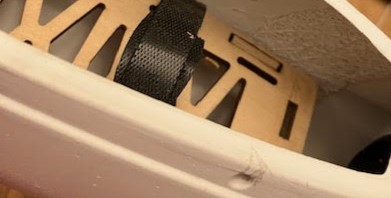 This is what Leo said: You can’t get a new fuzz without buying the whole plane again so I decided to fix mine. It took me about 2 weeks of on-off work to custom make new battery mounting racks and to fix the cracks with epoxy and fibreglass. The hardest part was doing the wing bit on the fuzz because there was a big crack along it and there was less then 2 inch’s of finger space to use. But I’m happy with the result and it flies well.
This is what Leo said: You can’t get a new fuzz without buying the whole plane again so I decided to fix mine. It took me about 2 weeks of on-off work to custom make new battery mounting racks and to fix the cracks with epoxy and fibreglass. The hardest part was doing the wing bit on the fuzz because there was a big crack along it and there was less then 2 inch’s of finger space to use. But I’m happy with the result and it flies well.
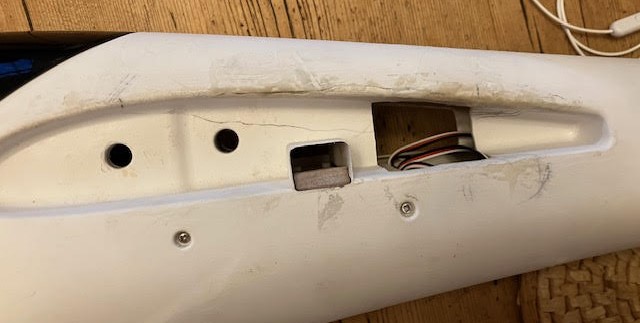
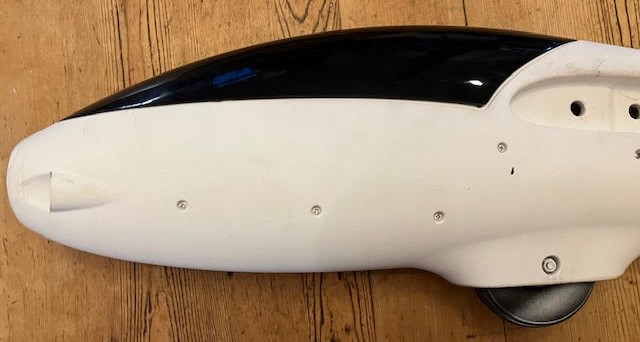
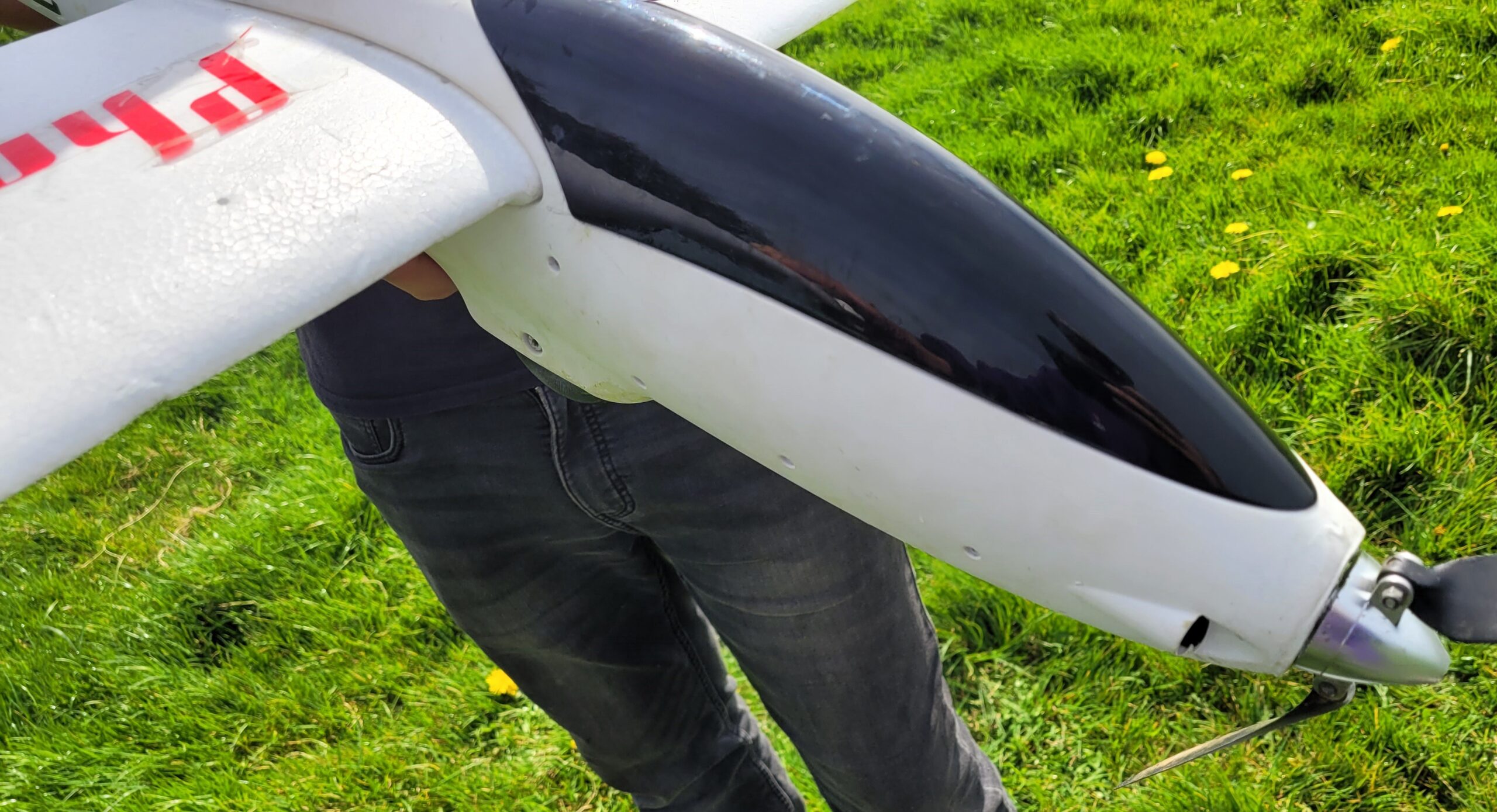 Well done Leo, you’ve made a good job of it. ABS isn’t the easiest to repair but the Phoenix is now pretty much as good as new and, as you’ll see in the video, it’s back flying again.
Well done Leo, you’ve made a good job of it. ABS isn’t the easiest to repair but the Phoenix is now pretty much as good as new and, as you’ll see in the video, it’s back flying again.
Here are a few more of Kryten’s excellent action shots that he took for us last month: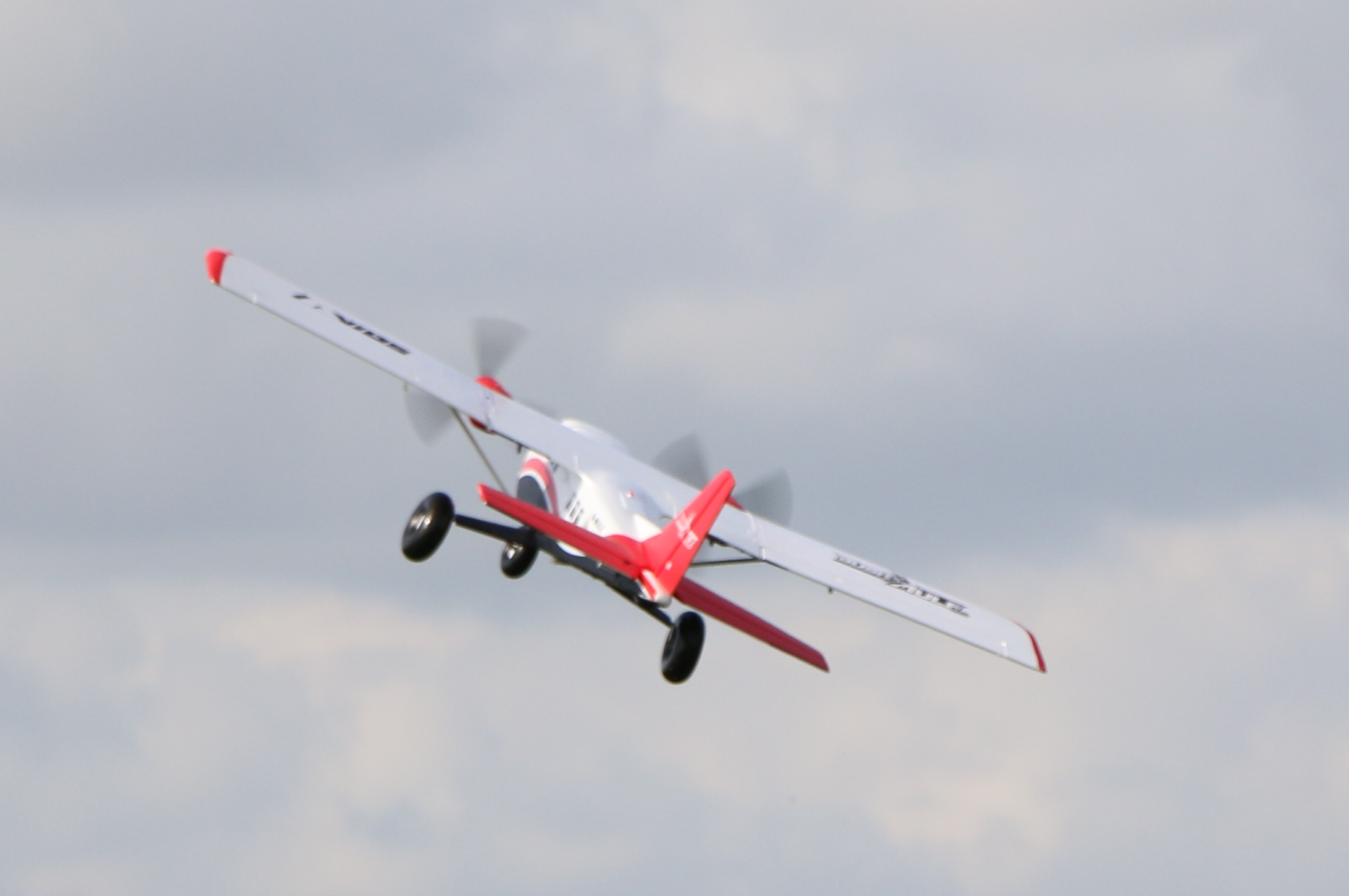
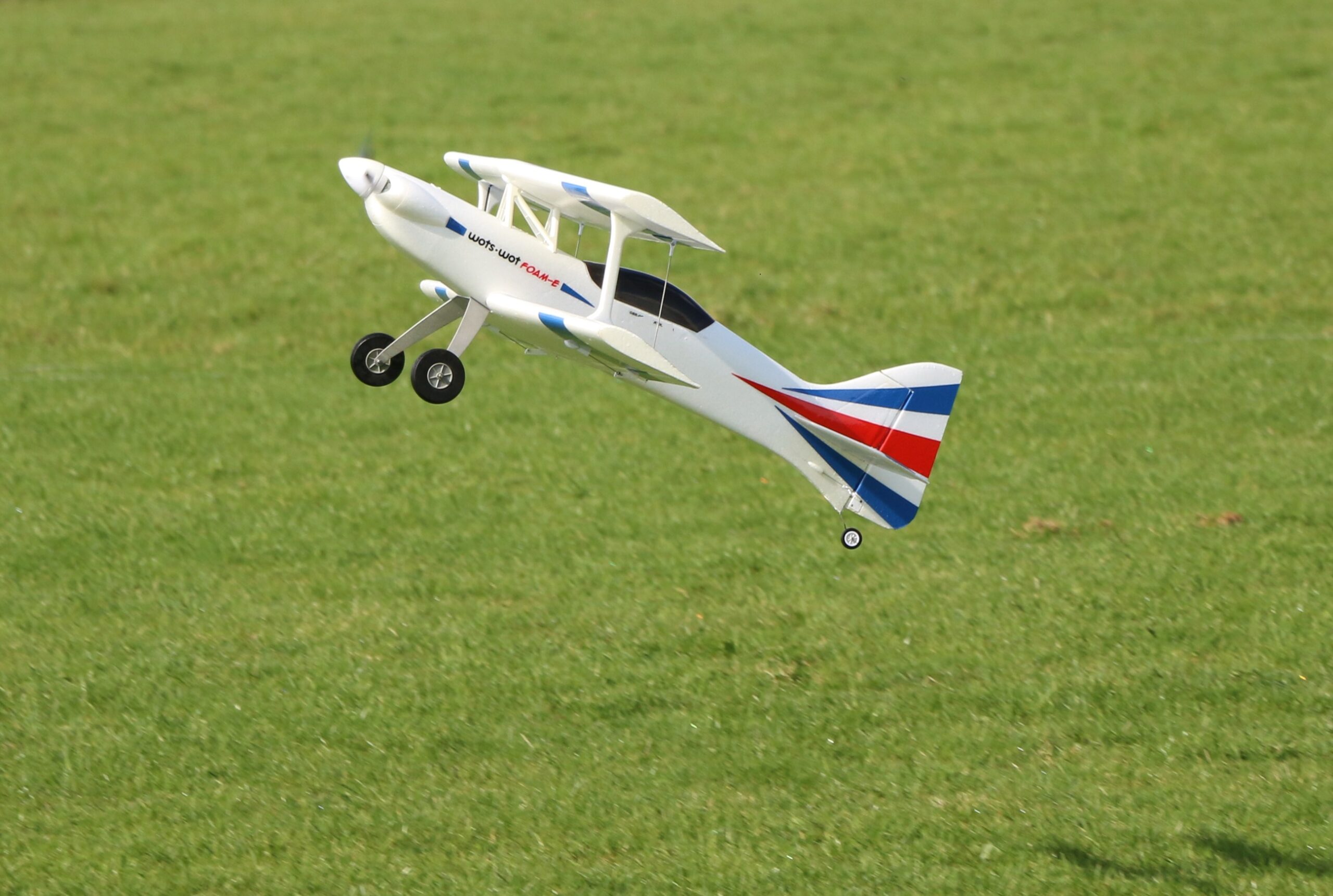
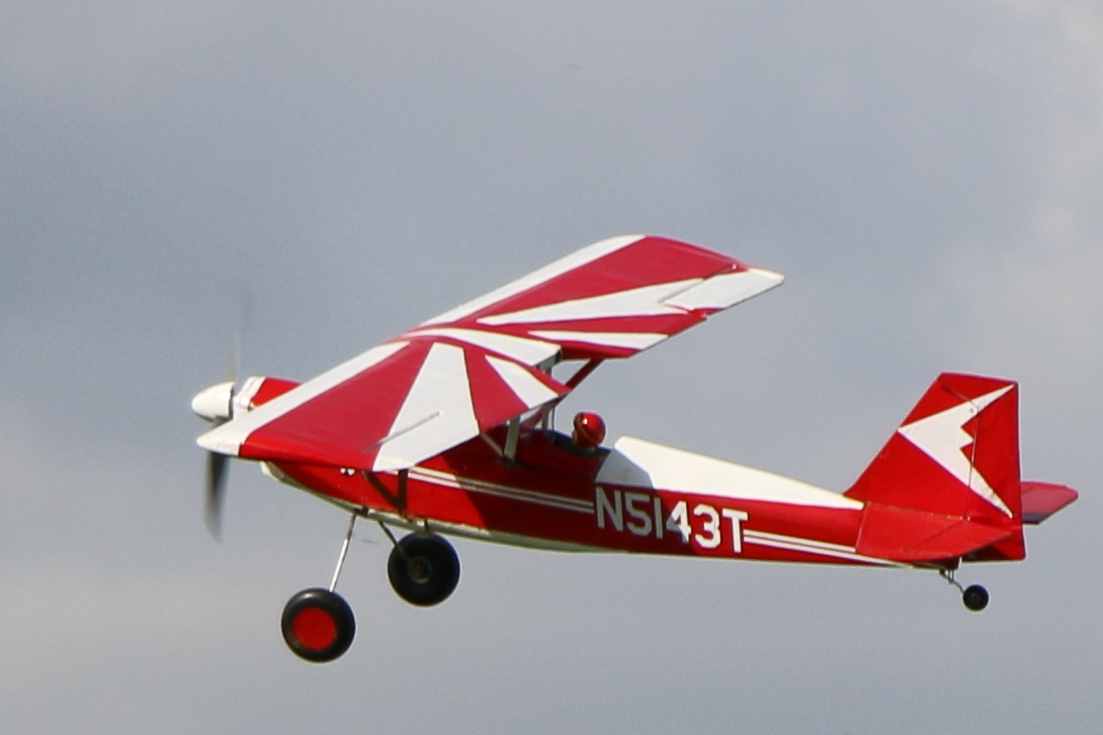
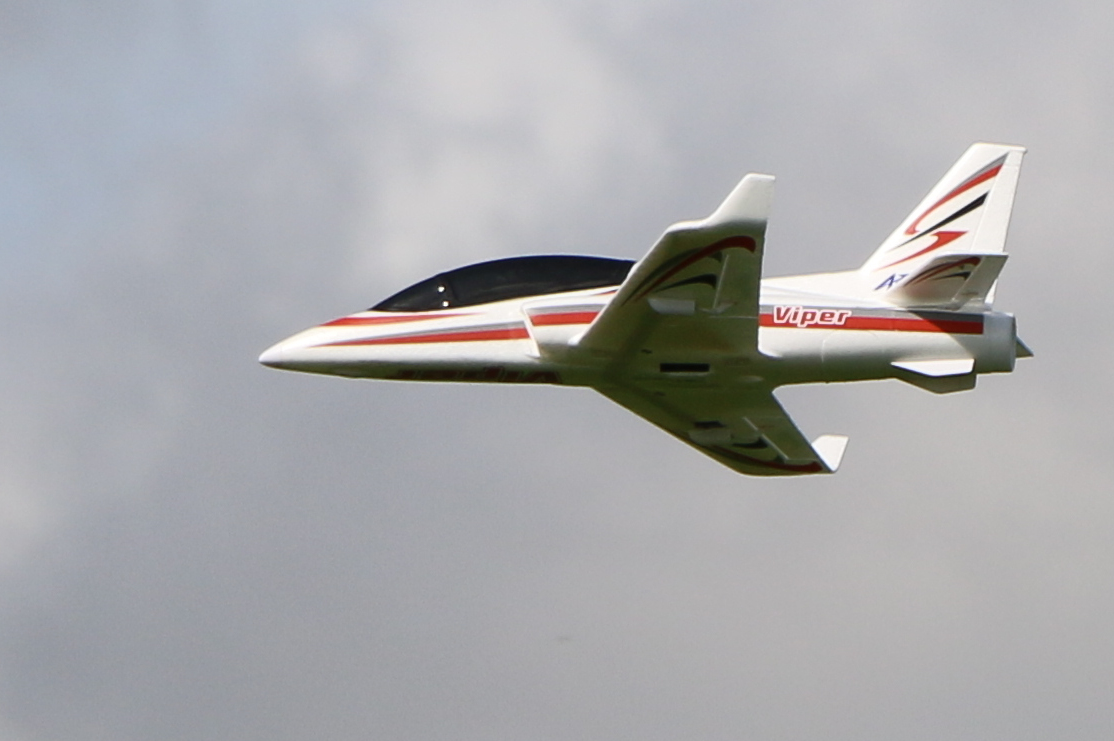
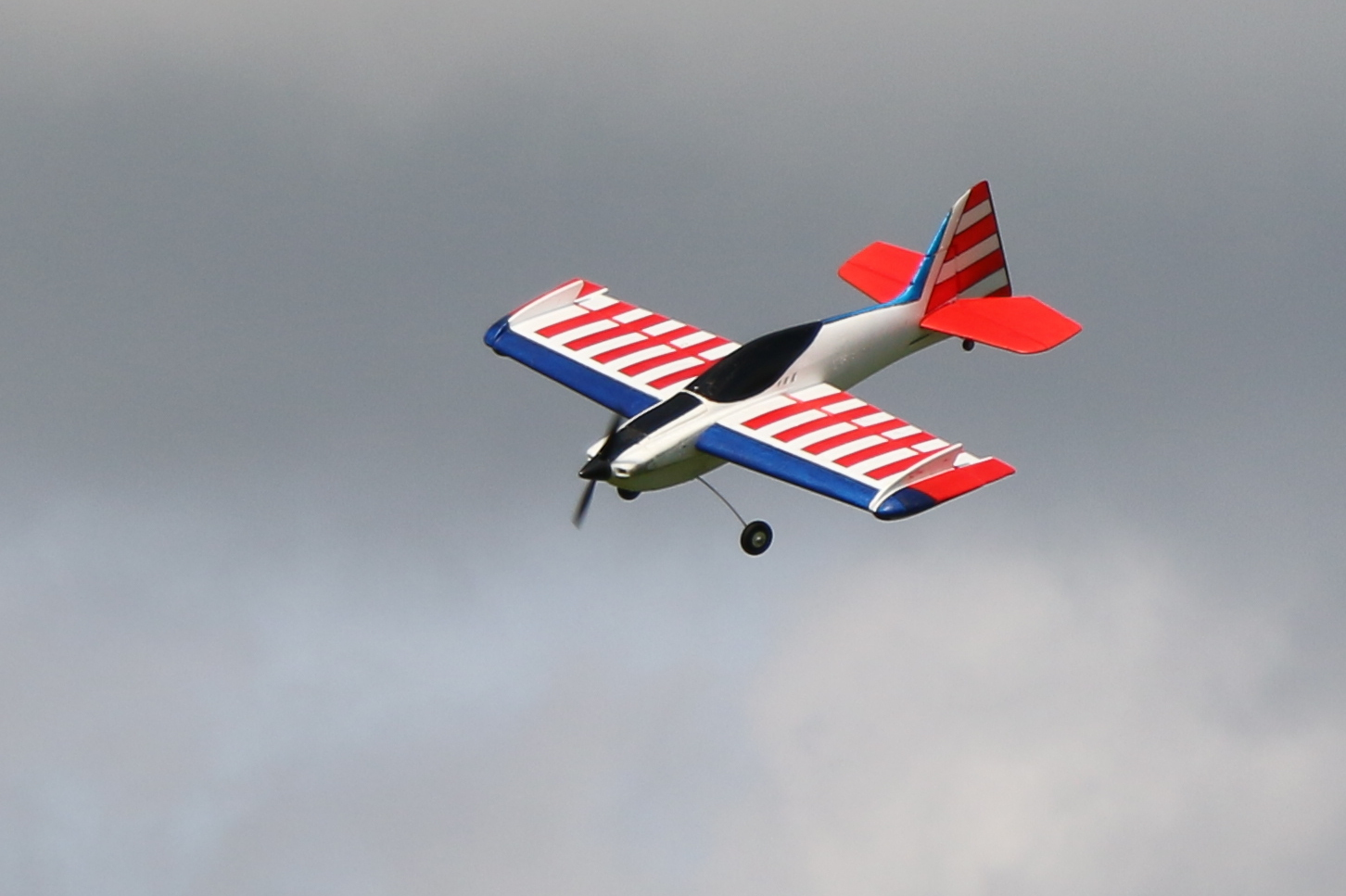
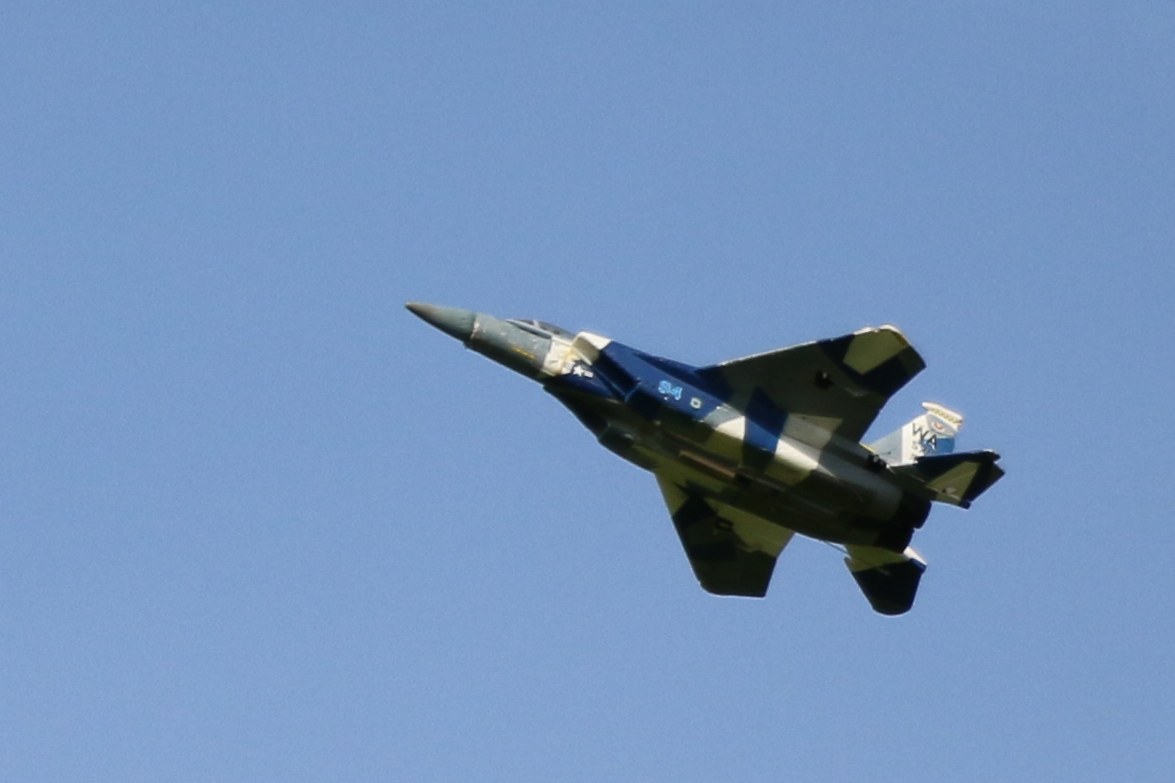
Video time now this month with footage taken by me, MacFly, and Dougal Entendre. Please watch the video full screen, it’s so much better with small models flying around:If the video won’t play for you please click HERE
Shortly after VE day, 8 May 1945, an Avro Anson pilot was instructed to fly some high ranking officials, including ‘shinies’ of brigadier rank and above, to an airfield in Berlin.
He was flying from England, and as fuel was limited to the exact gallon, he made a careful note of the fuel required. In this case it required almost full tanks to get there and would allow for a straight in approach when they reached the airfield. So, flight planned, he checked the weather report, which indicated slight chance of fog, and set off for Berlin.
To conserve fuel, careful engine management was vital. Upon approaching the border of Germany he radioed to the airfield met office and asked for the weather report. The operator indicated he was covering for the officer in charge, and read out the airfield weather report. As the pilot approached Berlin airspace he could see fog but no airfield. So he descended with caution and asked the controller to talk him in. He wound down the landing gear, deployed landing flaps, and heard the ATC’s last comment, ‘good luck’.
The instructions however, were not precise enough and he spotted the airfield lights away at 10 o’clock position. Realising the fuel gauges needles were all on empty he slammed the throttle and pulled the Anson round hard. Under the sudden change of direction he heard the groans from the Anson’s airframe, and also from the ‘shinies’ in the back. The aircraft was pulled around – no time to line up – just plant the wheels and line up after. About ten feet before the wheels touched down both the engines cut out.
In his pilot’s log he wrote: ‘Engines cut on approach – shinies spilled soup on uniforms – had to be towed off runway…”
As soon the aircraft halted, the pilot and all the shinies stormed off to the met office, to interrogate the officer in charge. What they found was an erk covering, who had no knowledge of met operations, and who hadn’t even looked out of the window to warn aircraft of the fog, he was simply reading the weather report from the local newspaper.
The moral of the tale: Aways look out the window when reporting the local weather – never use the Berlin Times printed the day before.
Colin Cowplain
Patch News – March 2024
It’s April already and we’re rushing towards those lovely balmy summer days that are ideal for model flying…well hopefully anyway. March wasn’t too bad at all, as expected for this time of year there was a mixture of good and bad weather but some of the days were just about perfect for us and we had some good turnouts at the field. A few of us flew on 3rd March which was a glorious calm day but there was mist laying in the valleys and we needed to be careful as it sometimes blew up across the field. These two photos were taken about fifteen minutes apart, the first one with my Riot ready to take-off, I’m glad I waited!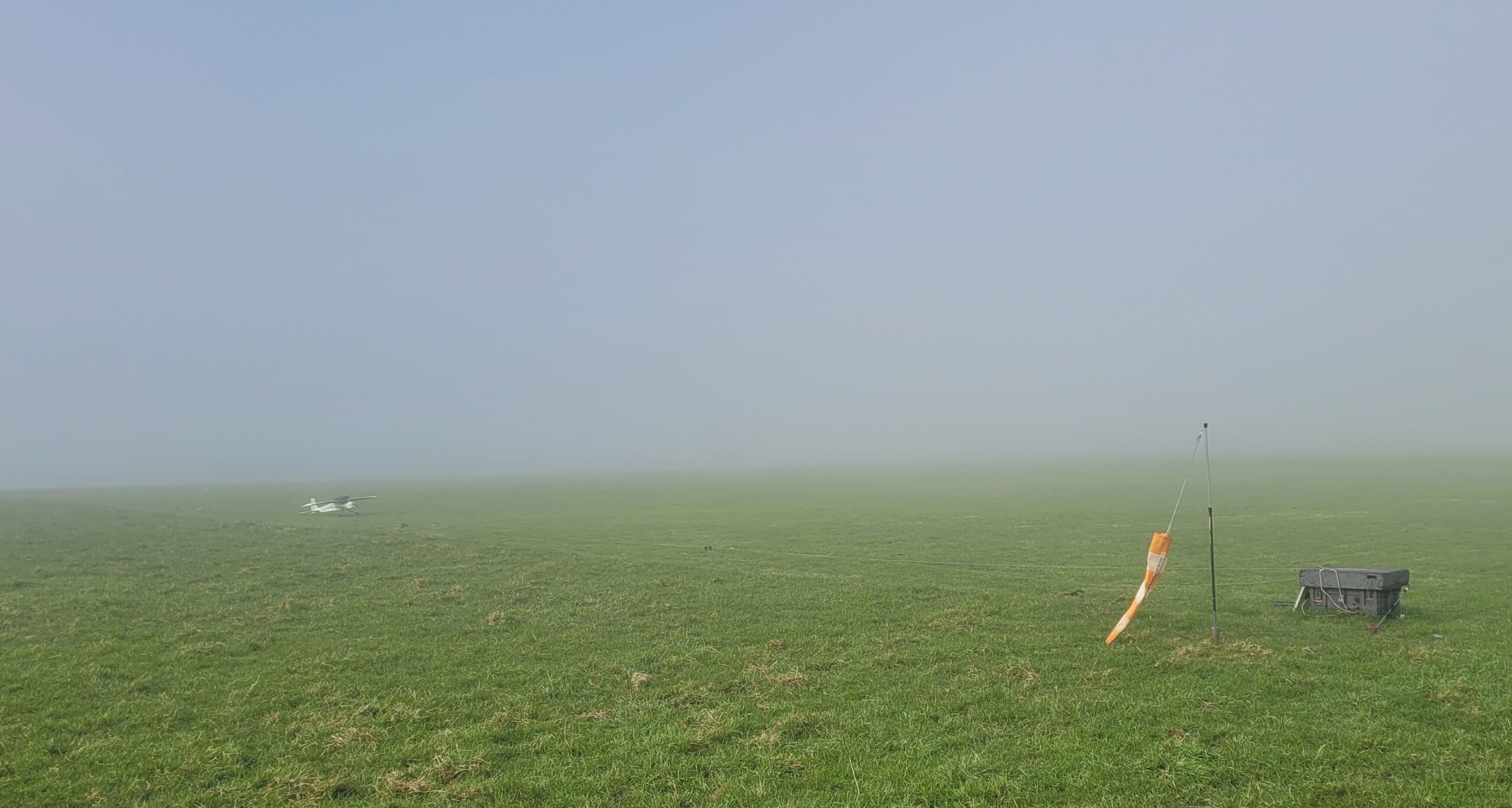
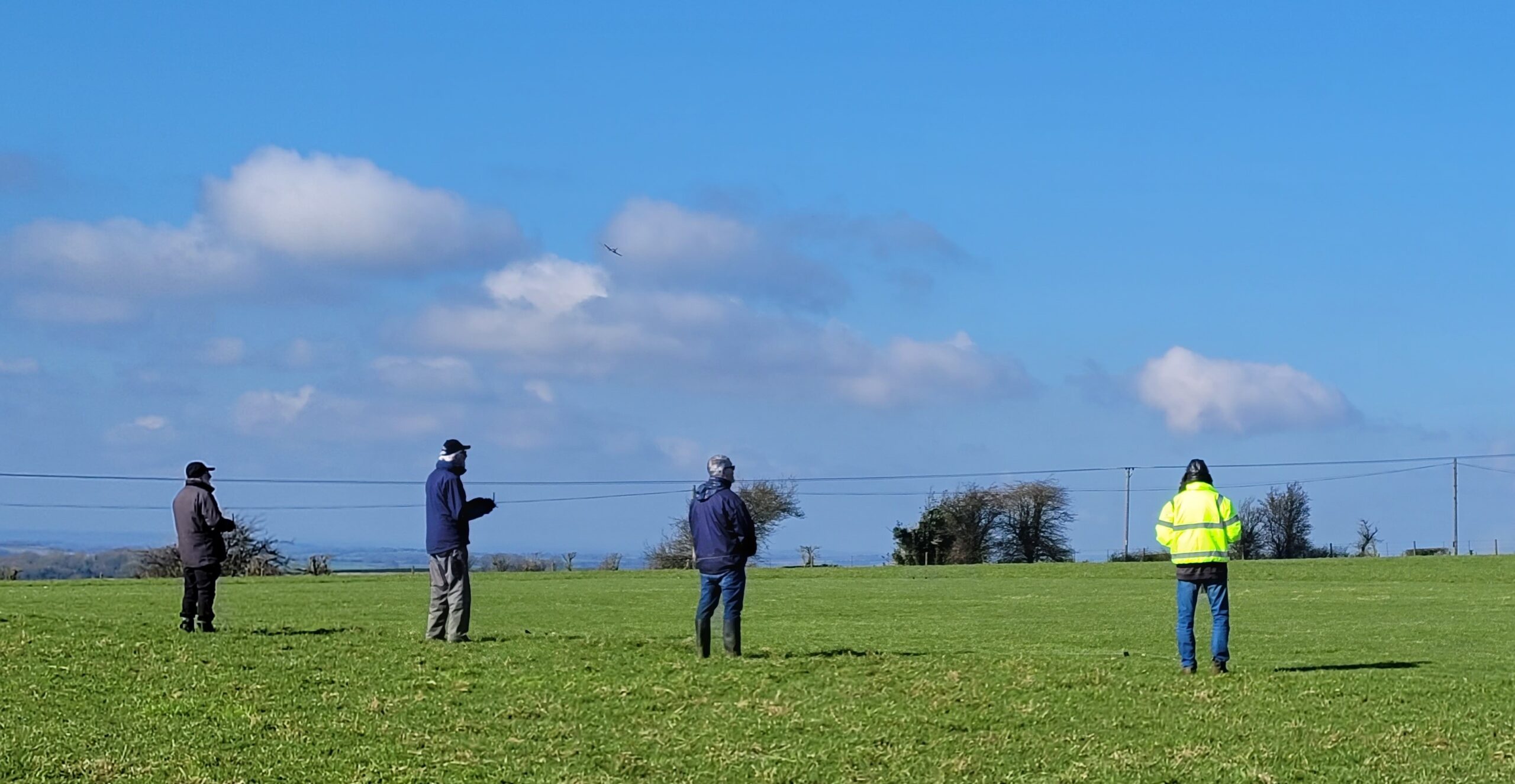 It would probably have been a great morning for FPV flying with some excellent opportunities for a bit of cloud hopping but sadly I hadn’t taken my FPV plane with me.
It would probably have been a great morning for FPV flying with some excellent opportunities for a bit of cloud hopping but sadly I hadn’t taken my FPV plane with me.
Never mind there were some lovely views from our field especially towards Butser hill.
I mentioned last month that the parking area was extremely muddy and was causing a few problems with people getting stuck as well as being very mucky underfoot. Chairman Gordon Bennett said he’d have a word with the farmer to see if anything could be done and right on cue Olly (or was it Will?) visited us at the patch to see how we were getting on. When we mentioned the parking area he said they had lots of wood chippings that they could put down for us. Sure enough a few days later one of the farm hands brought three large trailer loads of chippings up and spread them over the worst areas for us.

It’s not perfect, some hard-core would have been even better, but the wood chips have improved it no end and things should get much better as the weather improves.
One midweek morning early in the month Gordon, Woody, and I turned up hoping to fly but there was a strong easterly wind blowing and some of the MVSA (Meon Valley Soaring Association) members were flying. The farmer had asked them to park in ‘our’ newly wood chipped area as their usual place further along the track was waterlogged. Rather than fly from their usual slope they were using the one much closer to us, pretty much straight in front of the masts but well forward. We didn’t fly as the wind was so strong but had we chosen to they wouldn’t have been a problem, they were still well out of our way. We spent some time chatting to the MVSA guys and then made use of our time by mowing the patch.
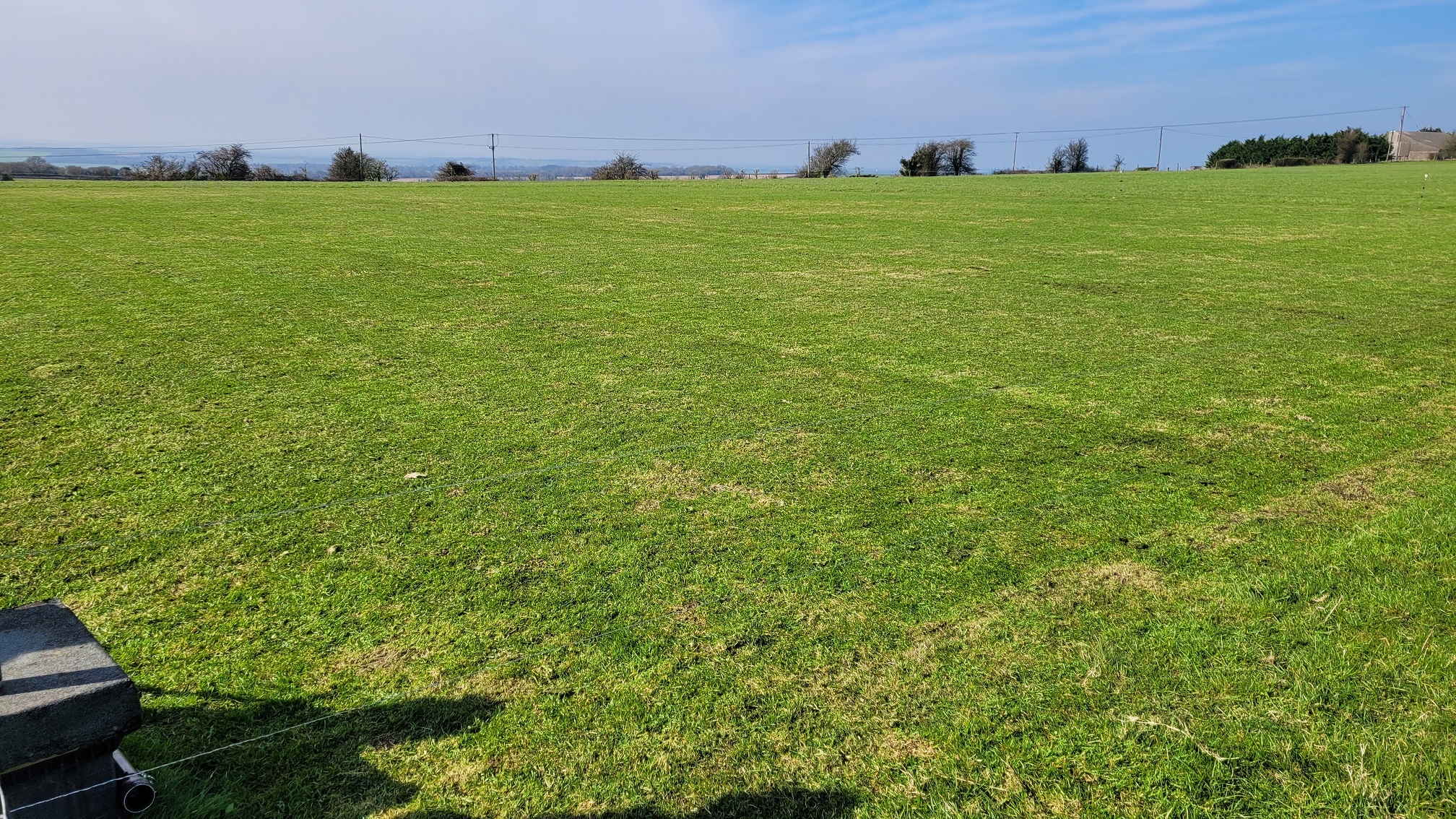 It was good to chat to some fellow aviation enthusiasts, the ones we spoke to were all very friendly and weren’t at all bothered that our new field is much closer to them than before.
It was good to chat to some fellow aviation enthusiasts, the ones we spoke to were all very friendly and weren’t at all bothered that our new field is much closer to them than before.
I managed to have few FPV flights later in the month and had the on-board video camera running as usual. There wasn’t anything special to include in this month’s video but here are some stills taken from the videos. We flew on Saturday 30th March rather than the Sunday as the weather looked better and found that the metal detectorists of the Hayling Detect club were out in force. There were so many cars present that some of them had to park in the top of our field, as did we, but that was fine and didn’t cause any problems.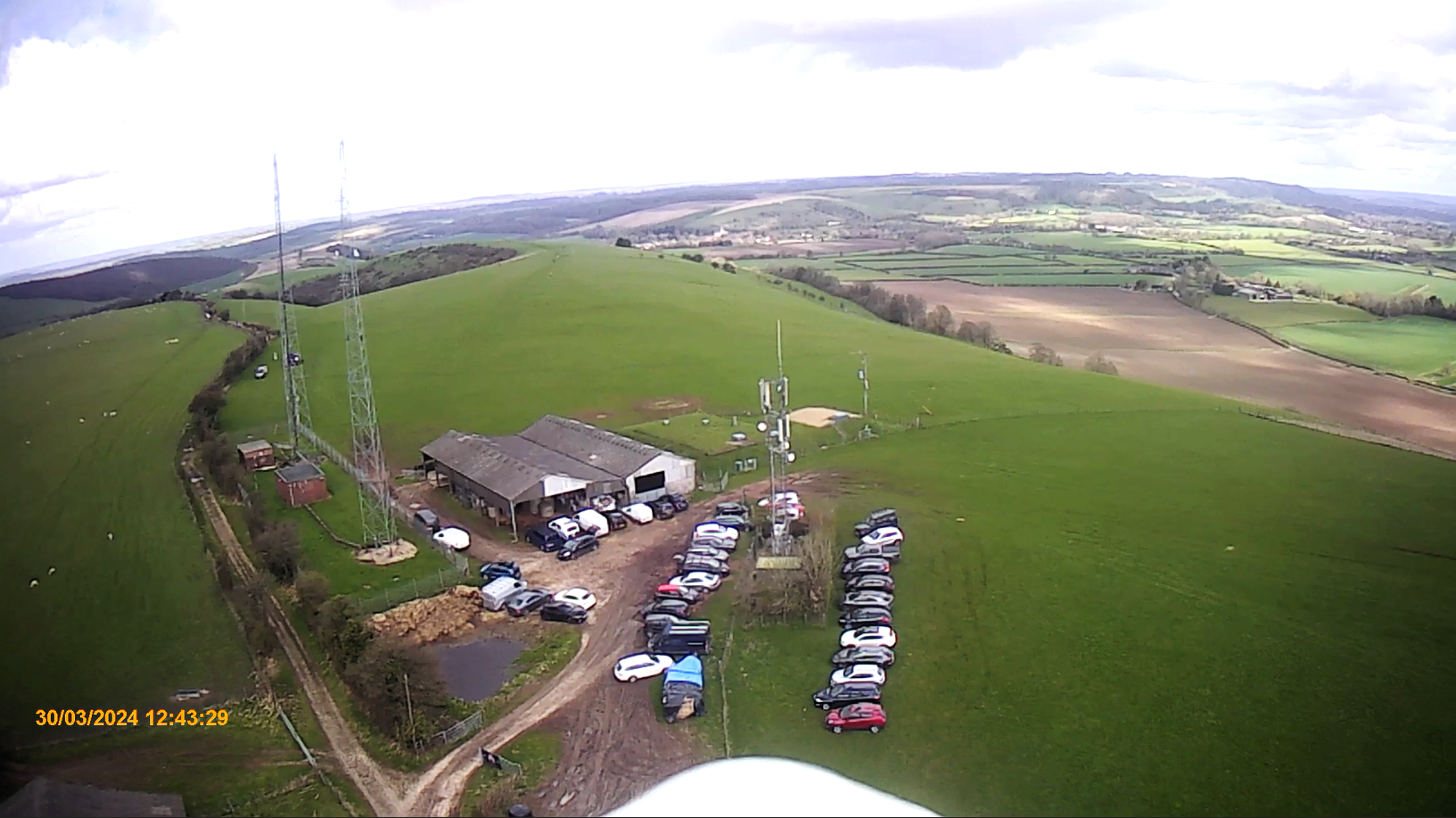
The gap between the trees that we sometimes fly through when landing looks pretty big on FPV, much wider than it seems when landing normally. That’s not to say I won’t hit them!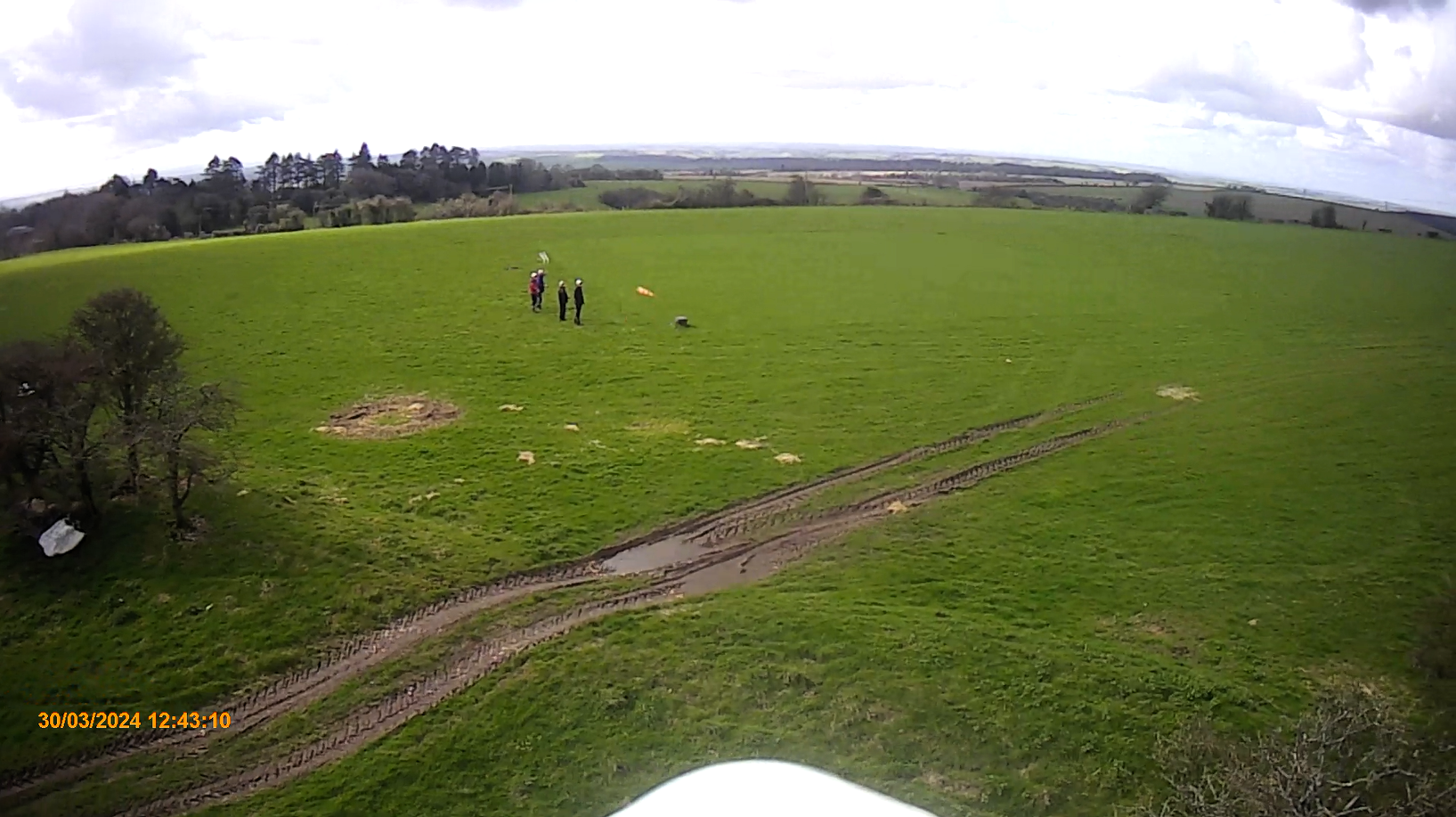
Basher Bob (Bob the Builder) shot past me rather too close for comfort during one flight!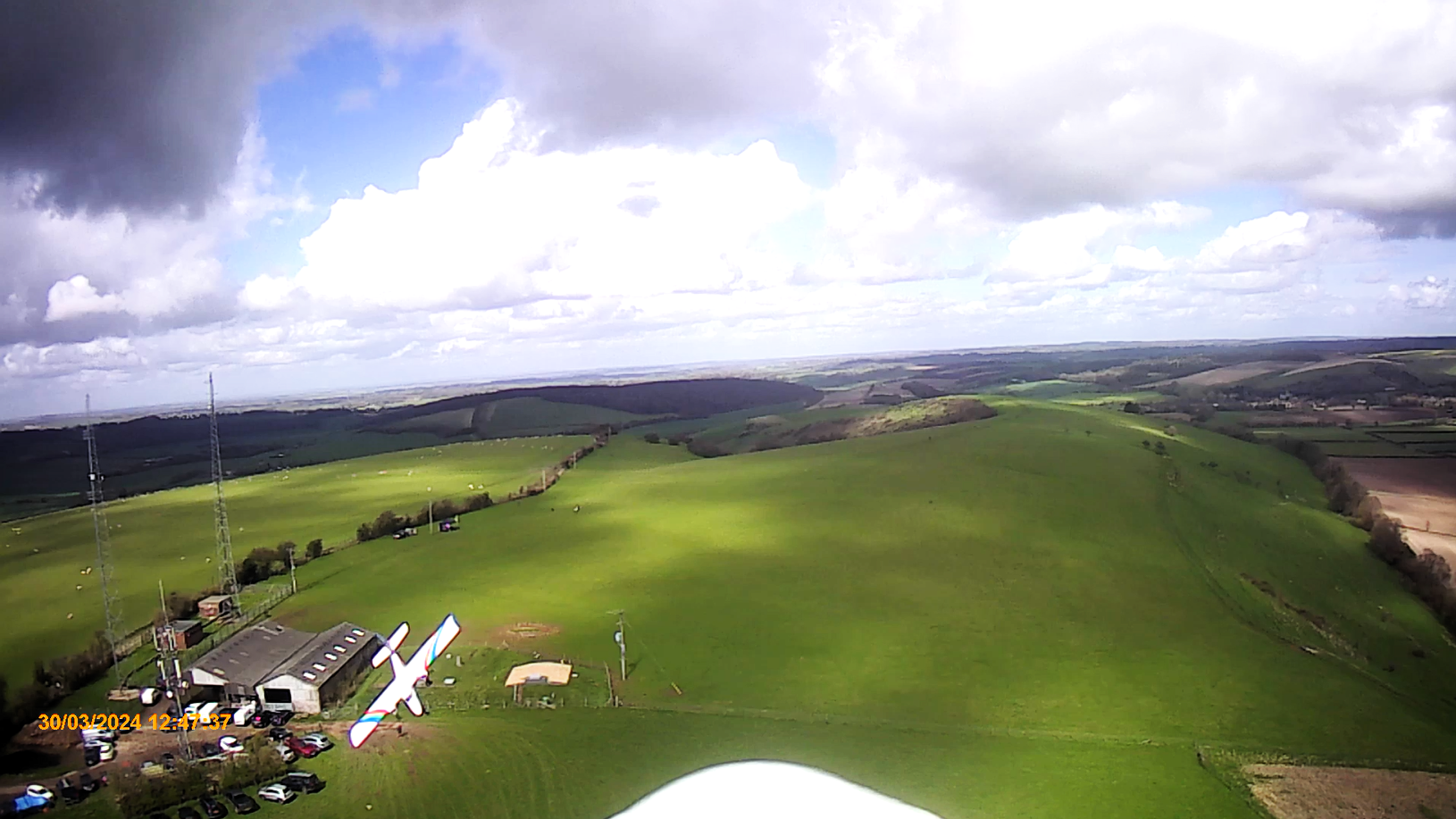
And Dougal Entendre had a similar ‘moment’ with Page Boy’s Wasp pylon racer!
1066 flew a new (to him) model at the end of the month, a Visionaire that he’d bought from Rod Ashton. I’m not sure if Rod had bought it new or had even ever flown it, maybe he also bought it second-hand and sold it on. According to 1066 is was a bit tatty when he got it so he tried touching up the paint in places but it all went a bit wrong. I think he must mean the black on the canopy and in front of the cockpit but it doesn’t look too bad to me. 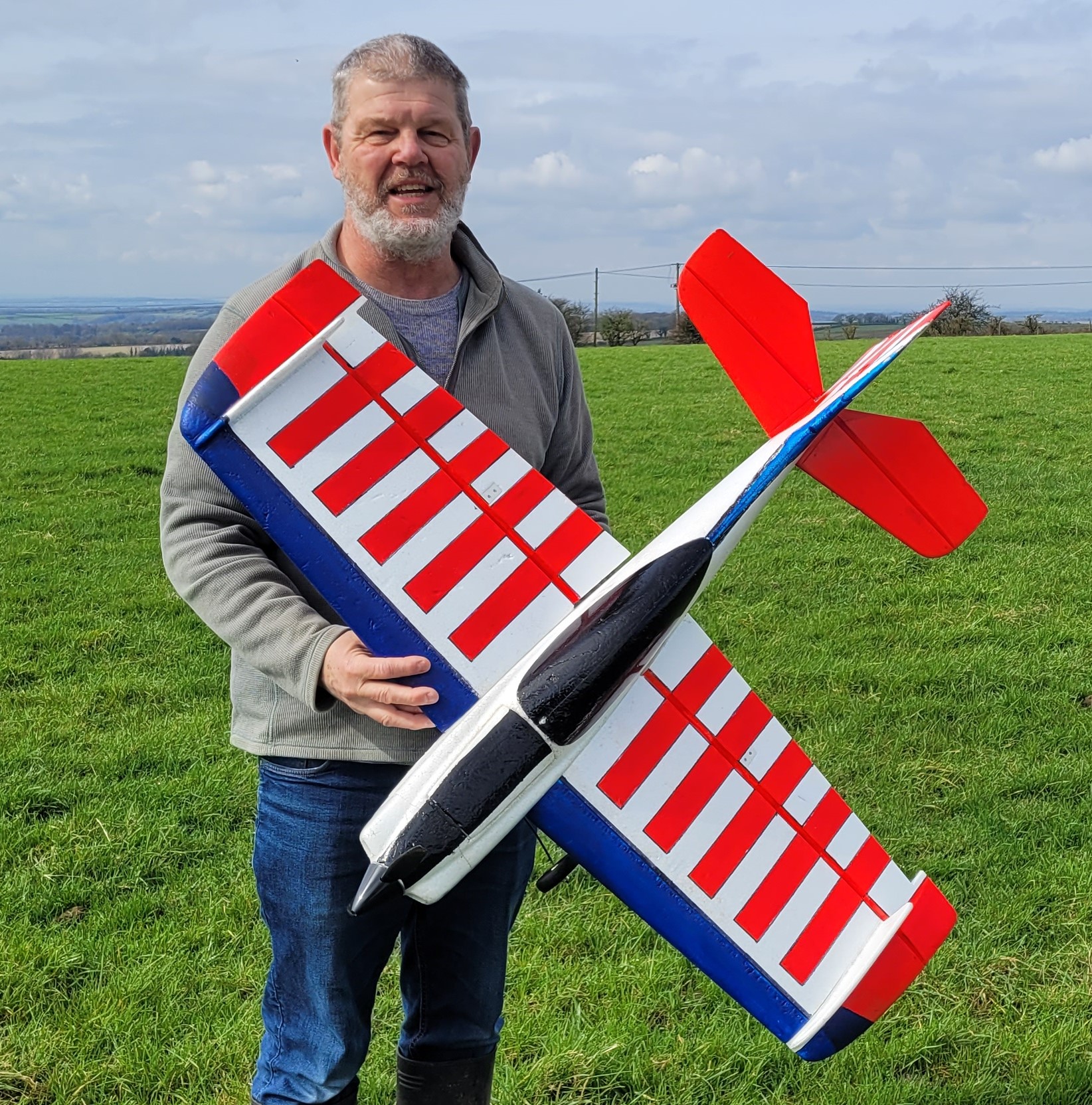 I asked for info on the Visionaire and 1066 said it’s all stock apart from coming without a receiver. From new the plane comes with an AR636A six channel Spektrum receiver that has a built stabiliser, this is how Spektrum describe it: SAFE (Sensor Assisted Flight Envelope) technology is a revolutionary electronic flight envelope protection system that delivers a virtual safety net. Anytime you need to instantly recover back to level flight, just press the Panic Recovery Mode button or switch on your transmitter. Several club members have models with the SAFE system and it generally seems to work well but as this one came without a receiver 1066 will have to rely on flying it properly himself.
I asked for info on the Visionaire and 1066 said it’s all stock apart from coming without a receiver. From new the plane comes with an AR636A six channel Spektrum receiver that has a built stabiliser, this is how Spektrum describe it: SAFE (Sensor Assisted Flight Envelope) technology is a revolutionary electronic flight envelope protection system that delivers a virtual safety net. Anytime you need to instantly recover back to level flight, just press the Panic Recovery Mode button or switch on your transmitter. Several club members have models with the SAFE system and it generally seems to work well but as this one came without a receiver 1066 will have to rely on flying it properly himself.
 The Visionaire has a wingspan of 1143mm (43”) and is made of foam with carbon reinforcements in the structural areas. The brushless motor is a BL 10 1250KV which is linked to a 40-Amp Lite Pro Switch-Mode BEC Brushless ESC and spins a 12×4 propeller.
The Visionaire has a wingspan of 1143mm (43”) and is made of foam with carbon reinforcements in the structural areas. The brushless motor is a BL 10 1250KV which is linked to a 40-Amp Lite Pro Switch-Mode BEC Brushless ESC and spins a 12×4 propeller. The model comes ready fitted with four 13g servos which are high speed digitals and the recommended battery is a three cell 2200mAh lipo. The Visionaire was discontinued a few years as was the Night Visionaire that came with a High-intensity internal LED lighting system already installed. I’ve been searching the net for information on the Visionaire and it appears that it was originally a Parkzone model and E-flite only sold the Night Visionaire. I think Parkzone and E-flite are both names that are owned by Horizon Hobby and they’ve now stopped using the Parkzone name, just using E-flite for all their models.
The model comes ready fitted with four 13g servos which are high speed digitals and the recommended battery is a three cell 2200mAh lipo. The Visionaire was discontinued a few years as was the Night Visionaire that came with a High-intensity internal LED lighting system already installed. I’ve been searching the net for information on the Visionaire and it appears that it was originally a Parkzone model and E-flite only sold the Night Visionaire. I think Parkzone and E-flite are both names that are owned by Horizon Hobby and they’ve now stopped using the Parkzone name, just using E-flite for all their models.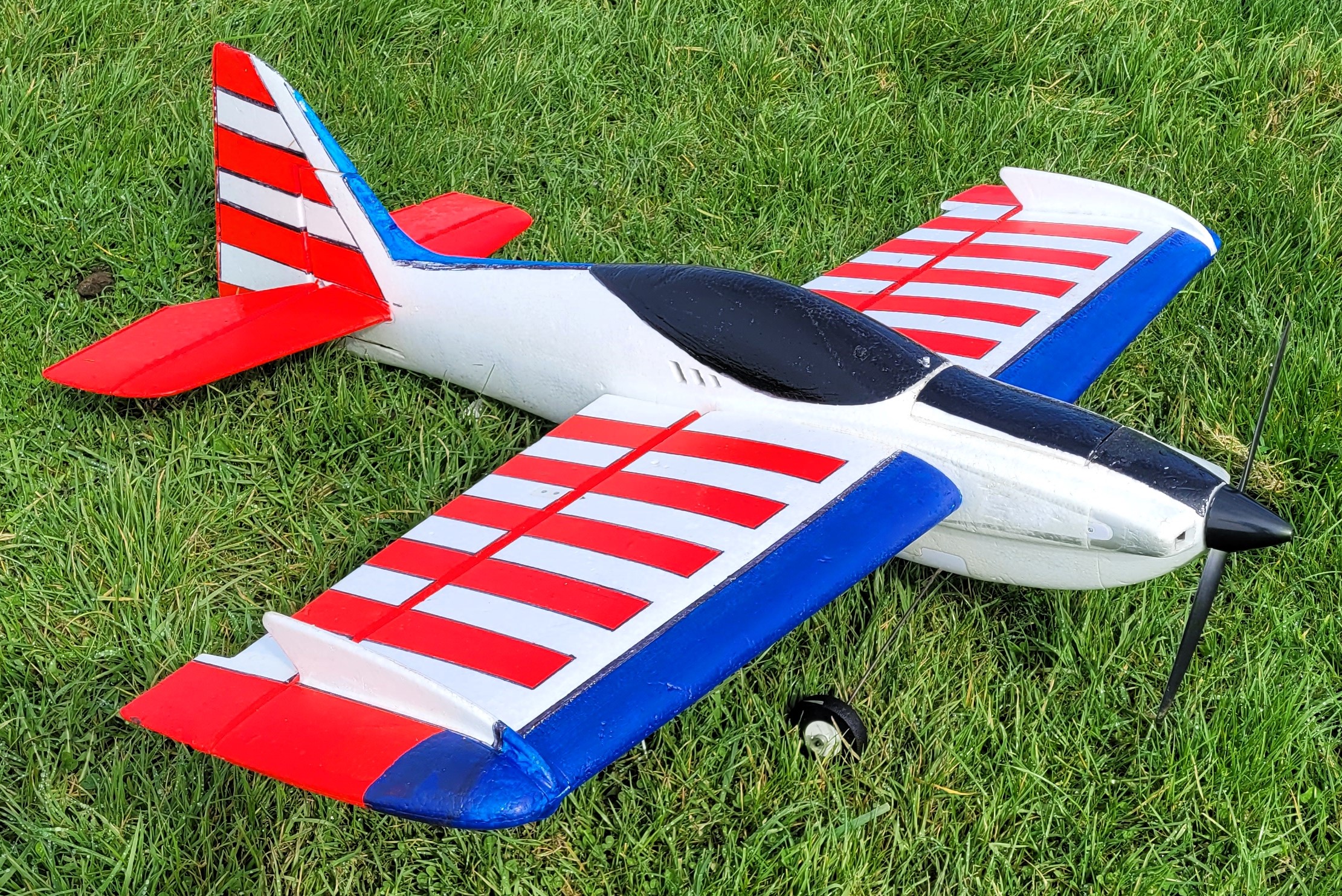
To confuse things even more I have founds loads of photos of both Visionaires and Night Visionaires and not one of them has the same colour scheme as 1066’s model. Enough of that, all you really want to know is how does it fly? Well at the time of writing 1066 has only given it one outing but it looked very good to me. It appeared to do everything the usual 3D planes do but it seemed to be especially good at doing things slowly. Maybe that will mean it’s not so good on the windier days, we’ll have to wait and see. But in the meantime take a look at this month’s video where you can see it in action.
On the 1st of the month we were amazed to see an Avro Lancaster approaching the field, very low. We weren’t sure what it was doing, possibly using the radar mast on Butser to line up for a Goodwood approach. We all waved like mad but saw no response from the pilot although I think he must have seen us, maybe he was simply too aloof to bother with us. It circled round several times and on the fourth pass I snapped this rather blurry shot.
With a lack of new models being flown in March I’ll have to resort to writing about some that I’ve featured before. We’ve seen very little of Page Boy recently, he was lured away to another club for a while but he soon realised they weren’t nearly as insulting fun as us at PAM so he re-joined us last year. He’s been busy with life in general and hardly managed to fly at all last year, just once in August I believe, and he took the winter off, couldn’t cope with the cold apparently, wimp! But in March he re-emerged from hibernation and gently eased himself back into flying with a pylon racer, his Wasp E2K. Despite choosing Gordon Bennett to chuck the Wasp the flight went well and he soon remembered how to fly.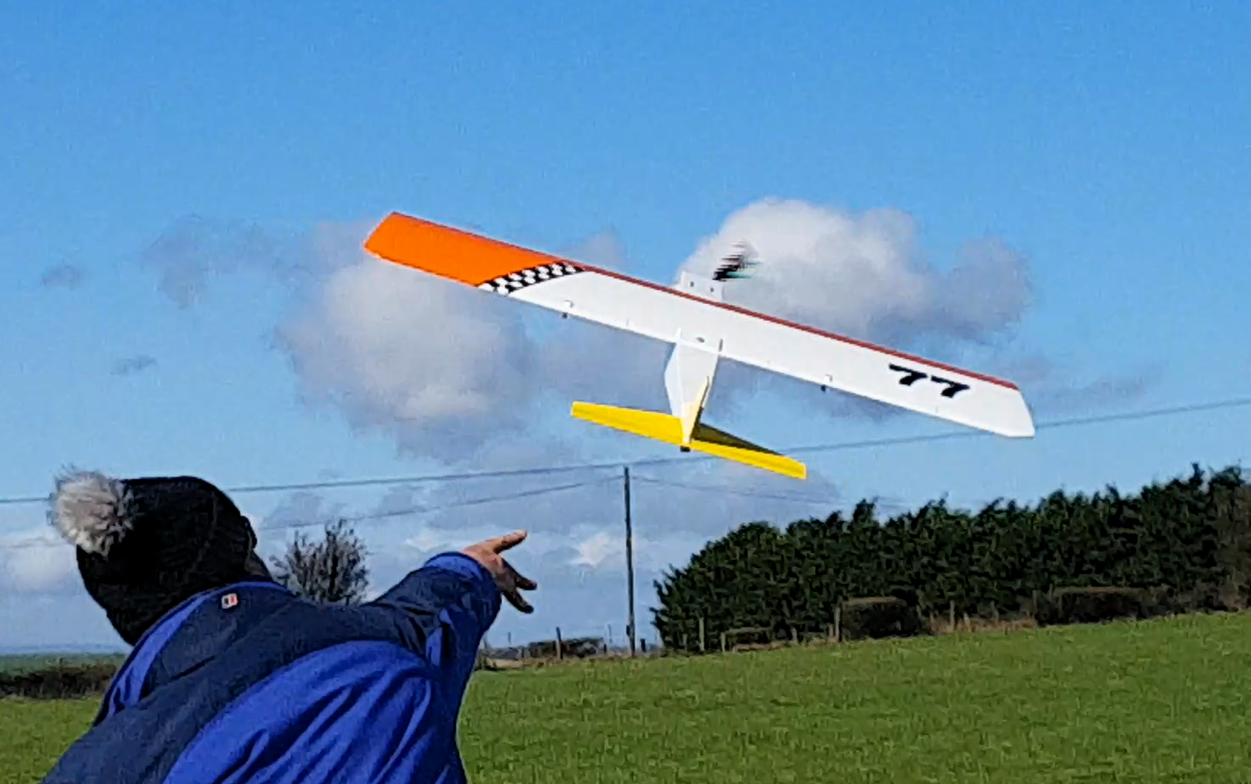
1066 thought there was a serious problem as the motor only seemed to run at full power for a couple of seconds or so before cutting back to around half power. But there was nothing wrong 1066, it’s called ‘throttling back’, it’s controlled by the left hand stick!

 By the end of the morning Page Boy had had several flights with the Wasp, the only problem being that despite our new field having a patch over twice the size of the previous one he couldn’t hit it! Never mind, it’s good to have you back Page Boy.
By the end of the morning Page Boy had had several flights with the Wasp, the only problem being that despite our new field having a patch over twice the size of the previous one he couldn’t hit it! Never mind, it’s good to have you back Page Boy.
In the February Patch News I wrote about Mini-Mike’s marvellous Mirus, a design that was first kitted back in the early eighties for IC engines (how quaint, remember those?) but of course Mini-Mike has built his to be powered by a lovely brushless electric motor.
He is using the same power set-up as Page Boy’s Wasp E2K, a Thumper 3536 1500Kv powered by a three cell 2200mAh lipo but rather strangely whereas Page Boy’s Wasp pulls 855w the Mirus is only pulling 615w. I’m not sure why there would be such a big difference and can only think it’s down to the batteries, maybe Mini Mike’s lipos have a lower C rating or are simply older and have degraded. I notice that the Mirus has a 50A speed controller against the Wasp’s 80A but I would have thought 50A would be more than enough. The only other thing could be the propeller, both models are using the same size but possibly not the same make, that can make quite a difference to the current draw.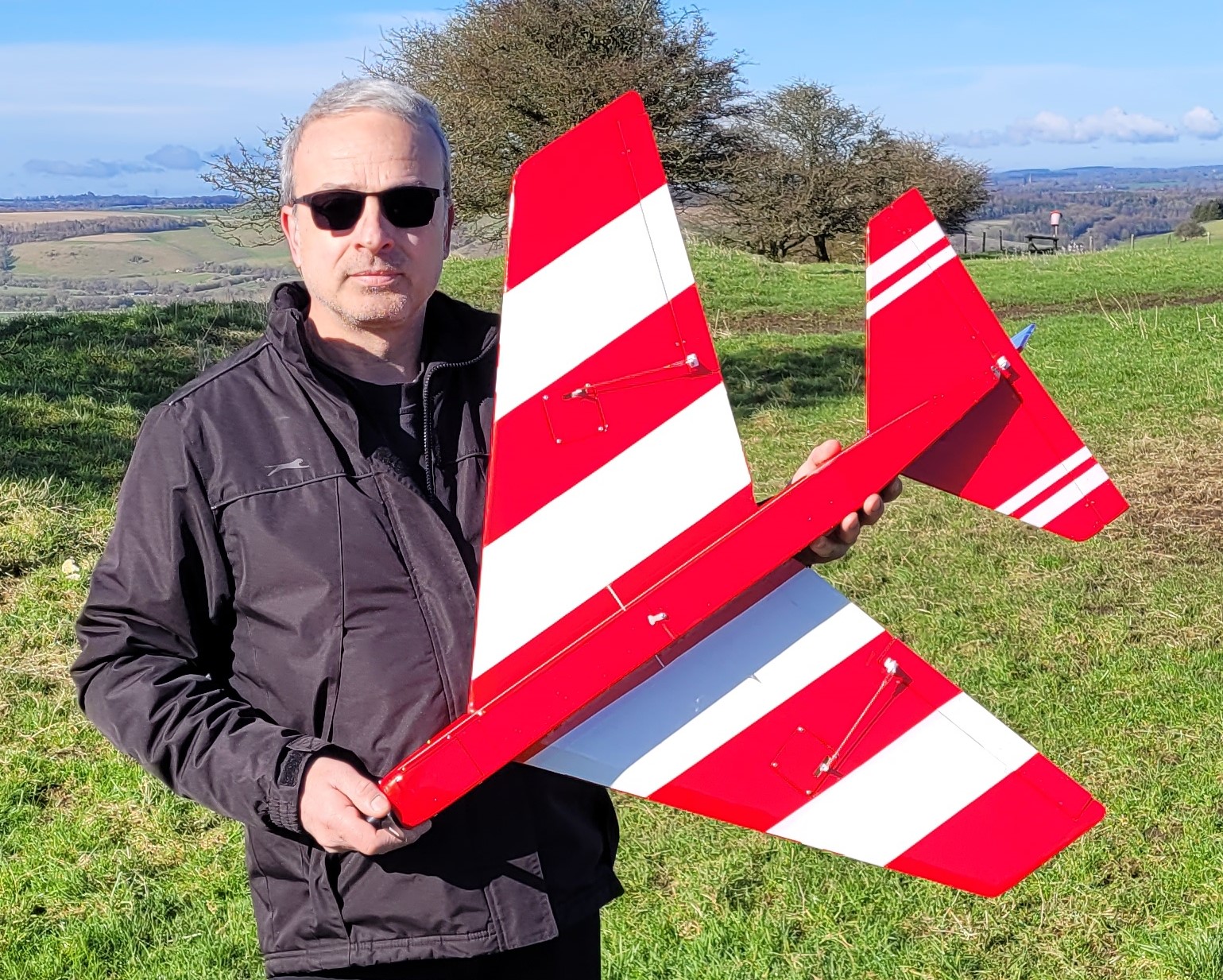
Even though it has less power than the Wasp the Mirus flew very nicely, plenty fast enough for the first few flights when Mini-Mike was getting used it and trimming it to fly as he likes. It’s slower than the Wasp but it’s a delta not a pylon racer so it’s bound to be slower, they are designed for different things. I thought it looked great in the air and 1066 was right back in reminiscing mode as he watched it. It’s in this month’s video so take a look.
Another model to re-emerge in March after a winter break was Woody’s Splot.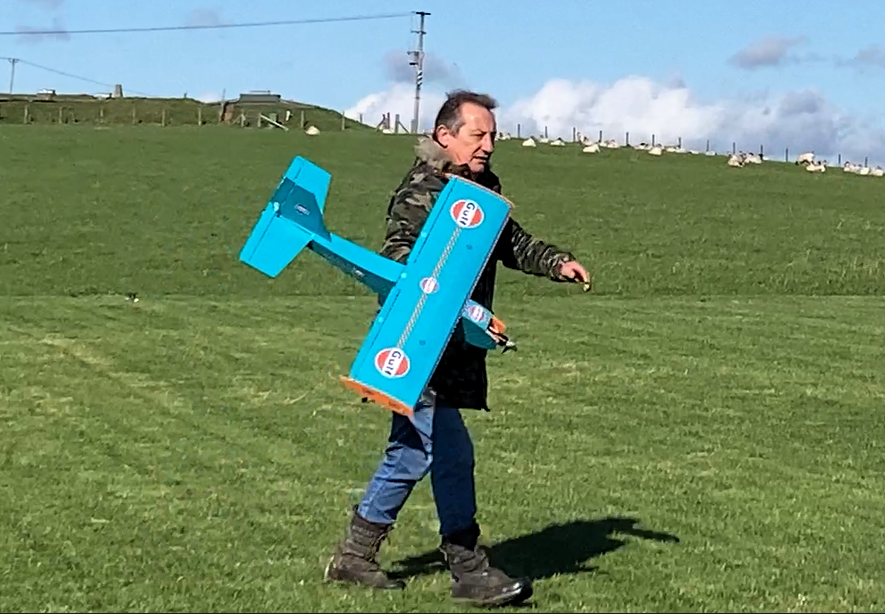
When the Splot first appeared last year it had a few problems and it took a while to work out that there was a wire chaffing inside the transmitter that was causing the rudder to move when the throttle was opened; that made for interesting take-offs! Having sorted that out things were much improved but flying it in early March Woody found the Splot still had a tendency to pull to the left if the throttle was opened too quickly.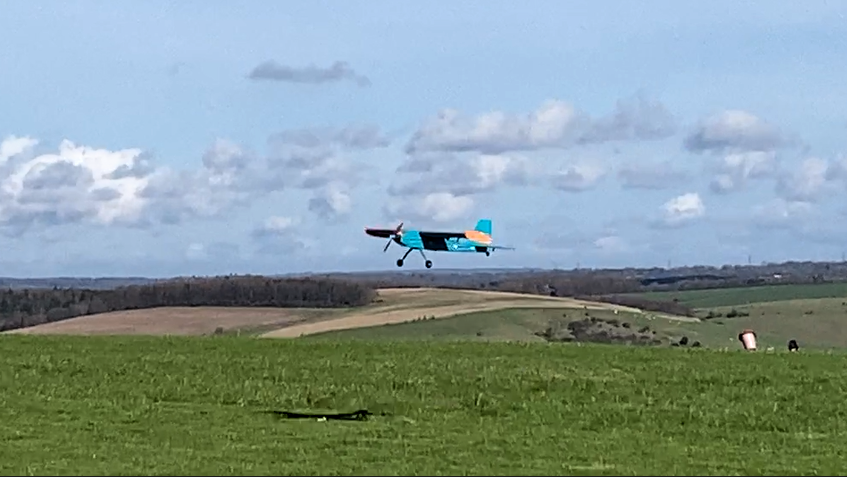
This was diagnosed as a lack of side-thrust so Woody added some washers behind the motor mounts to introduce some right thrust and bingo, the problem was solved.
Having several good days of weather meant it was possible for Kryten to take some decent shots of our planes in the air so here’s a selection of some of his excellent action photos: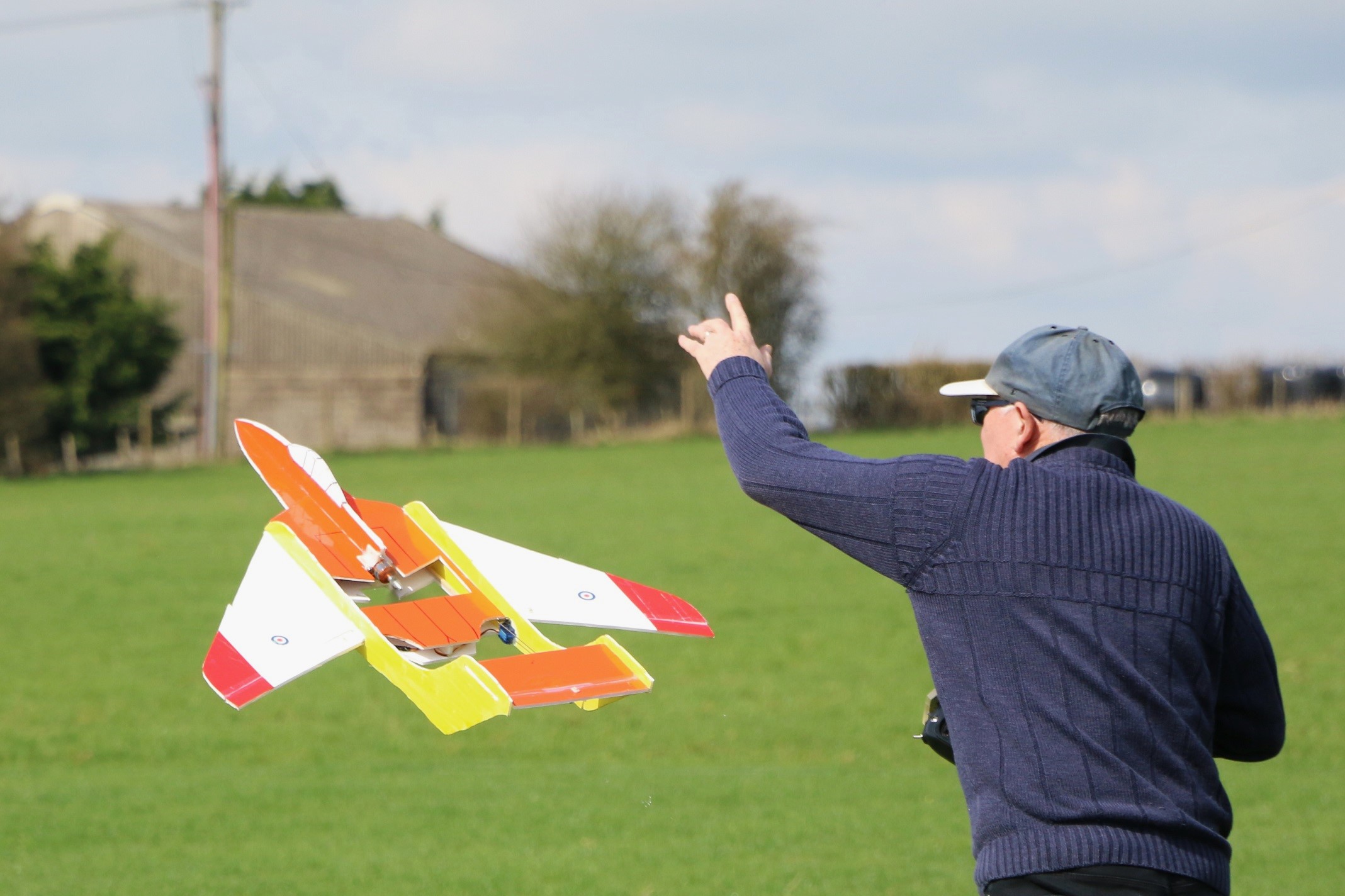
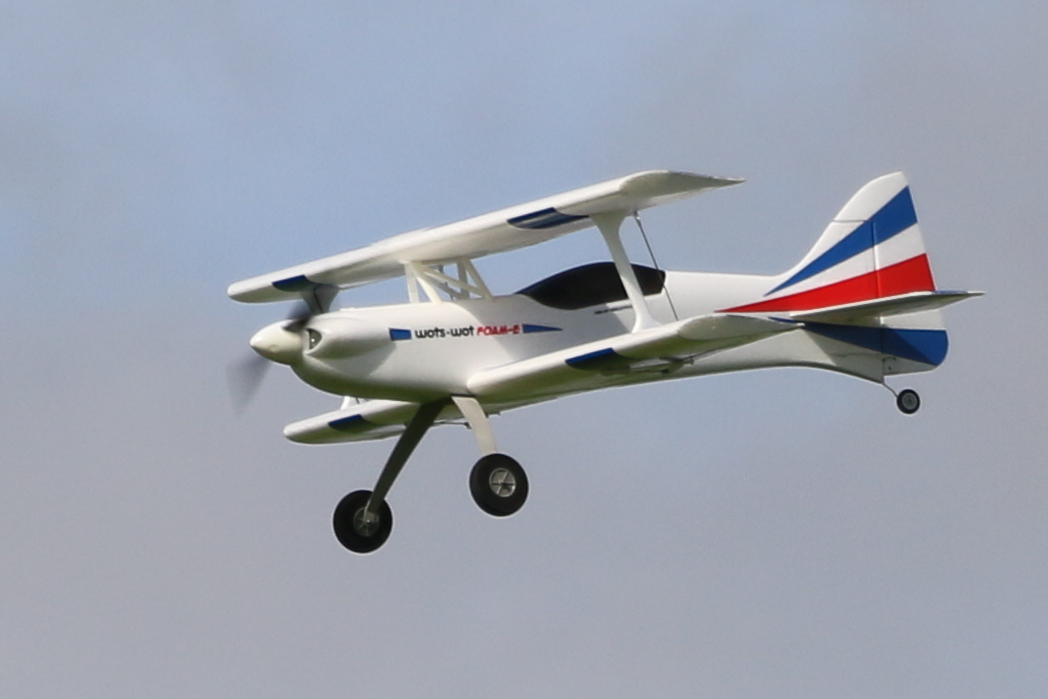



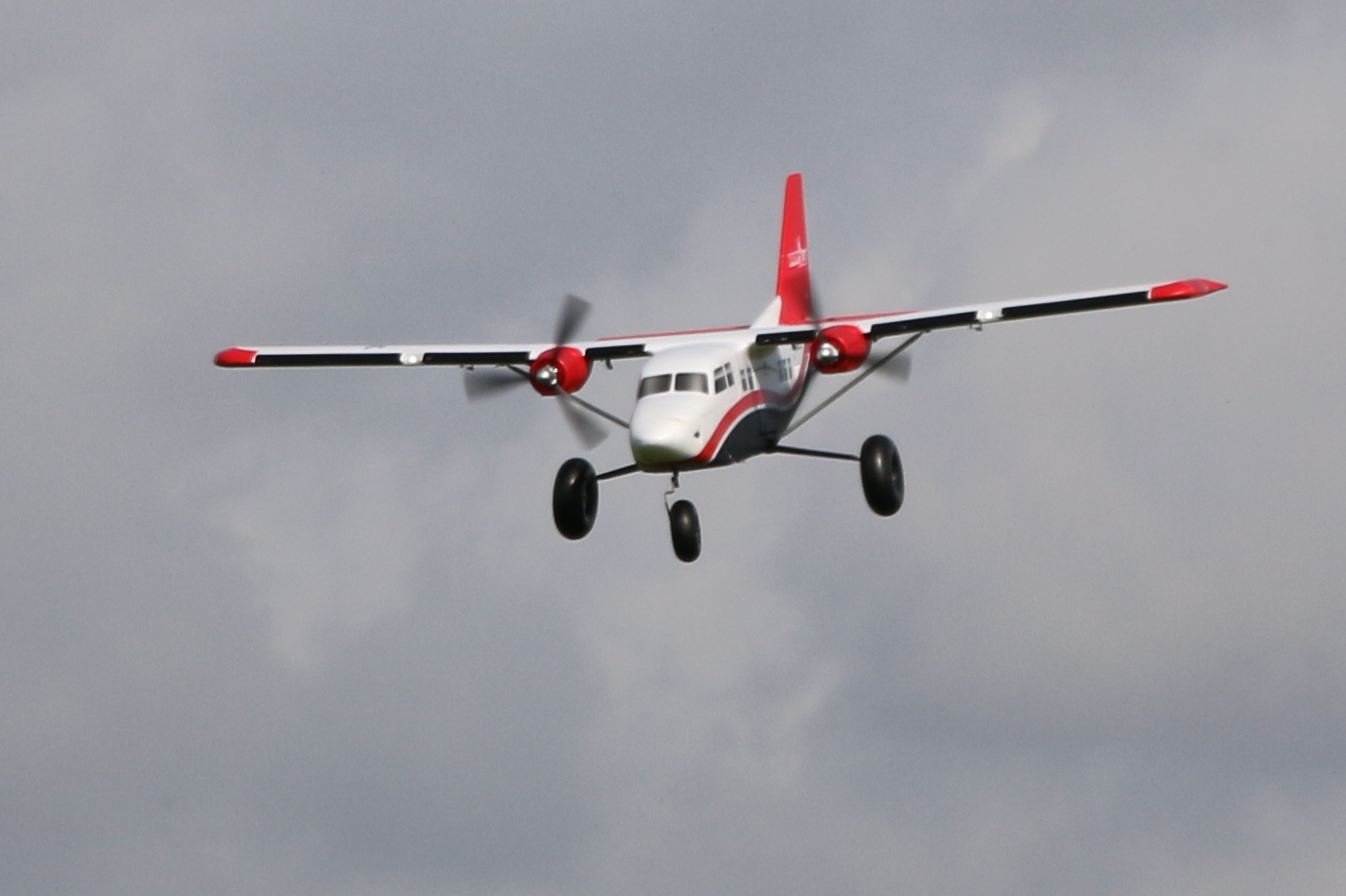
Video time now this month with footage taken by me, MacFly, and Dougal Entendre. Please watch the video full screen, it’s so much better with small models flying around:
If the video won’t play for you please click HERE
A few years ago at our Air Traffic Centre we received an early warning that an undisclosed number of US Air Force B2 Bombers would be crossing our FIR [Flight Information Region] at a particular time on a particular day.
They would check in with us as they entered our airspace and check out again as they left. We were told the call sign to expect, and, as the route was known, it was logical to assume that they would contact us at a certain time and at a certain place.
Being the then famous new ‘Stealth’ bombers we would know little about it but they would pay us the courtesy of letting us know when they were there.
Eric, a very capable controller with a keen sense of humour was on position, and heard, “UAE Area, this is USAFB2. This is a courtesy call advising that we are about to enter your airspace.”
Eric replied, “USAFB2, welcome to UAE Airspace, we have you on radar 200 miles out over LOTUS, hope you enjoy your visit.”
Without thinking the Stealth Bomber replied, “Thank you UAE, it a pleasure to be… Wait…what? You’ve got us on radar? 200 miles out? You must be kiddin’ me?”
“That’s affirmative USAFB2,” said Eric, “I’m kiddin’ you. Enjoy your visit.”
Colin Cowplain

